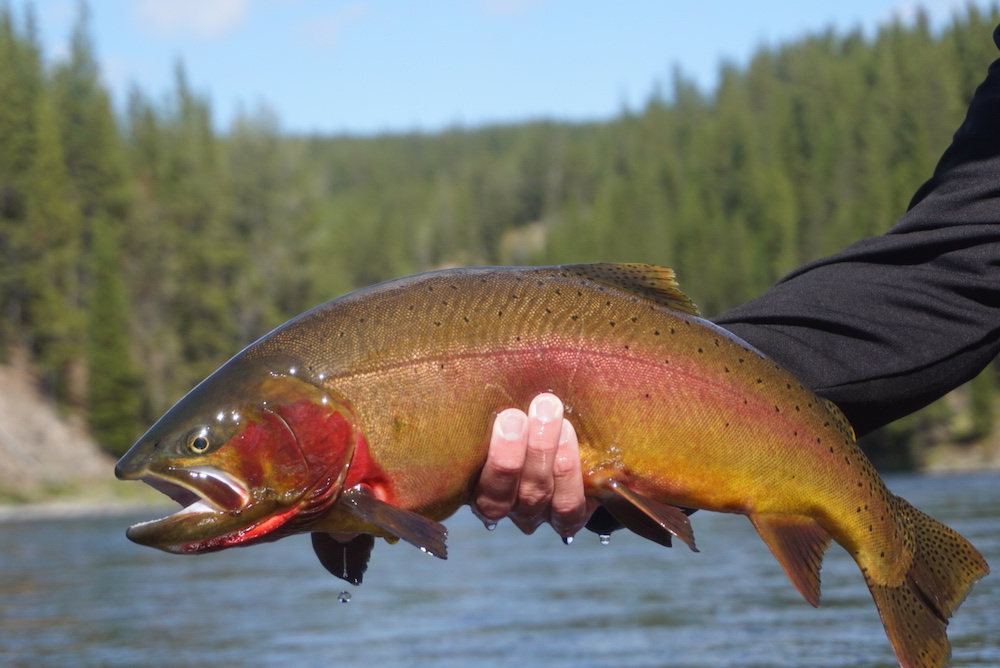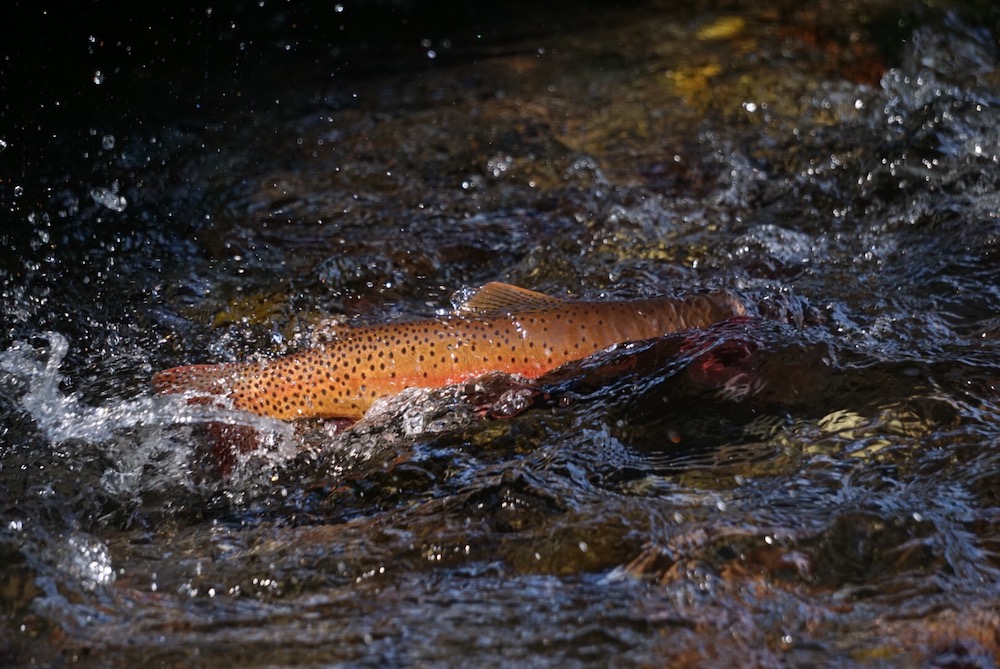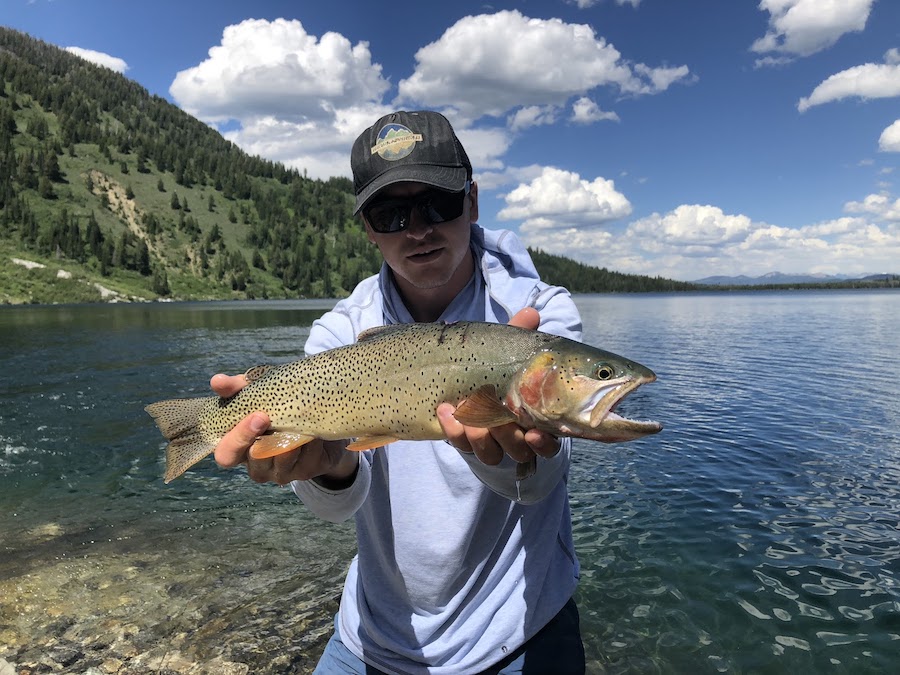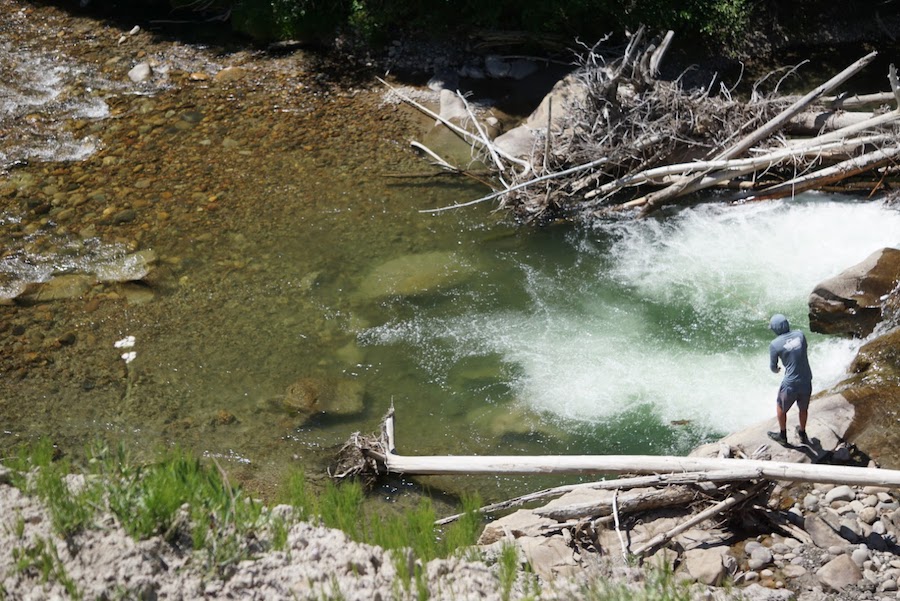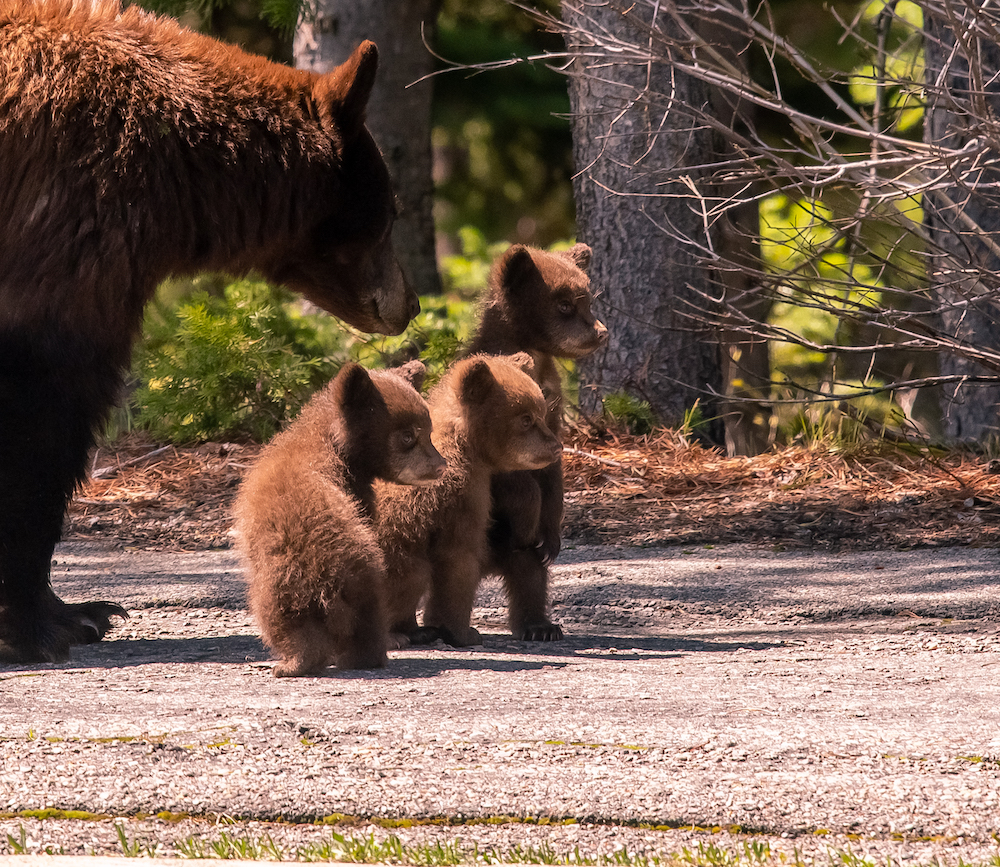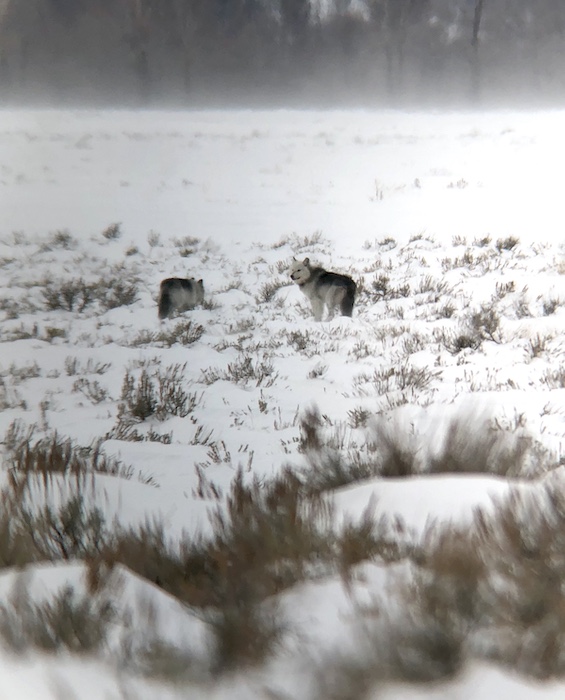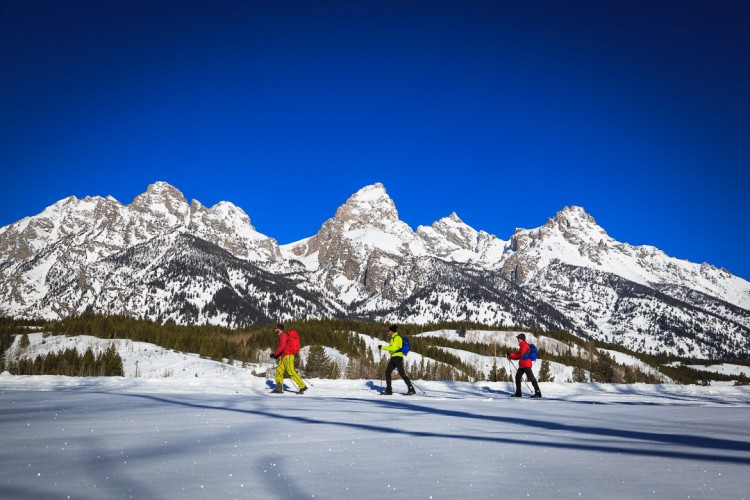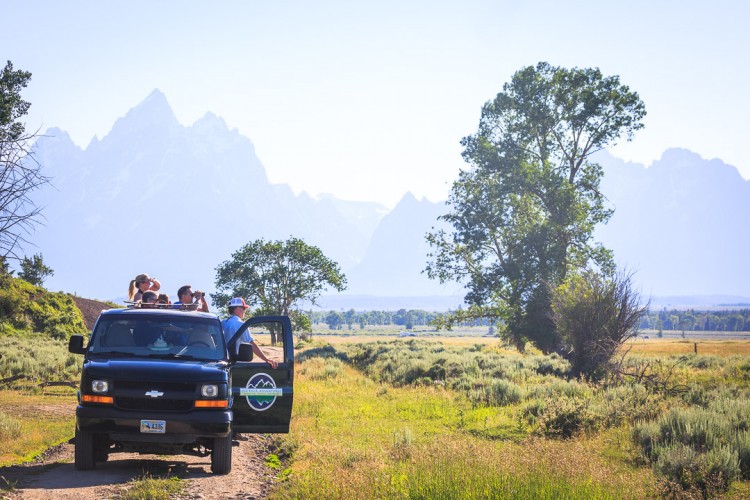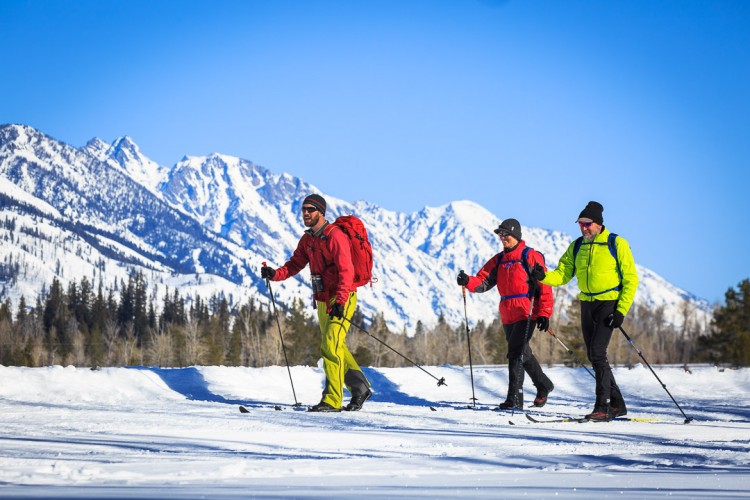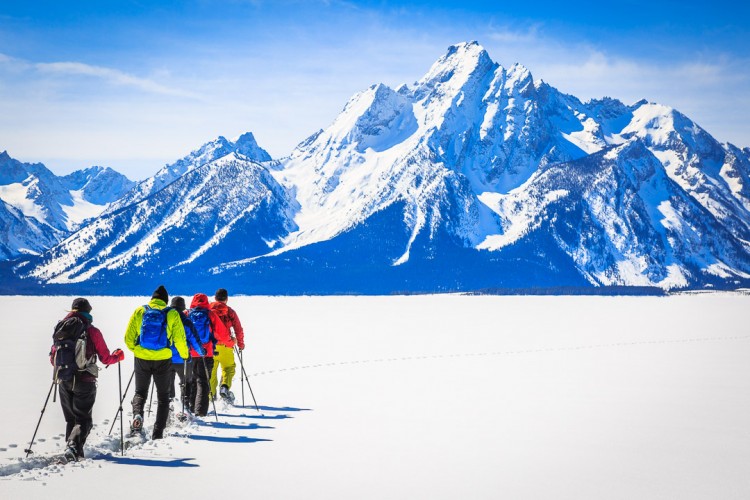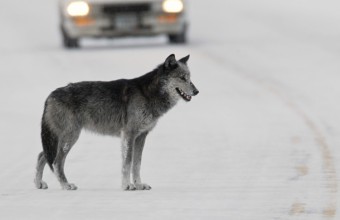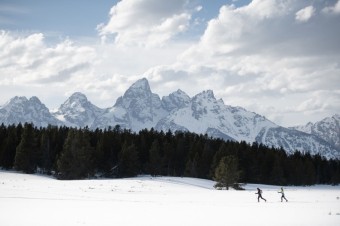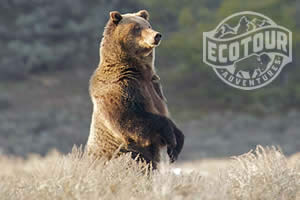
Respecting Wildlife in National Parks: How We Can All Be Stewards of the Land
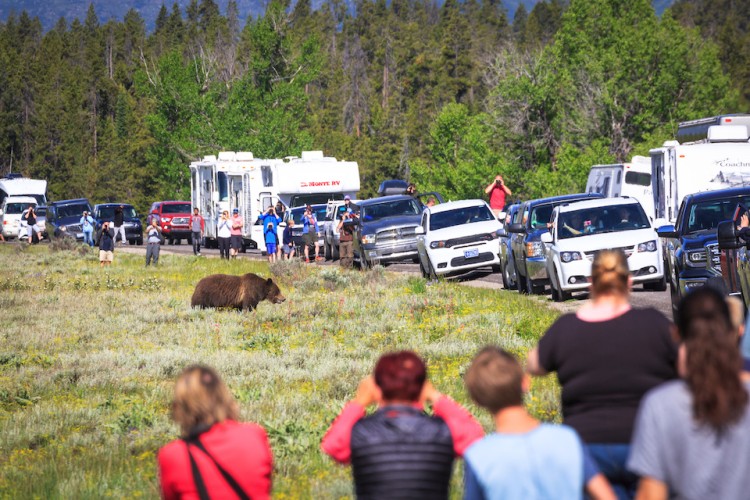
Experiencing Jackson Hole Through the Seasons: A Guide to Weather and Dressing Appropriately
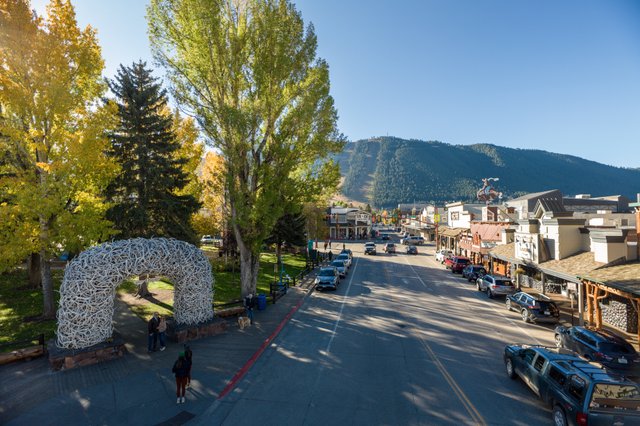
Capturing the Magic: Best Sunrise & Sunset Photo Spots in Grand Teton National Park
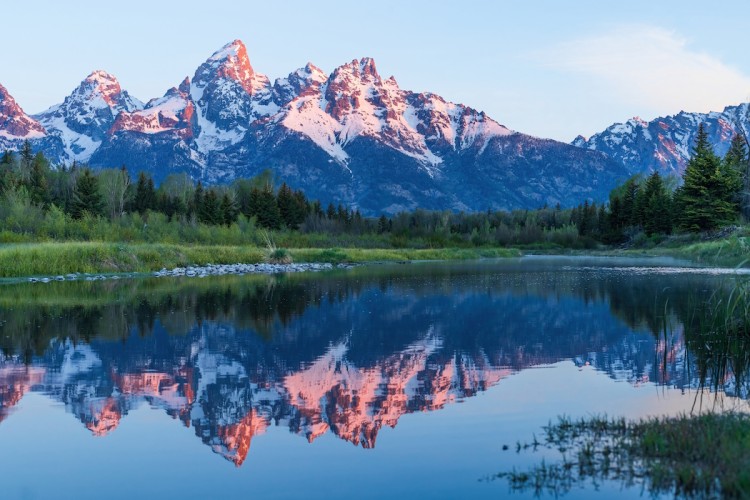
Summer Bliss: Top Activities to Experience in Jackson Hole
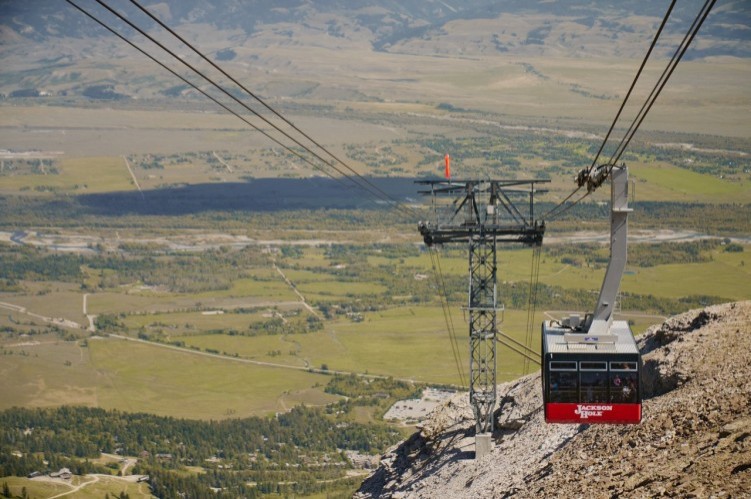
Exploring America’s Public Lands: A Guide to the Diversity of Natural Treasures
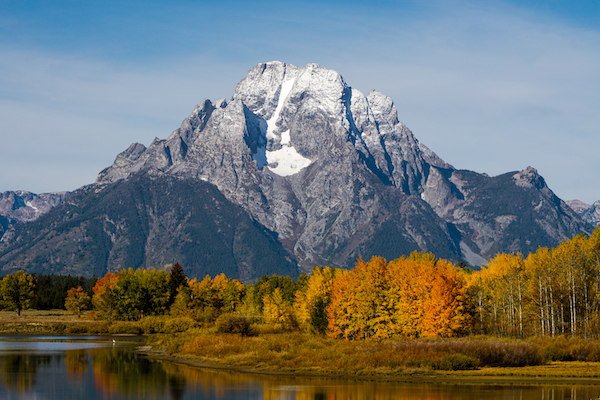
Guide to Winter Activities in Jackson Hole
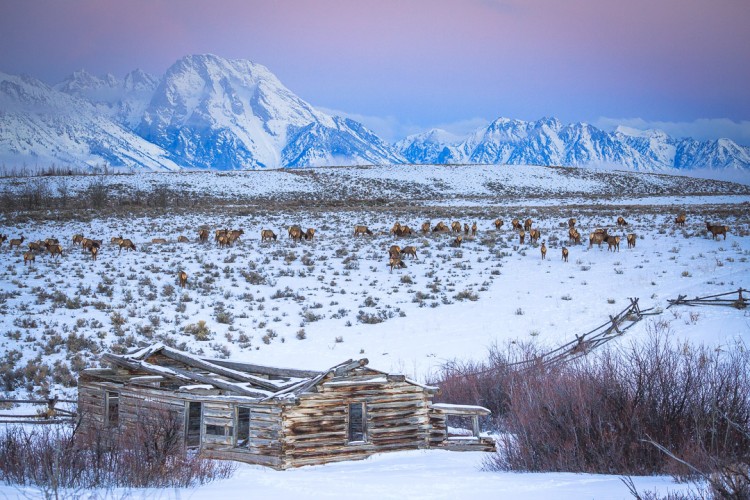
2024 Restaurant Guide to Jackson Hole

Late Fall Wildlife Watching in Jackson Hole
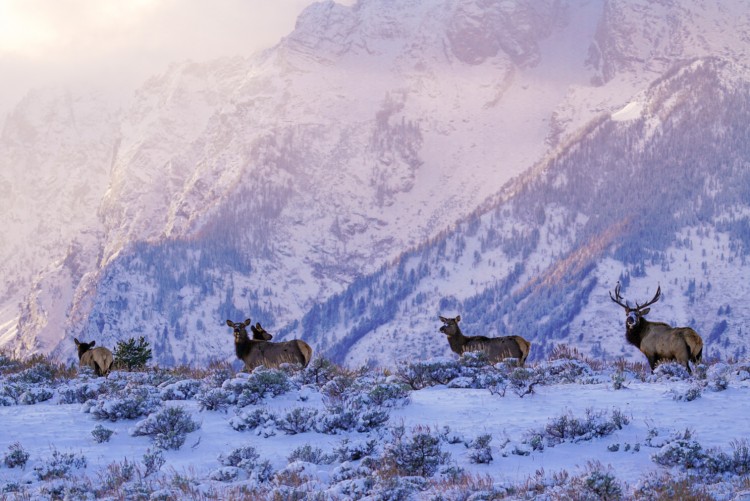
Secrets of Fall Foliage of Grand Teton and Yellowstone National Parks
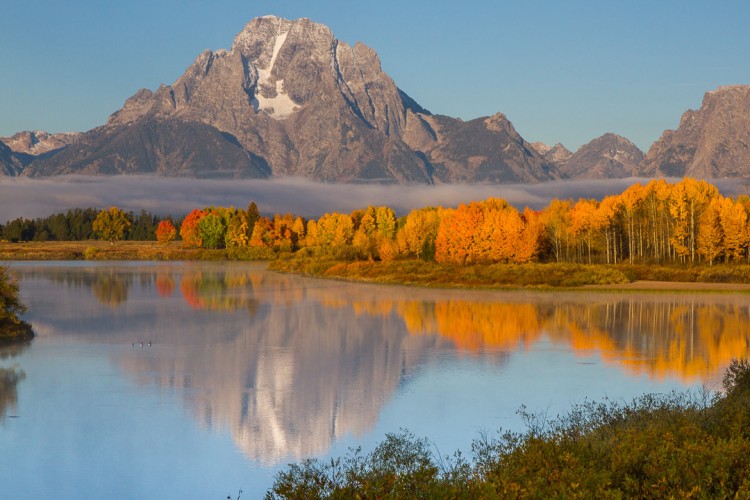
Golden aspen trees light up the landscape at Oxbow Bend in Grand Teton National Park.
Fall is coming to Jackson Hole. Aspen groves in northern Grand Teton National Park are about to begin their seasonal color change. Soon a ribbon of bright orange, yellow, and even red will flow down the cottonwood forests of the Snake River as the trees prepare for their winter slumber.
The annual progression of fall colors marks the end of a seasonal growth cycle of our deciduous (plants which shed all of their leaves at the same time) trees and shrubs. Leaf peepers are flocking to Jackson Hole to observe this seasonal spectacle as well as enjoy our abundant wildlife. It's one of our favorite times of year to photograph and explore Grand Teton and Yellowstone National Parks. Want to learn more about the science of changing leaf color? Read on.
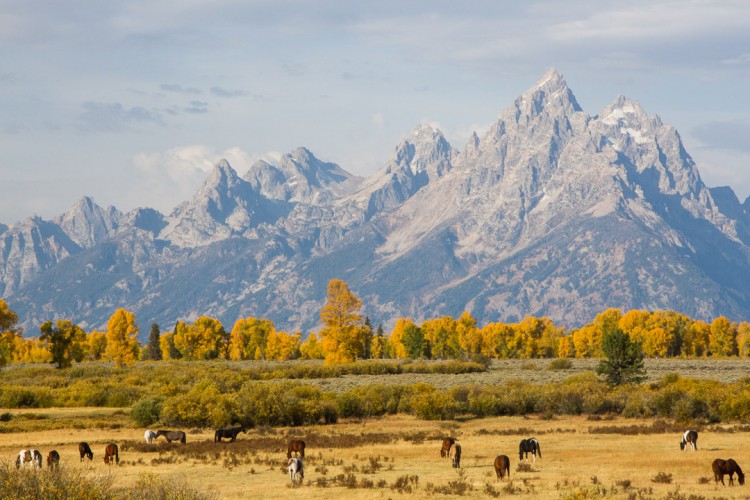
Horses grazing beneath the Tetons in northern Jackson Hole
Right now, shorter days and longer nights are beginning to have a profound impact on plants. At the base of each leaf, cells are rapidly dividing, forming a layer of loose cells known as the Abscission Layer.
Throughout the summer this junction was a transportation superhighway. The roots sent minerals and water up to the leaf, key components in the manufacture and use of the green pigment chlorophyll. Along with several other pigments we will talk about in a moment, chlorophyll harnessed the energy of the sun to photosynthesize, creating carbohydrates, which were in turn shipped down to the roots to fuel later growth.
Here Come the Colors!
As longer nights continue to increase cell division in the abscission layer, we are already seeing chlorophyll production slow on wildlife safaris of Grand Teton and Yellowstone National Parks. As the green color of chlorophyll disappears, other pigments, formerly hidden, are beginning to appear.
Yellow
The beautiful golden yellow color we see in the cottonwoods along the Snake River, and the aspen groves of the Teton Mountain Range are caused by pigments known as Xanthophylls. These pigments, like chlorophyll, also harvest energy from the sun, but are also found in egg yolks and even human blood plasma!
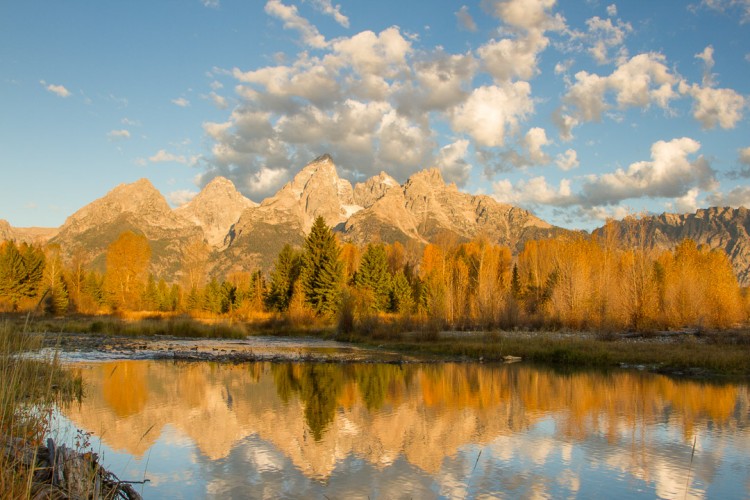
Beaver dams in a side channel of the Snake River at Schwabacher Landing act as spectacular reflecting pools, especially as the cottonwood trees turn yellow.
Orange
Carotenoids also work with the yellow Xanthophylls and green Chlorophylls to harvest light energy throughout the summer. Look for them on aspen and cottonwood trees, as well as willows and other smaller shrubs growing in Jackson Hole.
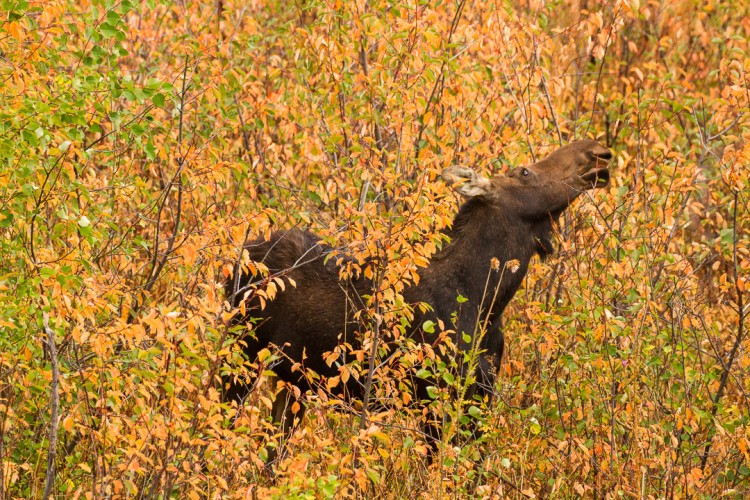
A cow moose strips the orange carotenoid laden leaves off of a bush in Grand Teton National Park.
Red and Purple
Red and purple pigments, known as Anthocyanins, are less common than yellow and orange but will also make an appearance in the fall. Remember the abscission layer? As it cuts off the movement of molecules, sugars become trapped in the leaf, much of which becomes the pigment anthocyanin. East coast maple trees are particularly prized for their red colors in fall but we have numerous shrubs which will turn red including the much smaller Rocky Mountain Maple. Look for it near water, especially in the Snake River Canyon south of Jackson Hole.
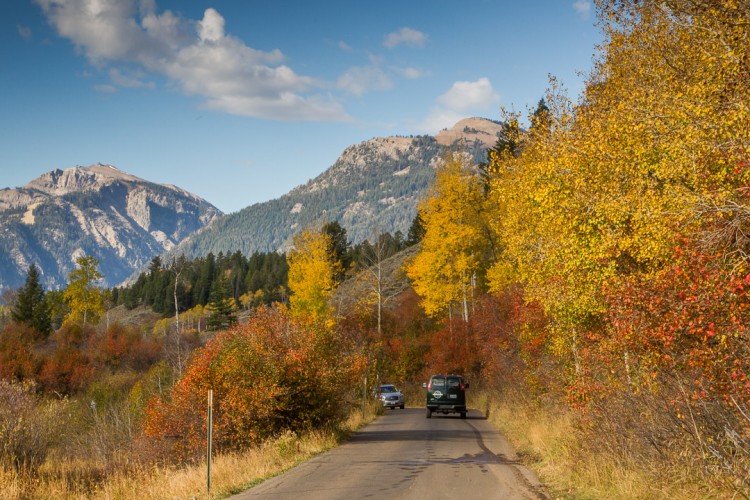
Hawthorn Trees along the Moose-Wilson Road turn red from Anthocyanins. Hawthorns also produce an edible berry favored by both black and grizzly bears!
As autumn progresses, the cells in the abscission layer become more dry and “corky”. Connections between cells weaken and the leaves eventually break off, blanketing the ground with color. This carpet of yellow, orange, and red won’t last long however, as light and freezing temperatures cause the pigments to break down. A final group of pigments emerges, the tannins.
Throughout the life of a leaf, tannins aid it in resisting decay and become visible only after other pigments have degraded. Elk and other hooved mammals may dig up these leaves from beneath the snow in winter, or they will gradually decompose back into the soil completing the life cycle.
Factors influencing the quality of fall foliage
Though the start of our fall foliage season is relatively fixed to day length, temperature, sunlight, and soil moisture all greatly influence the quality of fall foliage display. Want more anthocyanins (Reds and Purples)? Hope for abundant sunshine, which speeds up the decay of green chlorophyll, combined with cool temperatures. However, if the temperature drops too much, to below freezing, the creation of red and purple colors will also be impeded.
Worst of all is an early frost, which can prematurely end the foliage season.
Finally, drought conditions during the growing season can cause the abscission layer to form early, leading to leaves dropping before development of fall coloration! The trees we've seen so far this year don't seem to have this problem so we're hopeful for a good fall with out an early drop!
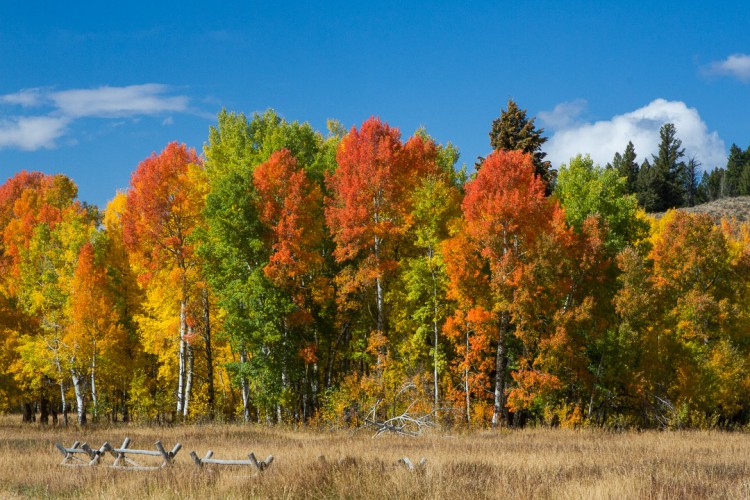
One of our favorite aspen groves in Grand Teton National Park displaying all four pigments at once!
Recipe for a perfect Fall Foliage Season
We are on track for some great leaf peeping this fall and have fingers crossed for dry, sunny, and warm autumn days with cool but frostless nights.
Regardless of the weather, fall is always one of our favorite times to explore Grand Teton and Yellowstone National Parks. Bull elk are bugling, bears are bingeing on all the food they can gather, and the great migrations of birds and mammals across the Greater Yellowstone Ecosystem are, or will soon be in motion.
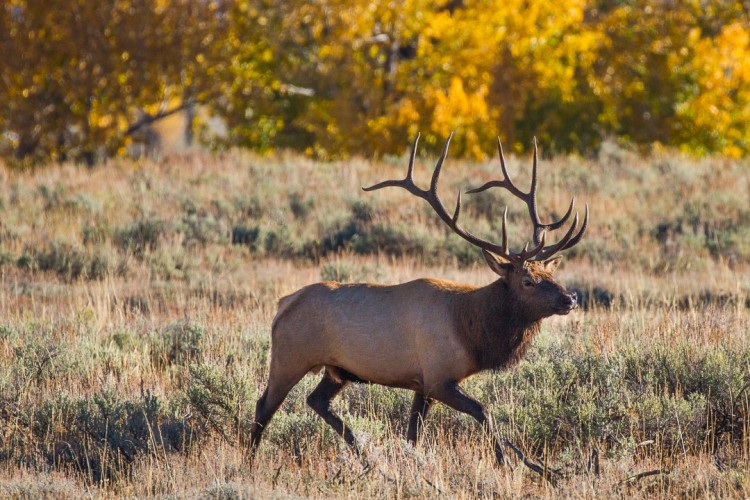
Listening to the sound of bull elk bugling beneath golden fall foliage is one of our favorite experiences in Grand Teton National Park!
Join us on a half day, full day, or multi-day safari by clicking the Book Now! Button at the top of the website or give us a call at (307) 690-9533. We hope to see you soon!
Photos and blog by Naturalist Josh Metten
Guide Mark Byall also contributed to this post.
April Activities in Jackson Hole!
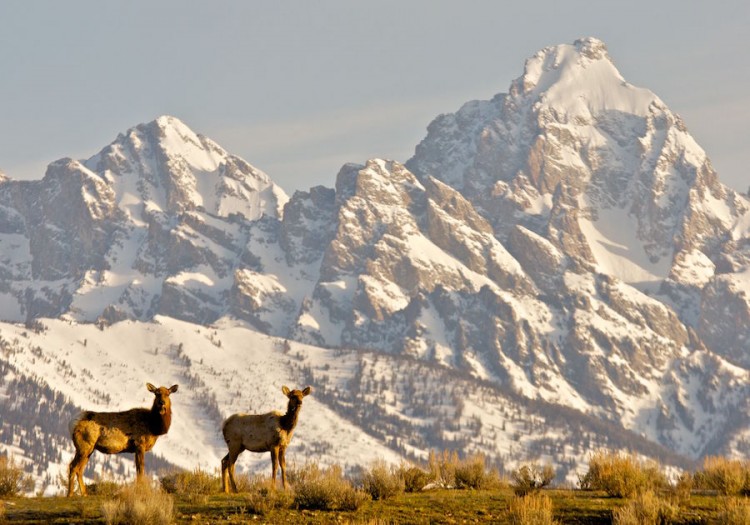
Late Winter Activities and Road Opening Dates in Yellowstone and Grand Teton National Parks
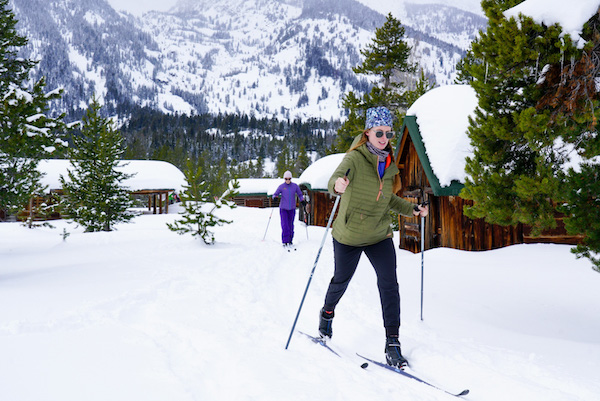
What’s the Deal with Winter Wildlife Closures
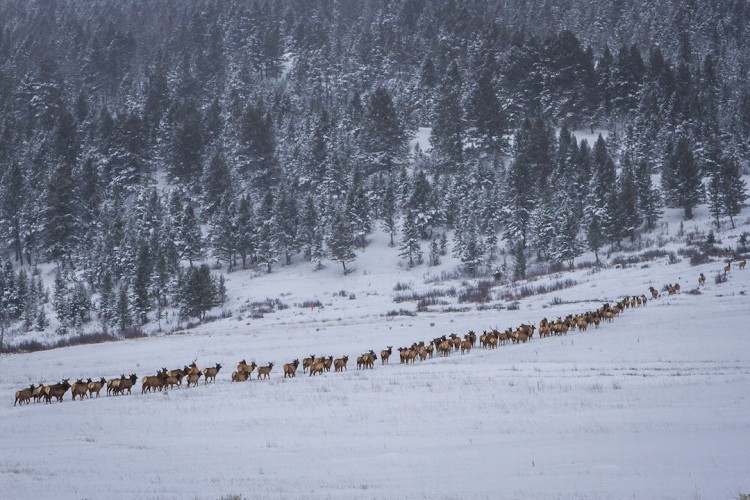
The wind howls and blasts our faces with particles of frozen snow. We watch as the elk herd, ears back and eyes squinting, walks across the meadow. “They’re trailing” I explain, “the herd walks single file to conserve energy as they move through the snow.” The elk reach dark timber, finding a small bit of refuge. But it’s only January, and we more than three months of winter to go. We depart to look for other wildlife as my guests sip hot coffee, cozy in our warm Ecotour Adventures safari vehicle.
We’re visiting the National Elk Refuge, critical winter habitat first protected in 1912. By the early 1900’s, elk and most other herds of big game had been decimated out across the much of United States, a product of unregulated hunting and habitat loss. Alarmed, conservationists took action, setting up regulations which would protect remaining herds and the habitat they needed to thrive.
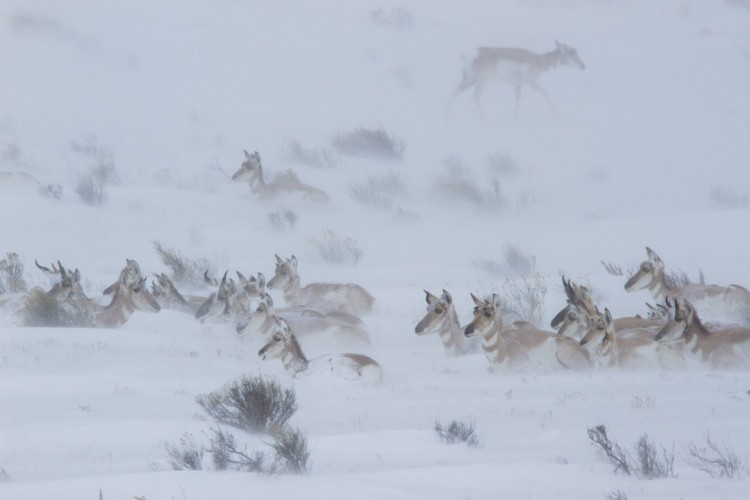
The refuge is one such area which set aside land specifically for wildlife. Other than the short dirt road we’re now traveling along the southern end of the park the vast majority of the refuge is closed to human access for most of the year.
Surviving Winter
For many human residents and visitors of Jackson Hole, winter means adventure. Skiers flock to the slopes of Jackson Hole Mountain Resort, or ascend the peaks in Grand Teton National Park. Below the mountains cross country skiers and snowshoers head out to explore the Jackson Hole Valley. Snowmobiles carry visitors to Old Faithful in Yellowstone. At the end of the day everyone returns to comfortable lodging and rich food, insulated from winter’s grasp until we choose to go back out into it.
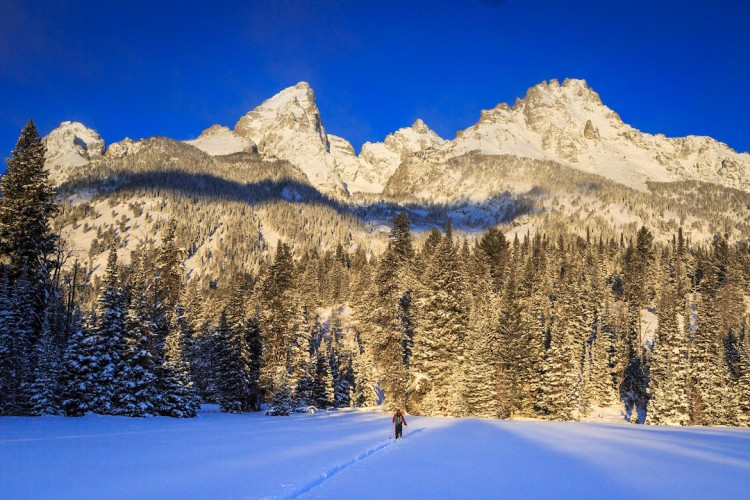
The tall peaks of the Teton Mountain Range offer world class ski resort and backcountry skiing opportunities just minutes from Jackson, WY. @jacksonholeecotours @joshmettenphoto
It’s a far contrast from the lives of our wild winter residents who are out in the snow, all day every day. Most have also migrated to better habitat for the winter, areas which offer shelter from cold temperatures, extreme terrain, deep snow, and some forage. Here they will rely on fat deposits (up to 50lbs of pure fat in elk!) to supplement the limited forage available, waiting out winter. Amazingly, females will also carry full term pregnancies during this time, preparing to bring the next generation into the world in spring.
Protecting Winter Wildlife Habitat
Habitat Protection Areas, (also known as winter wildlife closures) abound in the Jackson Hole Valley in winter, evidence of a commitment to conserving our irreplaceable wildlife by visitors and locals alike. Most are found in the Jackson Hole Valley, places like the Snake River bottom in Grand Teton National Park, and the open hillsides above the town of Jackson. These areas provide refuge for tens of thousands of wintering elk, mule deer, moose, bighorn sheep, and bison, now concentrated in the Jackson Hole Valley in greater numbers than any other time of year.
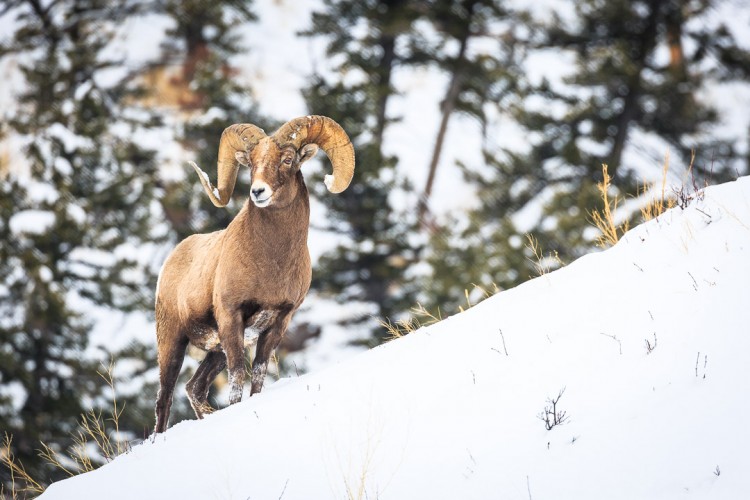
Though hundreds of bighorn sheep migrate from high elevations to the Jackson Hole Valley each year, the Teton herd remains high atop peaks in Grand Teton National Park for the winter. @jacksonholeecotours @joshmettenphoto
Others are found high in the Teton Range, windswept mountaintops including the summits of Mount Hunt, Static Peak, and Prospector Mountain. Winter recreation here is closed through April 30th to protect winter habitat for a small remnant population of bighorn sheep enduring rugged conditions. In the past, habitats like these ones remained protected by default, very few humans had any interest in venturing into these extreme winter environments. It’s a strategy that’s worked for centuries, but is now showing signs of strain.
Stewarding the Greater Yellowstone Ecosystems Irreplaceable Wildlife
As the popularity of winter recreation continues to expand across the Greater Yellowstone Ecosystem it is up to us to recreate responsibly. That's why Jackson Hole EcoTour Adventures is a proud fiscal sponsor of the Don't Poach the Powder Campaign, which seeks to educate the public on protecting wintering wildlife.
Fortunately it isn’t very hard to help our wild neighbors. By staying out of established Habitat Protection Areas we avoid stressing animals, helping them conserve those critical fat reserves they are relying on through late April. These areas represent a small fraction of the overall terrain available to human recreationists, a small sacrifice for the future of the GYE.
You can learn more about habitat protection areas here, thanks to our friends the Greater Yellowstone Coalition for assisting with this post.
Josh Metten is a Senior Naturalist with Jackson Hole Ecotour Adventures with nearly a decade of experience guiding and sharing stories of the Greater Yellowstone Ecosystem.
Now in our 12th year of operation, Jackson Hole Ecotour Adventures leads half day, full day, and multi day wildlife, cross country ski, and snowshoe tours in Grand Teton and Yellowstone National Parks 365 days a year. Let us help maximize your Jackson Hole Experience Today! www.jhecotouradventures.com 307-690-9533 or info@jhecotouradventures.com
7 Ways to Carry Bear Spray in Yellowstone (and a few ways NOT to!)
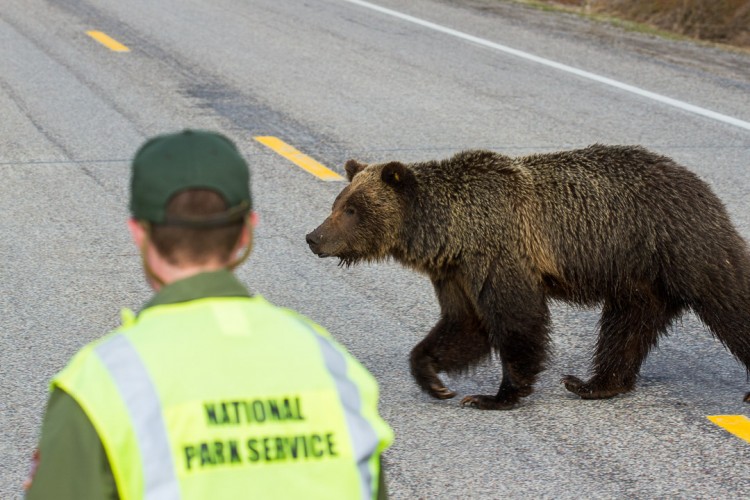
DIY Fly Fishing in Yellowstone National Park
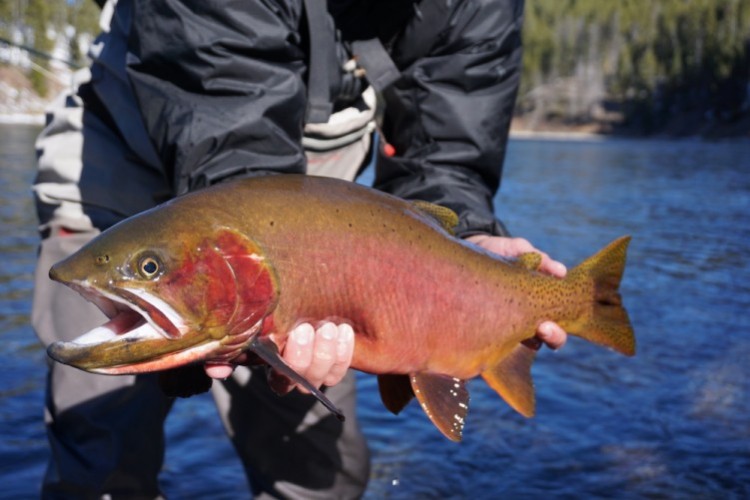
Yellowstone cutthroat trout can reach impressive sizes near Yellowstone Lake
Yellowstone National Park is big, 2.2 million acres to be exact. Set aside by congress as the first National Park in 1872, its fisheries and beauty have remained largely unspoiled. While YNP is known for its abundant wildlife and sprawling geyser basins, it lies at the heart of some of the best trout fishing in North America, offering anglers unmatched opportunity. In part one of this series we discussed DIY Flyfishing in Grand Teton National Park, in Part Two we we will examine a few areas worth exploring in Yellowstone National Park, first in the southern portion, then working our way up to the Northern Range.
Navigating Yellowstone National Park
First it is important to understand how the park is structured. The park roads form a “figure 8”, which divides the park into its upper and lower loops. You can access these loops through Wyoming and Montana through five different entrances. Driving the lower loop you will notice miles of river as well as Yellowstone Lake. Driving the upper loop you will find famed rivers such as the Lamar and Yellowsone. Knowing where to stop and explore will make all difference.
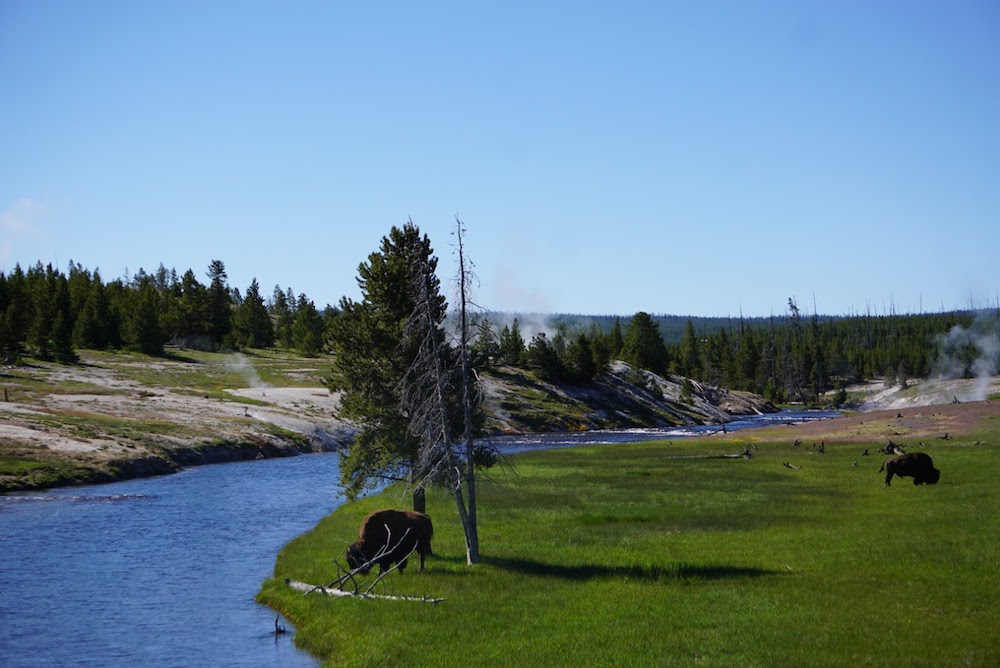
Bison graze along the Firehole River in Yellowstone National Park.
The Lower Loop of Yellowstone
If you want to get an early jump on the fishing season in Yellowstone National Park you should start by looking at the Firehole River. Fed by numerous hot springs and geysers the Firehole River got its name from curious beaver trappers who noted that the river steamed as though it was on fire. This river tends to fish well in May and June as the snow melts out most quickly here. As the summer progresses and water temperatures increase the trout inhabiting these waters will become more lethargic and less likely to bite. This famous and storied river for serious destination fly fisherman is unmatched in its unique abundance of bison and geothermal basins. Please note that this river is susceptible to closure in the later summer months due to warming water temperatures.
Later in the summer, July 15th, the Yellowstone River opens for fishing. Anglers will travel from around the globe to reach these premiere waters. The Yellowstone River flows north from Yellowstone lake holding lake sized fish in its riffles, pools and cut-banks. The fish holding in these waters are the Yellowstone cutthroat trout, wild and willing to eat. Accessing this river is easiest between LeHardy Rapids and Mud Volcano. Upon reaching this stretch of river you may find an abundance of insect life. In July you may still find salmon flies, caddis and mayflies. Oftentimes drifting large nymphs imitating these bugs through deeper trenches and pools will yield good results.
Yellowstone Cutthroat on the Yellowstone River
The Upper Loop of Yellowstone
The Lamar River is one of the most beautiful rivers in the park as it flows through the Lamar Valley. This lush valley, often referred to as the North American Serengeti, is home to an array of wildlife including bison, pronghorn, wolves, grizzlies and much more. Because this river originates high in the Absaroka Mountain range, it is fed by melting snow into July. Do not expect this water to be running calm and clear until mid summer. Throughout late July and August cutthroat and rainbow trout will be rising to a variety of terrestrial patterns imitating grasshoppers and crickets. Generally the Lamar river is only a short walk from the road so it is easily accessible. Try fishing where the Soda Butte Creek meets the Lamar River at the eastern edge of the Lamar Valley. Around this confluence anglers will find a multitude of wadable braids of small water and a plethora of trout feeding on terrestrial insects.
For anglers more inclined to challenge themselves, look towards Slough Creek just west of Lamar Valley. Divided into four meadows, first, second, third and fourth, Slough Creek offers some unique opportunities. While the first meadow lies about 2.5 miles from the trail head, the others would require an overnight stay and a backcountry permit. One thing to keep in mind is that the further you hike from the trailhead, the less fishing pressure there will be on the water. Cutthroat and cutbow trout are wily, so a tactical approach and 5x tippet is the norm. Slough Creek usually becomes fishable around July 4th and will last through September. During the summer months expect to see mayfly hatches and hoppers.
Smaller creeks and rivers in Yellowstone may hold surprisingly large fish!
Gear to Bring
The four most essential items to have with you while spending time flyfishing in Yellowstone National Park are bear spray, warm layers, water, and food. These are three things that might save your life. While bear attacks are uncommon in YNP, seeing a bear is not. So make sure it is always accessible, just in case (learn more about safety in carnivore country here). I recommend carrying bear spray where you can deploy it without taking it out of the holster, such as attached to your belt or a chest fishing harness.
In Wyoming, it is always a good idea to bring layers. Remember, in YNP you are at high elevation, so weather can change dramatically and cold temperatures can arrive quickly. Always make sure to have a rain jacket and a warm layer. Avoid cotton when thinking about what to wear/pack. Cotton will take a long time to dry if wet and will not keep you warm. Another must-have item is a full water bottle, or two. The high elevation and dryness of this climate will dehydrate you quickly.
Licenses and Regulations for Flyfishing in Yellowstone
Yellowstone National Park is managed as a natural area to protect plants, wildlife, geology, and scenery. Angling has been a major visitor activity for over a century. Present regulations reflect the park’s primary purposes of resource protection and visitor use. The objectives of the fishing program are to manage aquatic resources as an essential component of the ecosystem and to preserve and restore native fish and their genetic integrity. Lastly the park would like to provide recreational fishing opportunities to park visitors in a way that is consistent with the previously mentioned objectives.
If you plan on fishing in Yellowstone National Park you will need to purchase a permit. Please note that this is separate from a Wyoming fishing license. A permit can be purchased for the season at $40, a week at $25 or three days at $18. Anyone under the age of 16 will not require a permit. You can purchase these permits at a number of places within the park including visitor centers, ranger stations and Yellowstone Park General Stores. It is very important that you check the latest regulations, seasonal openings and closures as all waters in YNP and are entitled to their individual management strategies. If you plan on camping in the backcountry be sure to reserve a campsite at a visitor center in the park or apply for a permit if necessary.
Why Fishing is Conservation
Fishermen and hunters are some of the original conservationists. These people have, and will continue, to advocate for the protection of public lands, environmental laws and regulations that help sustain their passions. By encouraging more folks to get out and enjoy their local waters, it is possible to cultivate more conservationists, more people that will advocate for the protection of their resources. In many ecosystems trout are a Keystone species, meaning that they are a vital piece of the puzzle. The removal of such a species would change an ecosystem drastically. When we advocate for healthy waters and fish populations, the entire ecosystem will benefit.
One of the biggest threats that Yellowstone National Park faces are invasive species. Park rangers and volunteers have been working tirelessly since the early 1990’s to protect these native trout from extinction. In my next blog we will learn more about Yellowstone cutthroat trout, the threat they face from lake trout, and what Yellowstone National Park is doing about it.
EcoTour Adventures Guide Kirk Ryder, originally from Massachusetts, developed an intense curiosity and interest in the outdoors spending his summers in the Berkshire Mountains. His college years lead him through the Adirondacks to St. Lawrence University where he studied environmental science, government and served as vice president to the Hunting and Fishing Club. During these college summers Kirk made his first visit to Wyoming, fallingin love with the Greater Yellowstone Ecosystem. Now situated in Jackson, Kirk spends his free time backcountry skiing, hiking, fishing and rafting. Kirk’s excitement for outdoor education and sharing it with others is a terrific combination as he seeks to inspire others to better understand the natural world and what it means to be a part of the GYE.
DIY Fly Fishing in Grand Teton National Park
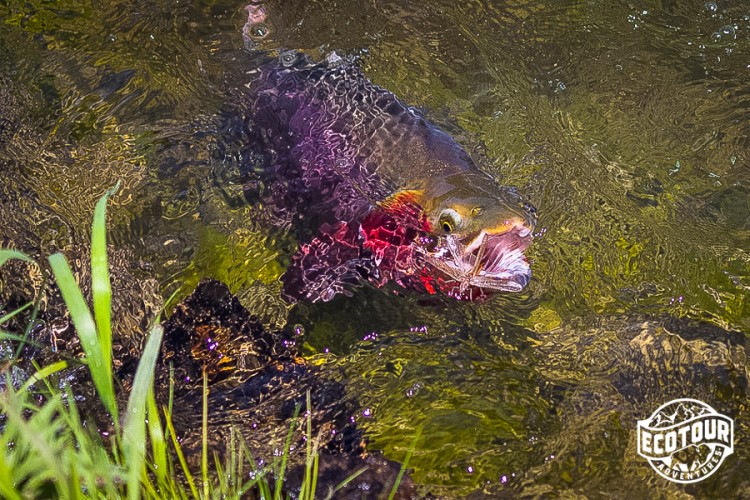
Do you love fly fishing, but would rather go it alone than hire a guide? There is a certain feeling of personal pride that can be taken from a successful DIY fishing trip. The key, however, to a successful excursion is proper preparation and knowledge of the area. Grand Teton National Park offers anglers numerous opportunities to target trout in pristine rivers and lakes beneath soaring mountains. In these waters, you will find native cutthroat, brown, rainbow and lake trout. Here are some ideas of where to go.
The Snake River and its Tributaries
Meandering about 27 miles through the Jackson Hole Valley and Grand Teton National Park, the Snake River not only offers stunning panoramic views of the Tetons, but world class fishing. A braided freestone river like this one can be a DIY fisherman’s best friend, with endless riffles, runs, holes, and confluences explore. From the Moose Visitor Center, an unmarked trail heading south along the river’s edge will reveal miles of productive water. Spend some time working smaller channels that drift boats may have passed up on their way downriver.
The Snake River can be big and intimidating. For those looking to find smaller, more manageable water, look no further than the Spread Creek. This tributary to the Snake River gets less fishing pressure as it is too small for drift boats carrying guides and clients. By late June the cutthroat trout inhabiting this water are willing and eager to rise to a fly. Don’t be afraid to travel further upstream to find some solitude. Typically the further you hike away from the roads, the less people you will see, and the better the fishing gets! Remember to be bear aware and have bear spray accessible at all times when you fish in Jackson Hole, Grand Teton and Yellowstone, you’re in grizzly country!
Want flyfishing instruction? We recommend JH Flyfishing School.
Lakes in Grand Teton National Park
If you are visiting in the early Summer, you may find that the local rivers are rushing with spring melt off from the mountains. These rivers will be very difficult and dangerous to fish but don’t worry, there are seven lakes along the base of the Teton range harboring sizable trout. Over the past 2.5 million years, glaciers have carved canyons in between these mountains which are consistently carrying cold, nutrient-rich water from the mountains to the lakes at their bases.
The Phelps Lake inlet can best be accessed by following the Whitegrass Ranch Road, eventually reaching the Death Canyon trailhead. Fortunately, this canyon is not as dangerous as it sounds. A short hike leads you up and over the glacial moraine that contains Phelps Lake. At the lake’s westernmost point, where it is closest to the mountains, an ice-cold stream from Death Canyon pours into Phelps Lake. Cutthroat and lake trout spend their time here enjoying the oxygenated water and the food it carries with it.
A few miles north of Phelps Lake you will find Jenny Lake sitting beneath Cascade Canyon. This lake is one of the most popular places in the park for its breathtaking views and trailhead access. Parking north of Jenny Lake, at String Lake, you can follow a trail that leads you to where these two lakes meet. String Lake slowly flows into Jenny Lake, providing cold water and nutrients for cutthroat trout. Casting streamers towards this inlet can be quite productive.
A native cutthroat trout caught at Jenny Lake
Gear to Bring
The four most essential items to have with you while spending time flyfishing in Grand Teton National Park are bear spray, warm layers, water, and food. These are three things that might save your life. While bear attacks are uncommon in GTNP, seeing a bear is not. So make sure it is always accessible, just in case. I recommend carrying bear spray where you can deploy it without taking it out of the holster, such as attached to your belt or a chest fishing harness. Learn more about safety in carnivore country here.
In Wyoming, it is always a good idea to bring layers. The weather can change dramatically so always make sure to have a rain jacket and a warm layer. Avoid cotton when thinking about what to wear/pack. Cotton will take a long time to dry if wet and will not keep you warm. Another must-have item is a full water bottle, or two. The high elevation and dryness of this climate will dehydrate you quickly.
In my fly-box there are three flies that I always want to have with me, chubby Chernobyls, pat’s rubber legs, and the lil’ kim. While these trout will take a variety of artificial flies, you may find success using chubby Chernobyls because they can look simply irresistible. Chubbys may imitate a variety of terrestrial bugs, or may simply serve as an attractor that an opportunistic trout can simply not resist. For trout feeding subsurface, a pat’s rubber legs is always a good choice as it can imitate local stone and salmon flies. It looks downright buggy and delicious. Lastly the lil’ kim, found in fly shops in Jackson, is a streamer that looks natural enough to imitate a small bait fish or leach, with just enough flash to entice a trout to strike.
Search for deep pools when fishing smaller creeks.
Fishing Licenses and Regulations
Fishing in Wyoming will require a license for residents and nonresidents over the age of 14. Licenses can be purchased online and at a number of fly fishing shops in town. You will have the choice to buy a day or annual license. If you are a non-resident and plan on fishing more than 7 days, the economical choice would be to purchase the annual license. This license will not cover Yellowstone National Park and Reservation land. Make sure to research seasonal closures and regulations before fishing any body of water. When you purchase a fishing license, it is not a fee, but a contribution. Your money will help fund fishery management, hatchery programs, invasive species programs, and conservation education.
Catch and Release
Keeping fish can be a rewarding experience, but make sure that you have thoroughly reviewed the regulations as they will vary from one location to another. For example, when fishing lakes inside Grand Teton National Park you may keep 6 trout per day, no more than 3 cutthroat trout, and no more than 1 cutthroat trout exceeding 12 inches. While fishing the rivers in Grand Teton National Park, you may keep 3 trout, no more than 1 exceeding 16 inches.
For many anglers releasing fish is the preferred practice. If you decide that you would like to release your fish, it is important to follow a few steps to ensure the safety and health of the fish once released. First, try to land the fish as quickly as possible which will reduce the amount of stress placed on the fish. Next, you will want to keep the fish in the water as much as possible when handling. This fish has just undergone what it suspects to be a fight for its life, so the fish may be exhausted. When handling the fish use wet hands and knotless, rubberized nets. This will help protect the slime layer covering the fish. This layer is essential in protecting the fish from infection and aids in swimming. Lastly, when returning the fish to the water, hold the fish horizontally with its head upstream. The fish may depend on you for this sort of support as it takes a moment to recover from the fight, especially as water warms later in the summer. If you find that the fish will not survive, consider harvesting it if this falls into line with the local rules and regulations.
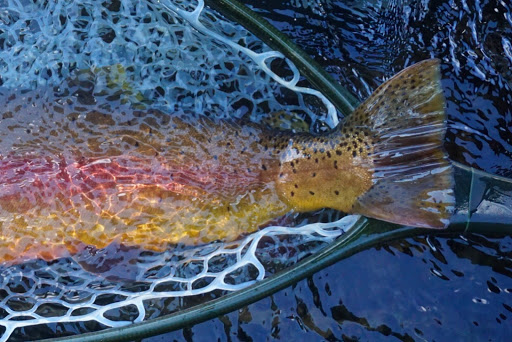
Cutthroat trout in a knotless rubberized net
Why Fishing is Conservation
Fishermen and hunters are some of the original conservationists. These people have, and will continue, to advocate for the protection of public lands, environmental laws and regulations that help sustain their passions. By encouraging more folks to get out and enjoy their local waters, it is possible to cultivate more conservationists, more people that will advocate for the protection of their resources. In many ecosystems trout are a keystone species, meaning that they are a vital piece of the puzzle. The removal of such a species would change an ecosystem drastically. When we advocate for healthy waters and fish populations, the entire ecosystem will benefit.
For many, those who are drawn to the grandeur of Grand Teton National Park will eventually find themselves in Yellowstone National Park. Here fisherman can find rivers lined with hot springs and bison, or Yellowstone cutthroat trout of trophy proportions. In the next EcoTour Adventures Blog we will explore how to safely and effectively fish the land of “fire and brimstone”.
EcoTour Adventures Guide Kirk Ryder, originally from Massachusetts, developed an intense curiosity and interest in the outdoors spending his summers in the Berkshire Mountains. His college years lead him through the Adirondacks to St. Lawrence University where he studied environmental science, government and served as vice president to the Hunting and Fishing Club. During these college summers Kirk made his first visit to Wyoming to work for Teton Valley Ranch Camp. It was here that Kirk fell in love with the Greater Yellowstone Ecosystem, leading backpacking trips and fly fishing trips. Now situated in Jackson, Kirk spends his free time backcountry skiing, hiking, fishing and rafting. Kirk’s excitement for outdoor education and sharing it with others is a terrific combination as he seeks to inspire others to better understand the natural world and what it means to be a part of the GYE.
Fourth of July Activities in Jackson Hole
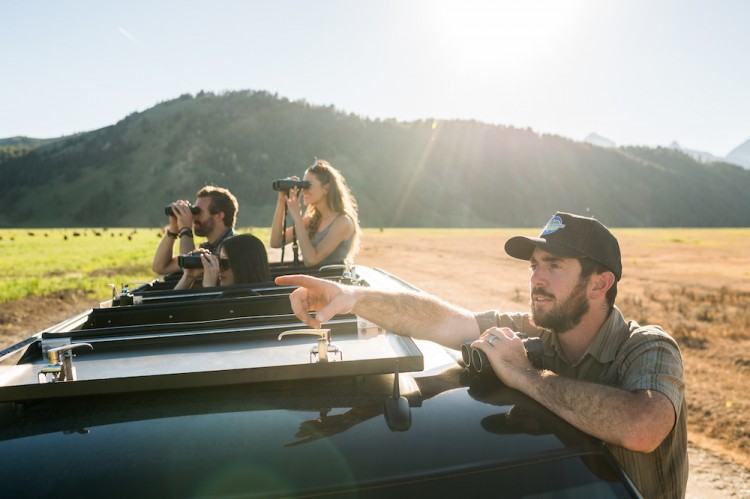
Thinking about visiting Jackson Hole for the Fourth of July? It is a great time of year to visit. Early July is considered the beginning of summer by most locals. By the fourth of July, temperatures have warmed up consistently and the landscape is awash with blooming wildflowers and rustling aspen leaves.. There are plenty of fun activities to check out when you come to celebrate your Jackson Hole Fourth of July, here are a few of our suggestions!
Wildlife and National Park Tours
Join the experienced Naturalists at Jackson Hole EcoTour Adventures on a guided tour of Grand Teton and Yellowstone National Parks! We offer half and full-day tours into Grand Teton National Park and full-day tours of the lower loop of Yellowstone, all of which can be enjoyed during your Fourth of July vacation. With chances to observe baby elk, pronghorn, moose, or bison calves, and even bear cubs or wolf pups, this time of year is one of our favorites for wildlife watching in Grand Teton and Yellowstone. Visitation to the Parks this year remains low compared to other years, meaning we have more opportunities to enjoy them without crowding. Give us a call at 307-690-9533, email info@jhecotouradventures.com, or check out our website for live tour availability and information!
Tune in to our weekly Wildlife Wednesday Video Roundup’s each week at 5:30pm MST on Facebook to learn more about what we’re seeing on tours of Grand Teton and Yellowstone National Parks!
We recommend touring with us early in your vacation. This allows you to get a “lay of the land” and know which spots to revisit during your time here, should you want to continue looking for wildlife in the parks. Our guides enjoy sharing their insights on where you can continue your explorations of Grand Teton and Yellowstone National Parks.
Where to Watch Fireworks in Jackson Hole
The Fourth of July wouldn’t be complete without fireworks. Jackson Hole Mountain Resort in Teton Village has confirmed they will be hosting their annual fireworks shows on Friday, July 3rd and Saturday, July 4th. These events take place after sunset, starting around 10:00pm. They are encouraging folks to view from their vehicles, places of lodging, or other locations that allow for social distancing. Plenty of local restaurants are offering take out options for dining (read on for our suggestions), so grab dinner to-go from your favorite spot and picnic while you wait for the show to start!
Snow King Mountain has also confirmed they will be putting on their annual fireworks show on Saturday, July 4th, in town at the base of the Snow King Ski Area. This show usually starts around 9:00pm.
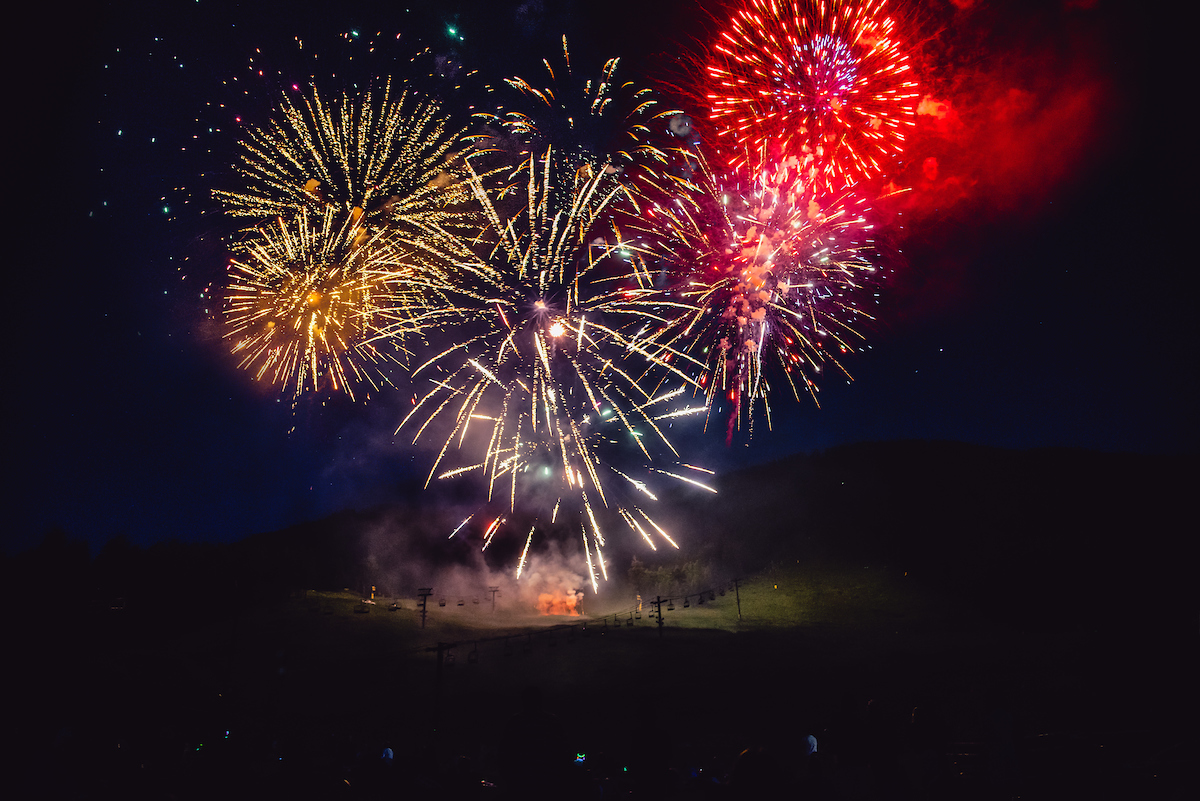
Snowking Mountain is just minutes from downtown Jackson and offers a spectacular fireworks display. Image courtesy VisitJacksonHole
Experience the Jackson Hole Rodeo
A quintessential Jackson Hole Fourth of July experience is the Jackson Hole Rodeo. This real-deal rodeo includes competitors of all ages participating in bronco and bull riding, calf roping, and barrel racing. The rodeo will be held each evening at 8:00pm on July 1st, July 3rd, and July 4th. If you’ve never experienced a rodeo before, it is non-stop excitement! Watching a young girl or boy race a horse through a barrel course is quite an impressive sight.
Explore the National Museum of Wildlife Art
If you’re looking to escape the heat of the day, the National Museum of Wildlife Art located just north of downtown Jackson is a great choice. With the largest collection of wildlife-themed art in the country, they have a wide variety of beautiful art mediums to offer including sculpture, photography, painting and more. The museum is open Tuesday - Saturday from 10:00am - 2:00pm this summer season.
Fly Fishing in Jackson Hole
Fly fishing is a favorite pastime for locals and Jackson Hole visitors alike. A guided experience allows for instruction and improvement in your skills. Jackson Hole Fly Fishing School offers a variety of tour options for the beginner to advanced fisherman, with plenty of introductory experiences. Westbank Anglers offers outings for beginners to advanced anglers, as well, venturing to rivers and lakes in the surrounding areas, if you wish.
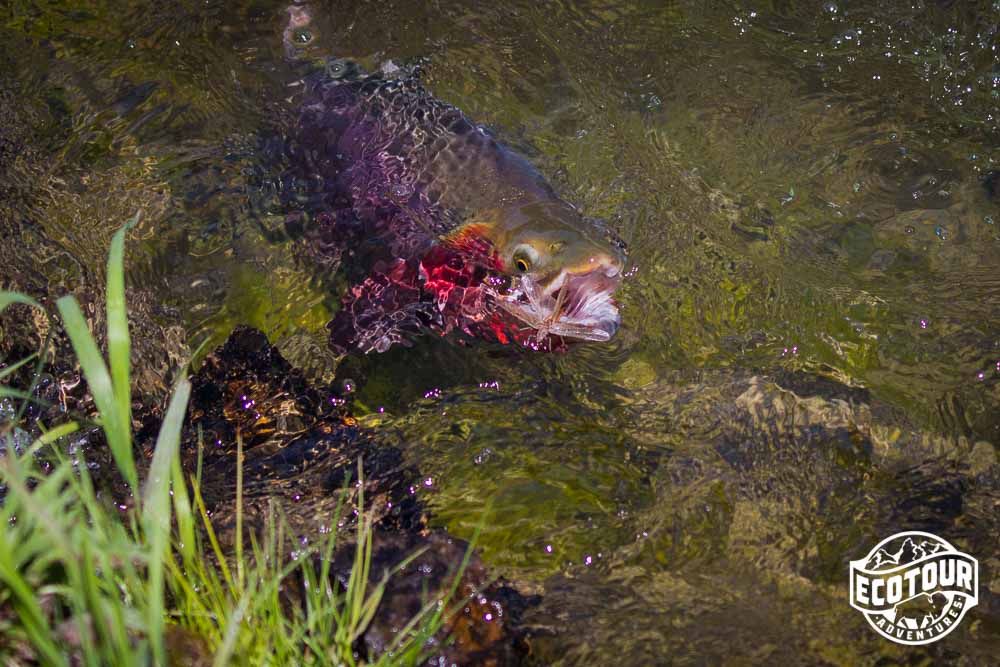
Cutthroat Trout in Yellowstone feeding on an adult salmonfly. Photo by guide @joshmettenphoto
Take a Scenic or Whitewater Float on the Snake River
If being on the water says “Fourth of July” to you, then a float trip through Grand Teton National Park is a great activity. National Park Float Trips with Triangle X Dude Ranch take on you a leisurely scenic float down the Snake River through Grand Teton. Breathtaking scenery and wildlife viewing opportunities abound while you make your way through the park by boat.
For those interested in more splashes, the Snake River canyon offers 9 miles of class III whitewater fun for the whole family. We recommend Dave Hansen Whitewater.
Where to Eat in Jackson Hole
Looking for a western-style dinner while in the area? The Chuckwagon is a great option. Chuckwagon dinners are traditionally prepared outside in cast iron dutch ovens and on grills. The impressive dinner spread is hosted outside, often accompanied by western-themed entertainment. Shows include everything from a solo cowboy playing guitar to a full western show or barn dance. There are a few options for a chuckwagon or western-style dinner Mill Iron Ranch, located about a 20 minute drive south of Jackson, Bar T-5, located in the town of Jackson, Bar J, located about a 15 minute drive from Jackson.
A great quick breakfast stop on your way to the national parks is Pearl Street Bagels. With locations in the town of Jackson and Wilson open 6:30am-6:00pm daily, you can grab a delicious bagel and coffee, no matter where you are staying.
If you are looking for lunch or dinner while adventuring in Grand Teton National Park, Dornan’s Pizza & Pasta Co. is a delicious option. They have a variety of tasty pizzas, salads, and pasta dishes to choose from. The scenery while dining is second to none, with panoramic views of the Teton range laying before you.

The Poke Bowl from the Phoenix and Dragon is not to be missed.
A fantastic take-out option for dinner in Jackson is the Phoenix and the Dragon. They offer an amazing selection of organic, vegan, gluten free, dairy free, vegetarian asian dishes that are delicious whether these are dietary considerations of your’s or not.
A long-time Jackson favorite is the Blue Lion. Situated in a quaint converted home, they offer classic dishes like (the best) rack of lamb and an elk tenderloin, with outdoor seating as an option. Reservations are recommended.
Enjoy the 4th of July in Jackson Hole this year
There are a wide variety of activities to enjoy during your Jackson Hole Fourth of July vacation, we hope our suggestions help you plan your trip. Please let us know if the guides at EcoTour Adventures can help maximize your time in Jackson Hole by contacting us at 307-690-9533 or info@jhecotouradventures.com . We would love to tour with you and be a part of your trip to the area!
*Events are subject to change. Please contact individual event organizers or outfitters for complete information.
Best Places to See Winter Wildlife in Jackson Hole
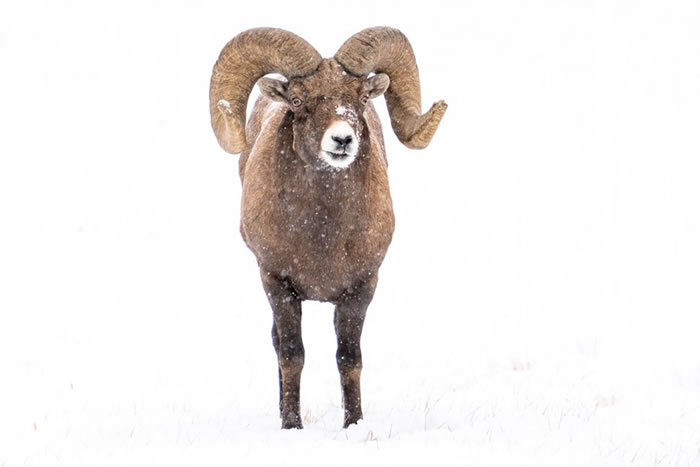
It’s late winter in Jackson Hole. With over 400 inches of snow blanketing the peaks of Grand Teton National Park, the landscape appears silent, yet life abounds here. Our valley lies in the heart of the Greater Yellowstone Ecosystem, and each winter wildlife both large and small concentrate here to endure winter.
Finding wildlife in winter can be as easy as watching elk herds of the National Elk Refuge or as difficult as spotting a camouflaged great gray owl against the similar texture of cottonwood bark. Either way, learning the best places to see wildlife in Jackson Hole is the first step. With another month of winter to go as spring approaches, here are some of our favorite spots and what to look for!
Miller Butte in the National Elk Refuge
Departing Jackson’s Town Square, head east on Broadway until the paved road ends and follow the dirt road onto the National Elk Refuge. As late winter turns to spring on the Refuge, look for fresh dirt piles in the snow. These are evidence of badgers hunting for hibernating ground squirrels!
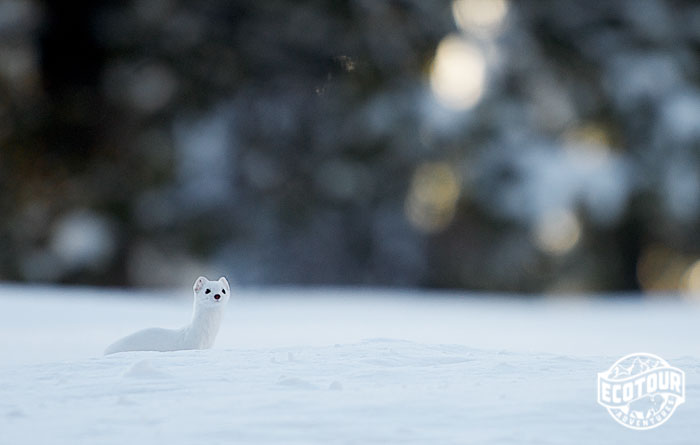
Long-tailed weasels, a smaller relative to the badger are sometimes seen sprinting across the flats of the National Elk Refuge. Dozens of mammal species and hundreds of bird species also call this landscape home
Look for eagles and other birds roosting in the cottonwood trees above the historic Miller House before arriving at Miller Butte. In winter, the Gros Ventre bighorn sheep herd migrates out of the mountains to these slopes, taking advantage of the sunny, wind-scoured slopes. The cliff bands of Miller Butte also provide refuge should a coyote, wolf, or mountain lion (all of which are found on the Refuge!) approach.
As winter progresses into spring a mating pair of prairie falcons returns to their nesting site in these cliffs, a welcome sight for avid birders. Beyond the butte, a vast view of the nearly 25,000-acre Refuge emerges, we love to glass from here with our Maven S.1 spotting scopes in hopes of catching the Huckleberry wolf pack.
East Gros Ventre Butte
My first winter in Jackson Hole, I spent many days driving into the park fixated on the promise of skiing in the Tetons, oblivious to the hundreds of animals wintering on the slopes above the road to my left. Many of the mule deer who raise fawns in Grand Teton National Park during the summer return to the Butte each winter, retracing the steps their own mothers taught them. Like the bighorn sheep across the Refuge, mule deer use these slopes because prevailing winds help blow the snow off sagebrush and other shrubs which are their primary food source.
Winter is tough on our ungulates, or hoofed animals, and some unfortunately succumb to starvation, exposure, or to vehicle strikes along HWY 89/191. Though we are working to reduce wildlife-vehicle collisions in Teton County, (read about our efforts here!) these winter kills do provide much-needed sustenance for bald and golden eagles, ravens, magpies, foxes, coyotes, foxes and dozens of other species. There is no waste in nature.
The National Museum of Wildlife Art is one of our favorite places to visit and also glass for wildlife. If you tour the museum, be sure to check out our EcoTour Adventures Spotting Scope in the Members Gallery and look for wolves, coyotes, and eagles along with over 8000 elk who reside on the National Elk Refuge in winter.
This year the Huckleberry wolf pack has moved south onto the National Elk Refuge, displacing the Pinnacle Peak pack from an area they had roamed for years. The arrival of this new pack has made for great wolf watching on the Refuge, and each viewing location listed here provides different opportunities to look for them.
One final location to look while on the Refuge is from the Fish Hatchery. The pond nearby stays unfrozen year-round providing consistent opportunities to look for a multitude of duck and waterfowl species including gadwall, bufflehead, ringneck, goldeneye, trumpeter swans, hooded merganser and others. The willows in this area may also hold some of the first returning songbirds of spring, including song sparrows, red winged blackbirds, and the stunning mountain bluebird.
Be sure to check the fence posts and power lines along the Refuge for a medium-sized raptor who has traveled over 2000 miles to get here. The rough-legged hawk, similar in size to our more common red-tailed hawk winters in the lower 48 states before returning to nesting territories in the arctic circle. It’s one of just a few species who migrate to, instead of away from the GYE in winter.
Grand Teton National Park
In summer, wildlife watching in Jackson Hole largely occurs in Grand Teton National Park, but in winter deep snows have pushed most large animals to lower elevations. Not so for our largest deer, the moose. With their long legs and high stepping gait, moose are perfectly adapted for snow and as a result, they have a “circumpolar” distribution around the world. Earlier in the winter moose concentrate in the sagebrush flats of Antelope Flats, but as the snow deepens they return to rivers such as the Snake or Gros Ventre where they can wade in the water to reach food sources.

As the snow begins to recede in the valley in late winter Antelope Flats is a great spot to look for Greater sage grouse. These “wild chickens” gather to mate on lek sites throughout late March and April. A ‘lek’ is a location where males of a species concentrate to display and hopefully attract mates. Grand Teton has one near Mormon Row, though on deeper snow years we’ve seen males displaying on windswept ridges elsewhere in the Park. As you look for wildlife in southern Grand Teton also keep an eye out for the first western meadowlark and American kestrel of spring, they should be arriving any day now!
Rivers in Jackson Hole
Traveling along rivers in winter is a sure bet to see wildlife. As we’ve already discussed, moose, along with waterfowl and eagles use this open water to feed. My favorite river bird, the American dipper, is also at home in the water. Watch for a monotone gray bird a bit smaller than a robin flitting about in and out of the water. If you catch one it will likely dip on its rock perch before diving underwater to pull aquatic macroinvertebrates from the river bottom.
Bald eagles are starting to return to nest sites along the river, and may even be incubating eggs! Look for large stick nests in cottonwood trees near the river for a chance to catch a glimpse of these large raptors.
We’ve also been enjoying great otter sightings this winter in some of the creeks and rivers of Jackson Hole. Beaver ponds with open water can be a great place to look, as well as Jackson Lake Dam or any time you are along the Snake River. Otters often slide along through the snow on their bellies, look for drag marks in the snow to help locate these playful mustelids.
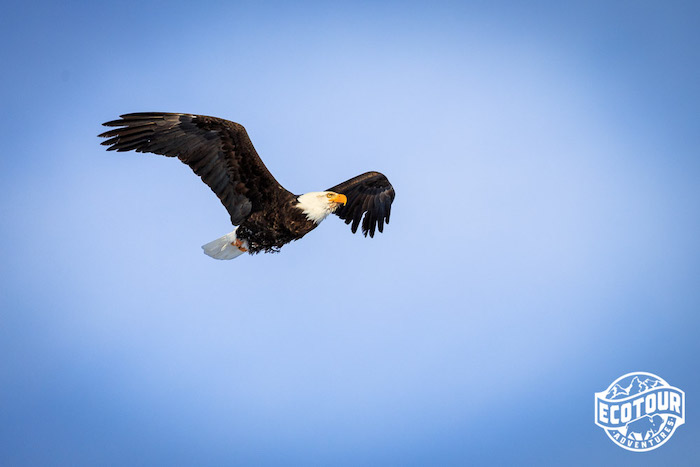
Northern Grand Teton
By mid winter, most of our wildlife viewing while snowshoeing or cross-country skiing in Northern Grand Teton consists of the tracks of coyote and fox, ermine, American martin, and the prey they pursue, including mice, voles, snowshoe hare, and squirrel. But soon enough more creatures will appear.
Grizzly bears start to stir in March, and by mid April we usually have our first sightings in the northern part of the park. (Read more about bear safety here). Bears seek out freshly melted out areas to dig for edible roots and small mammals while sniffing around for the scent of winter-killed animals to scavenge.
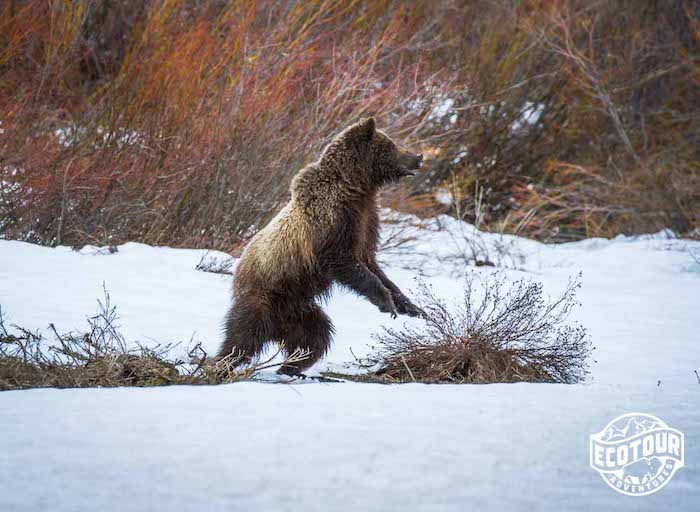
The fantastic mammal migrations of the Greater Yellowstone Ecosystem also begin in late winter. Soon, thousands of elk, deer, and pronghorn antelope will make epic migrations across the ecosystem, gorging on the lush green vegetation which follows melting snows. These migrations are a sight to behold, you can almost feel the landscape take a big inhale as it wakes up from the long winter.
Responsible Wildlife Watching
Now that you are familiar with some of the best spots to look for winter wildlife in Jackson Hole, it's important to remember that this is the hardest time of year for many of these animals. That’s why Ecotour Adventures is a business sponsor of the Don’t Poach the Powder campaign, which seeks to educate the public on critical winter wildlife habitat closures throughout the valley.
By viewing wildlife from afar with our Maven binoculars and spotting scopes we seek to avoid disturbing wildlife who are relying on finite fat reserves to get through the winter.
It’s a great time of year to see the winter wildlife of Jackson Hole, if you liked this article please share it (LINK ON FB) and let us know what you think in the comments! Also consider joining one of our experienced guides on a premium wildlife safari of Grand Teton this winter or spring, it’s an experience you won’t forget.
You can view live availability 365 days a year online via the “Book Now” button, call us 307-690-9533 or email info@jhecotouradventures.com for more information.
- Story by Naturalist Josh Metten, see more of his photos on Instagram: @joshmettenphoto
Guest Testimonials:
“I had a wonderful time on Eco Tour Adventures’ Winter Wolves and Wildlife Tour. The diversity of the tour, and the knowledge of the guide, was incredibly satisfying and I learned and enjoyed it so much.” - Joan, NY
“I was very impressed with the guide, his knowledge, and all of the attentiveness to detail and caring about each one of us! I learned so much and it was also such an enjoyable getaway for our family. I highly recommend you take a trip with Jackson Hole Ecotour Adventures.” - Sarah, NM
Best Cross Country Ski and Snowshoe Trips in Grand Teton National Park
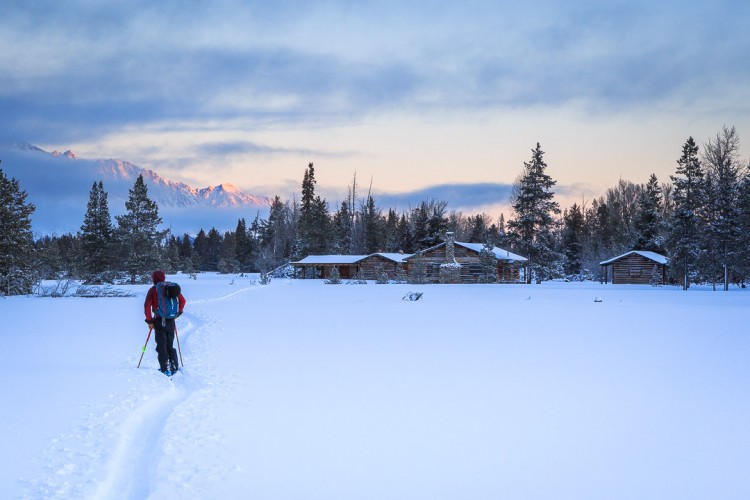
Jackson Hole Winter Wildlife, Cross Country Skiing, and Snowshoe Holiday Gift Guide
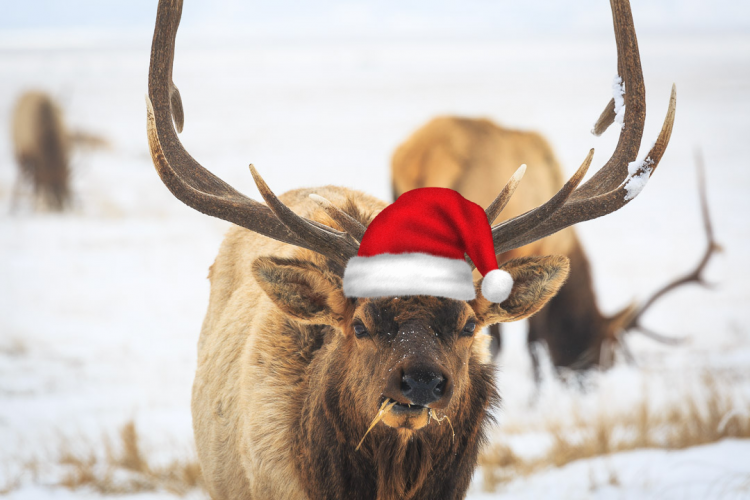
Share the Gift of the Greater Yellowstone Ecosystem
Thinking about what to get your loved ones for the holidays? Give them the gift of the Greater Yellowstone Ecosystem with EcoTour Adventures!
Gift Cards can be used towards any of our trips.
Winter Wildlife Enthusiasts Will Love:
Grand Teton Half Day Winter Wildlife Tour - With thousands of animals concentrated in the Jackson Hole Valley, winter is one of our favorite times to observe wildlife without the crowds of summer! Join us as we observe Elk, Bison, Bighorn Sheep, Wolves, Moose, Bald Eagles, Trumpeter Swans and more beneath the majestic Teton Range. ——-> Learn More Here
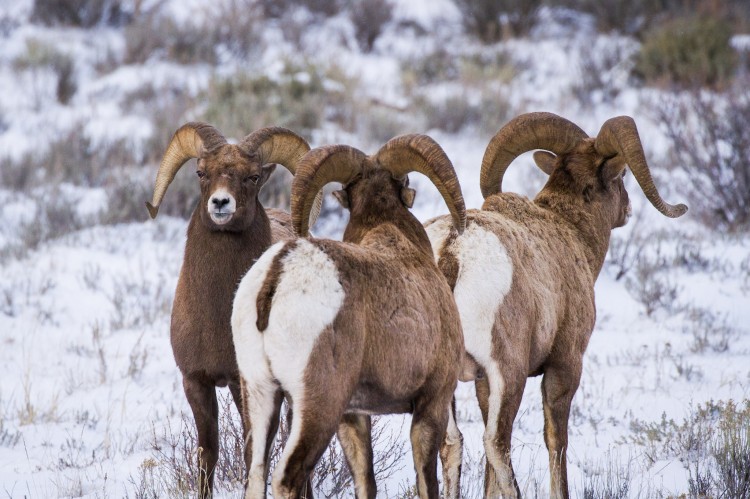
Winter Wolves and Wildlife of Yellowstone Multi Day Tour - SAVE 10% when you book before December 24th with Code ETAmulti10! Join us this winter exploring Yellowstone's Northern Range, home to four wolf packs and hundreds of wintering bison, elk, bighorn sheep and other diverse wildlife. Departure dates coincide with peak wildlife activity and the quietest time of year for visitors, meaning Yellowstone is ours to explore free of crowds! We'll also enjoy a private snowcoach tour into Yellowstone's snowy interior an private presentation with a Yellowstone Wolf Biologist.
Click here for full tour information
2020 Departure Dates January 30- February 3rd 2020
Check Availability: 307-690-9533 or info@jhecotouradventures.com
Winter Adventures in Grand Teton:
Grand Teton Half Day Snowshoeing Tour - Explore the Winter Wonderland of Grand Teton National Park on snowshoes with our experienced naturalists. We'll study track and sign, winter ecology, and snow science as we make fresh tracks beneath the majestic Teton Range. All ability levels are welcome, and we provide all of the necessary snowshoeing equipment. ——-> Learn More Here
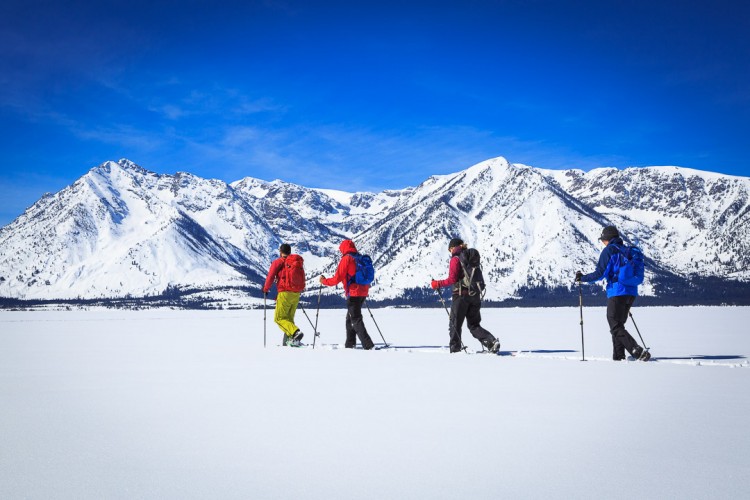
Grand Teton Half Day Cross Country Ski Tour - New to Cross-Country Skiing and want to learn how while taking a tour with an expert Naturalist? Join one of our PSIA Certified Naturalist Guides on a snowy adventure through Grand Teton National Park!
Click here for full tour information.
Gift Cards are also available here!
Summer Tours for the Whole Family
Grand Teton Half Day Wildlife Tour - Explore the best wildlife hotspots in Grand Teton National Park with our skilled naturalists. We'll search for moose, elk, bison, pronghorn antelope, mule deer, wolves, black bears, grizzly bears, bald eagles, trumpeter swans and more on this 4 our sunrise or sunset tour. ——-> Learn More Here
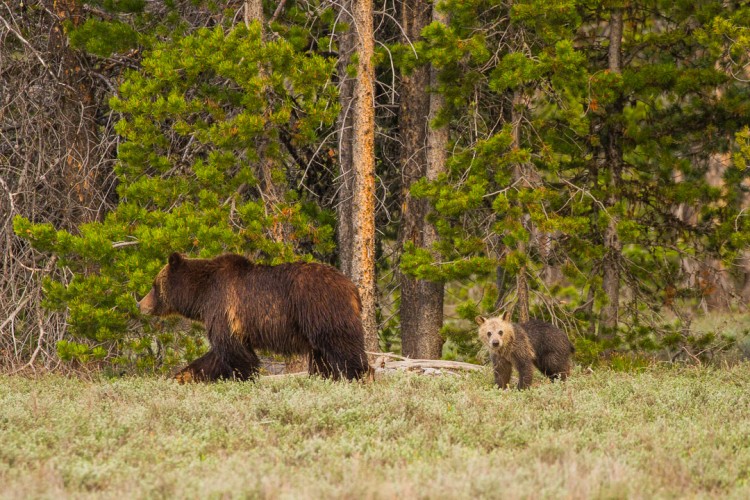
Yellowstone Full Day Tour - Explore the worlds first National Park on our full day Yellowstone Tour. Our experienced guides are local experts on the regions geology, ecology and wildlife with an unmatched passion for the Greater Yellowstone Ecosystem.
Click here for full tour information.
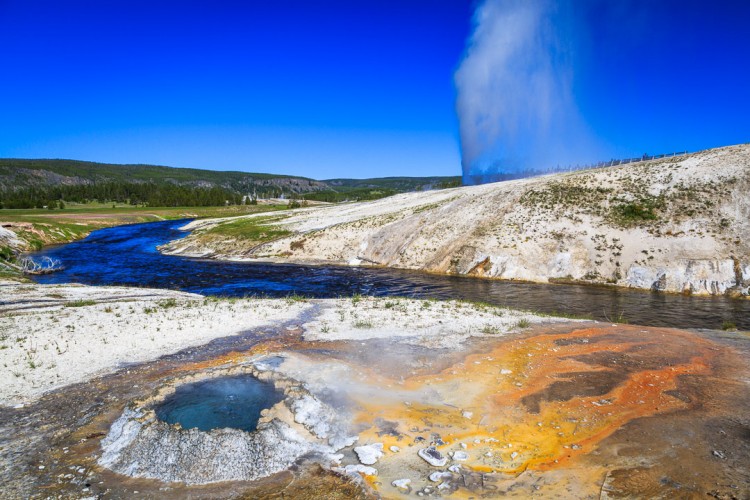
Grand Teton/Yellowstone Multi Day Tour - SAVE 10% when you book before December 24th with Code ETAmulti10! Discover the best of the Greater Yellowstone Ecosystem on a Multi Day Tour with EcoTour Adventures, Starting in Jackson Hole, we'll explore the geology and wildlife of Grand Teton National Park before embarking into the interior of Yellowstone. 10,000 thermal features, the largest wild bison herd in the world, wolves, bears, and diverse wildlife await.
Click here for full tour information.
Check Availability: 307-690-9533 or info@jhecotouradventures.com
Let them Choose with a Gift Card!
Let your loved one decide the best trip for them with an EcoTour Adventures Gift Card! Choose your amount here!
Now in our 11th year of operation, Jackson Hole Ecotour Adventures leads wildlife safaris, cross country skiing tours, and snowshoe tours in Grand Teton and Yellowstone National Parks 365 days a year. Let us help maximize your Jackson Hole Experience Today! 307-690-9533 info@jhecotouradventures.com
Best Winter Activities in Jackson Hole and Grand Teton National Park
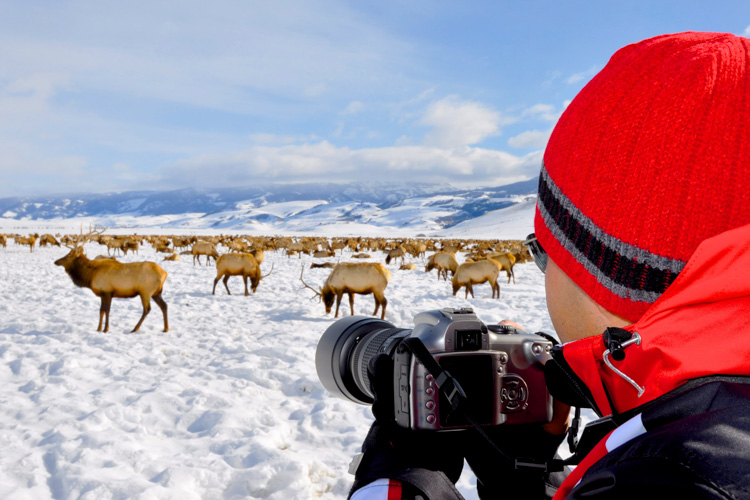
Want to make the most of winter in Jackson Hole, WY? From world class skiing at Jackson Hole Mountain Resort to the stunning landscapes and wildlife of Grand Teton and Yellowstone National Parks, we've compiled a list of the best winter activites in Jackson Hole and Grand Teton National Park.
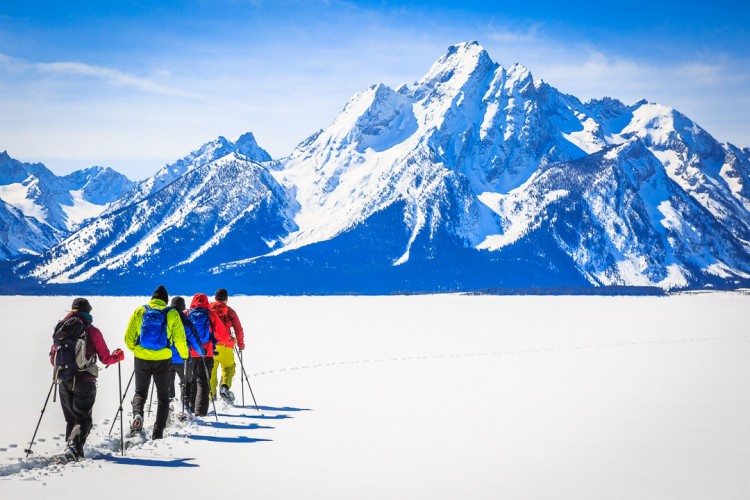
1. Snowshoeing and Cross Country Skiing in Grand Teton National Park
Some of the best nordic skiing in the country can be found below the towering peaks of Grand Teton National Park. From the Bradley-Taggart Trailhead 14 miles of groomed trail await for classic or skate skiing. Many nordic skiers will enjoy traveling off trail to follow the meanders of Cottonwood Creek or visit the Lucas Fabian Homestead.
For those not wishing to ski, snowshoeing is an easy activity for any ability level to encounter the winter wonderland of Jackson Hole as well. One of our favorite areas to explore is the Granite Canyon Trailhead near Jackson Hole Mountain Resort.
Our friends at JHNordic have a great database of routes to try out on your own, we also offer guided cross country and snowshoe tours. Our experienced Nordic Naturalists come with a wealth of information about winter ecology, off the beaten path places to explore, and are PSIA certified Nordic Instructors offering tips and tricks to improve your skiing techniques. Check out our Half Day Snowshoeing and Full Day Snowshoeing programs and Half Day Cross Country and Full Day Cross Country Ski Tours.
We are happy to accommodate any ability level and will provide all of the necessary snowshoeing equipment.
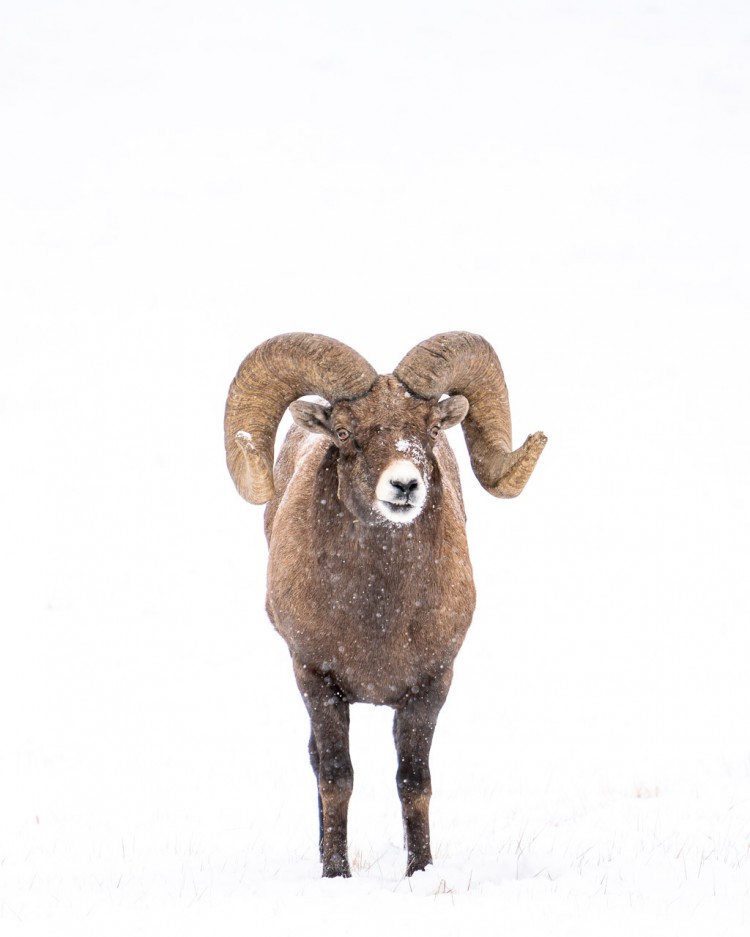
2. Experience the Winter Wildlife of Jackson Hole!
With world class skiing and world class wildlife residing in the same valley, Jackson Hole is like nowhere else on earth. The valley floor provides critical winter range to large herds of wildlife, including elk, mule deer, bighorn sheep, moose, bison, and pronghorn antelope. With the 25th anniversary of Wolf Reintroduction coming up in January, winter is a great time to look for wolves in Grand Teton and Yellowstone National Park. Likewise, golden and bald eagles, arrive in large numbers to scavenge on those unable to survive winter’s grasp. Waterfowl, including trumpeter swans and many species of ducks congregate on the spring fed waters of Flat Creek. Let the experienced naturalists at Jackson Hole Ecotour Adventures show you the best the “American Serengeti” has to offer in a half day, full day, or multi day trip!
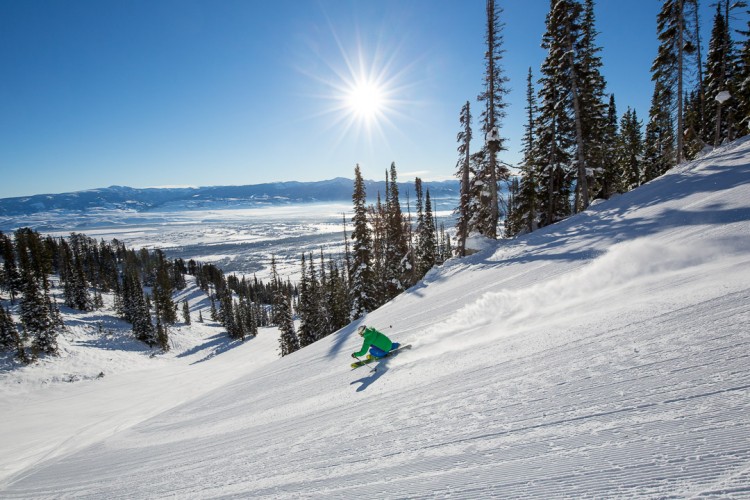
3. Skiing at Jackson Hole Mountain Resort, Grand Targhee and Snow King
The world class downhill skiing and snowboarding of Jackson Hole Mountain Resort consistently earns the top ratings in National Polls. Though the resort is known for extreme skiing, it's beginner and intermediate terrain offers plenty of options for all abilities. Riding the tram over 4000’ vertical feet takes you to the high alpine, complete with views of the Grand Teton. This is the home of the wolverine, perhaps North America’s toughest athlete, though thrill seekers at the resort will attempt to keep up!
Other nearby resorts include Grand Targhee, located on the western side of the Tetons, which offers its own view of the Tetons. Those staying in Jackson may want to explore the slopes of Snow King, or the town hill. Snow King also offers tubing, ice skating, a mountain coaster and more.
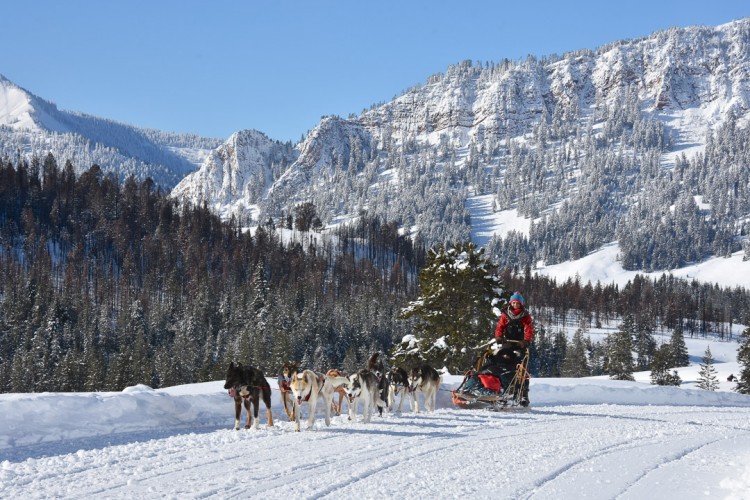
4. Dog Sledding with Iditarod racer Frank Teasly.
Want to explore some other nearby mountains by dogsled? Iditarod racer Frank Teasly offers guided dogsled trips into the Gros Ventre Mountains and Granite Hot springs! The beautiful route takes you 9 miles up Granite Creek in the Bridger Teton National Forest. Call 307 733-7388 to book!
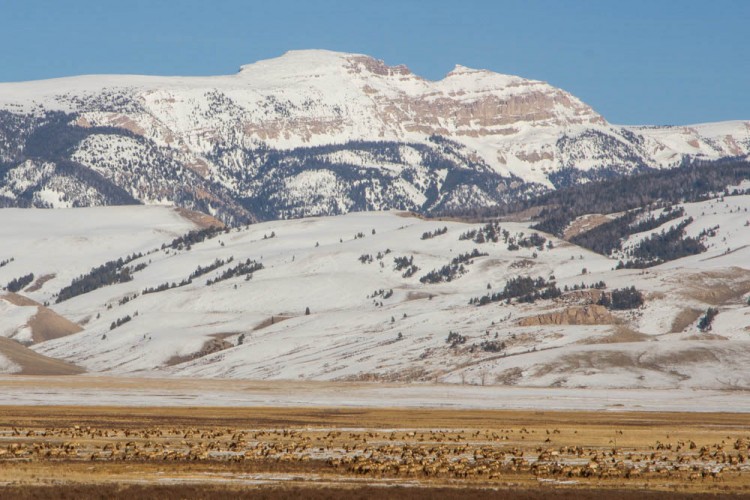
4. National Elk Refuge
Established in 1912, the National Elk Refuge is a winter refuge for thousands of elk, some from as far north as Yellowstone National Park. Many other animals are found on the refuge as well ranging from abundant bird life to bison, pronghorn antelope bighorn sheep, and wolves! Sleigh Rides can be arranged by visiting the Greater Yellowstone Visitor Center, which currently has a fantastic exhibit on winter adaptations, and beginning on the 26th of December, the pronghorn migration. Ecotour Adventures also offers a Winter Wildlife Experience which includes a morning safari in Grand Teton National Park and the Refuge, a sleigh ride out to the elk herd, and a visit to the nearby National Museum of Wildlife Art!
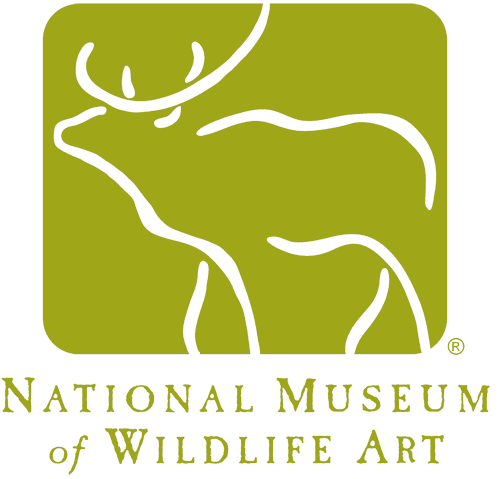
5. National Museum of Wildlife Art
One of the best collections of wildlife art in the world is found right here in Jackson, WY. The National Museum of Wildlife Art, designed to blend into the surrounding hillside of the East Gros Ventre Butte, overlooks the National Elk Refuge. Winter wildlife are often abundant surrounding the museum, we’ve even seen elk and deer walking amongst their own likenesses in the sculpture garden! The museum is a welcome respite from winter’s chill, and visits can be combined with a refuge sleigh ride and morning wildlife safari from Jackson Hole Ecotour Adventures for a complete winter wildlife experience.
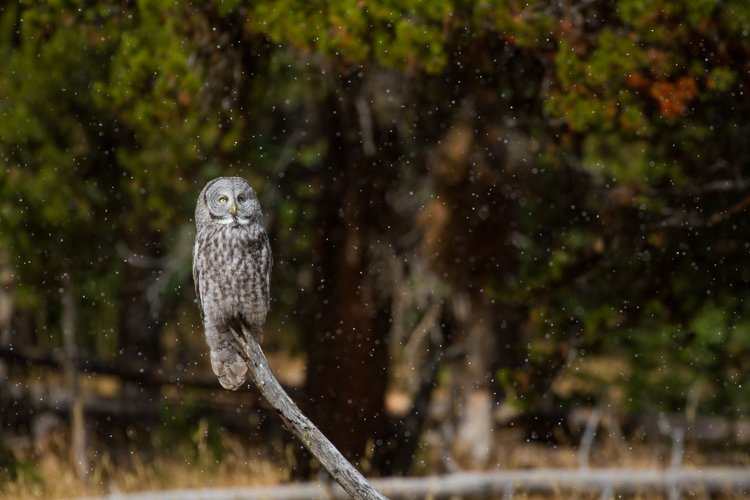
6. Raptor Encounters with the Teton Raptor Center
Enjoy an hour-long educational experience with live raptors at the historic Hardeman Ranch in Wilson, Wyoming, suitable for all ages. Meet our resident raptors and learn about birds of prey in the Greater Yellowstone Ecosystem. A portion of the program is outside, so please dress accordingly. Raptor Encounters are Saturdays at 2pm and reservations are required.
We hope that this list of the best winter activities in Jackson Hole and Grand Teton National Park helps maximize your winter experience, please let us know if you have any questions or need help planning a vacation here!
Josh Metten has spent his entire life exploring and living in the Rocky Mountains of Colorado and Wyoming. He is an Ecotour Adventures naturalist, photographer, conservationist, and outdoor enthusiast. Josh lives in Jackson, WY.
Eco Tour Adventures was created with the idea of helping people connect with the natural world through wildlife observation and natural history interpretation. We believe that when one is more familiar with the intricate workings of the ecosystem, he or she has a deeper appreciation and connection with their environment. Join us on an adventure today!
Where to Watch the Elk Rut in Grand Teton and Yellowstone National Parks
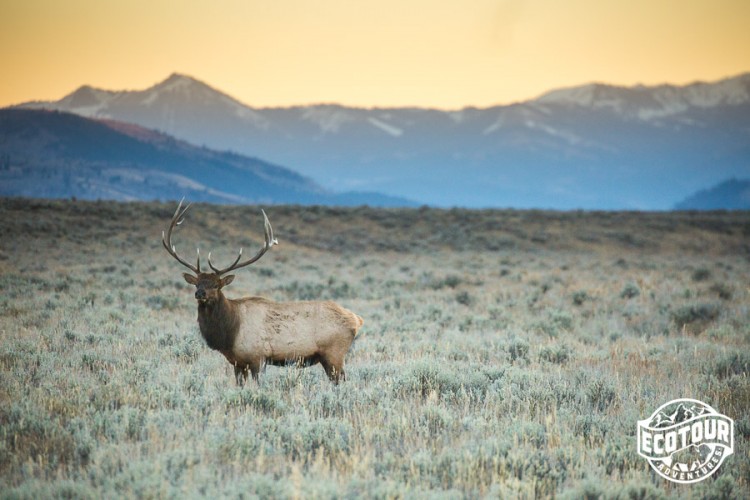
It’s a spectacle which occurs just once a year. Antlered giants emerge from dark timber and announce their dominance with a loud bugling call that echo's through golden aspen forests. The fall elk rut is here, offering wildlife enthusiasts an unparalleled opportunity to view this amazing behavior beneath the rugged peaks of Grand Teton and Yellowstone National Parks. It’s one of our favorite times of year, read on to learn why.
Why Spend the Energy Growing Antlers and Fighting?
The bugling of a bull elk represents the culmination of tens of thousands of years of evolution and adaptation to a harsh landscape. Locked in an evolutionary arms race with their dominant predator, the wolf, elk are just big enough and just fast enough to outpace wolves when healthy. With their larger size and dominant herd nature, elk outcompete smaller herbivores like deer, gaining access to the best forage areas throughout the year.
All of these adaptations are a result of sexual selection during the fall mating season. A bugle emits from a dominant bull, his challenge to other bulls and invitation to female herds. Should another bull respond to his call, the two may meet, standing broadside at a short distance, sizing the other up. Often the smaller bull will retreat, but if evenly matched the pair may lock antlers, wrestling in a test of strength. These sometimes deadly contests attract the attention of female elk who observe the spectacle, likely deciding which males to stay near when they reach estrus, or receptivity to mating.
Antler growth and physical competition for mating opportunities mean the best genes are passed onto the next generation who must face life in a challenging environment. We now know that bulls who keep antlers longer during the winter months can use them as effective weapons as well, decreasing their chances of predation.
However, this strategy is also paradoxical. Antlers are a major energy investment, forcing bulls to seek out riskier habitats for forage opportunities. The added weight also presents a challenge, adding up to over 30 lbs in large bulls!
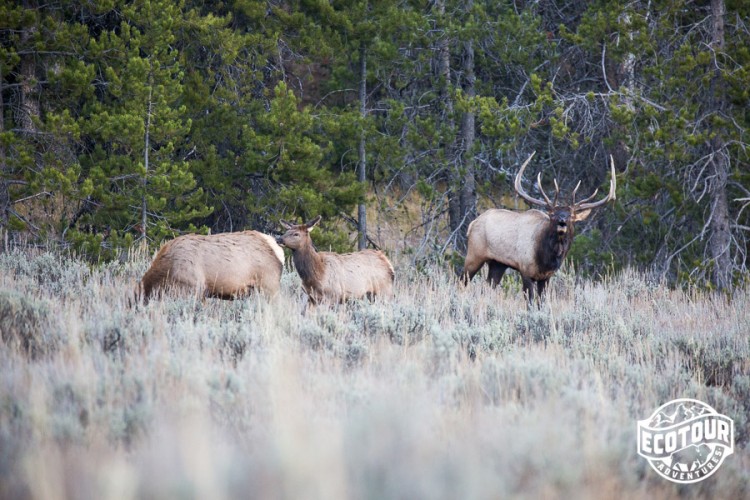
Bulls may lose up to 10% of their body weight during the fall mating season, females by comparison are still feeding during this time and put on up to 50lbs of fat in order to survive winter while carrying a full term pregnancy! As a result mortality from starvation, exposure, and predation is higher in winter for bulls than other classes of elk. Yet during the rut bulls seem blissfully unaware of all this, focused solely on pursuing cows and fighting other bulls.
Where to Find Bugling Elk and Other Wildlife in Wyoming
Though elk were historically found across the United States, today most populations, and viewing opportunities, are concentrated in the West. Grand Teton and Yellowstone, along with Rocky Mountain National Park in Colorado, offer up some of the best opportunities to easily view bugling elk. We’re biased in favor of the first two, who also offer opportunities to see grizzly bears, bison, and wolves, none of which are currently found in RMNP.
To find elk in Grand Teton we recommend starting your day before dawn and heading out to the base of the Teton Range. Elk tend to emerge in open meadows in the early hours of the morning before retreating into cover as the day warms. They will repeat the process in the evening as the sun sets over the mountains.
Elk are often viewed along the Madison River in Yellowstone, in the Hayden and Lamar Valleys and in the Mammoth area. Currently the Park preserves the green grass lawns of Historic Fort Yellowstone. This food source draws elk into the developed area of Mammoth Hotsprings, be careful to keep your distance of 25 yards or more as bulls have been known to charge people and vehicles during this time of year!
Wyoming's Wildlife Recreation Economy
Today thanks to decades of dedicated conservation work, the wildlife of the Greater Yellowstone Ecosystem occur at a greater abundance and diversity than any other time in the last 100 years. A recent study from the University of Wyoming values the Wildlife Recreation Economy at over $1 Billion annually, over 50% of which comes from wildlife watching in places like Grand Teton and Yellowstone.
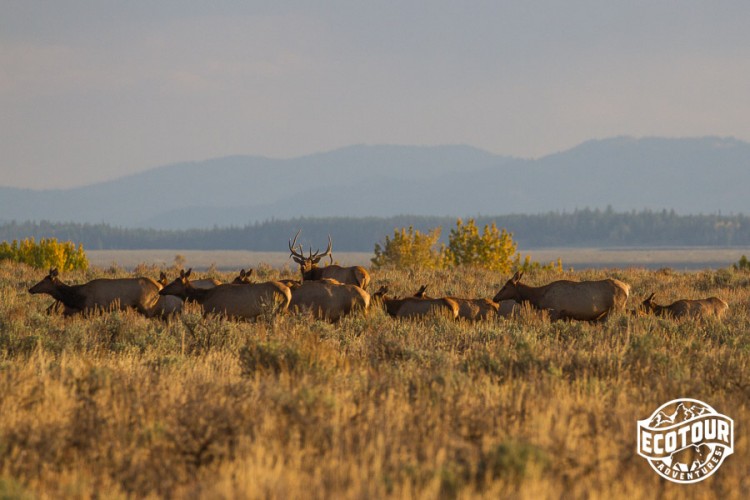
Hunting also remains an integral part of Wyoming culture and our economy. With abundant public lands, elk hunters are now pursuing bugling elk in hopes of filling their freezers with wild meat. It’s a largely sustainable practice, carefully managed to ensure a future for elk and the hunters who seek opportunities to interact with the wild.
Inside our National Parks, visitors from all parts of the world have an opportunity to enjoy bugling elk without hunting pressure, an intimate glimpse into an otherwise elusive behavior. At EcoTour Adventures we feel fortunate to live and work in a State where both are possible.
Please let us know if we can help with guiding your next adventure in Grand Teton or Yellowstone National Parks by calling us 307-690-9533 or emailing info@jhecotouradventures.com.
Jackson Hole Ecotour Adventures leads wildlife safaris, cross country skiing tours, and snowshoe tours in Grand Teton and Yellowstone National Parks 365 days a year. Let us help maximize your Jackson Hole Experience Today!
Secrets to Successful Wildlife Watching in Grand Teton and Yellowstone Part 2: Tools of the Trade, Safety and Ethics
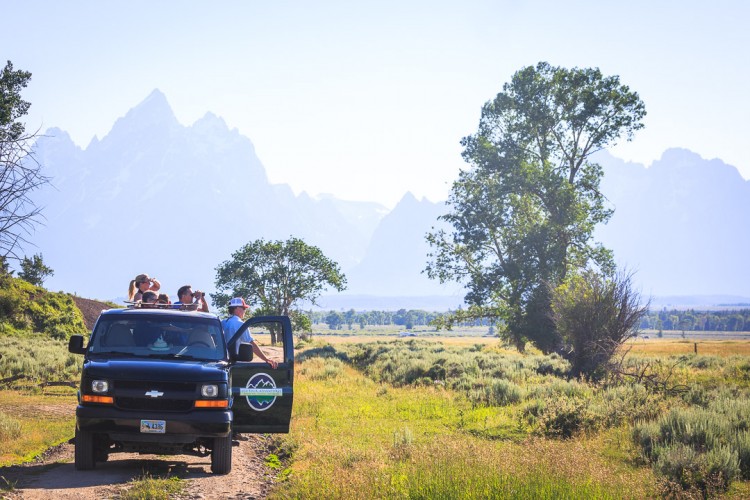
In Part One of our “Secrets to Successful Wildlife Watching in Grand Teton and Yellowstone” blog we outlined Wildlife Watching Through the Seasons. Now let’s look at what you need to have the best experience possible.
Tools of the Trade
Optics - At 2.5 million acres, Grand Teton and Yellowstone occupy a vast landscape, and optics are critical for spotting and watching wildlife. We use Lander, WY based Maven Optics for both binoculars and spotting scopes.
8x42 C.1 binoculars are a good bet for all purpose wildlife and bird watching. The first number, 8 means a magnification of 8x, while the second number, 42 is the diameter of the binocular glass. A bigger diameter means more light transmission and a clearer image. I personally use the 9x45 B.2 to get a bit more magnification, but have to deal with a heavier binocular as a trade off. With up to 50x magnification, the S.1 Spotting Scope is our go to for viewing wildlife such as wolves and grizzlies from afar. Both binoculars and spotting scopes are also useful for viewing small animals like birds up close. The color and plumage of birds up close is surprisingly stunning, just one reason why bird watching is so popular across the globe.
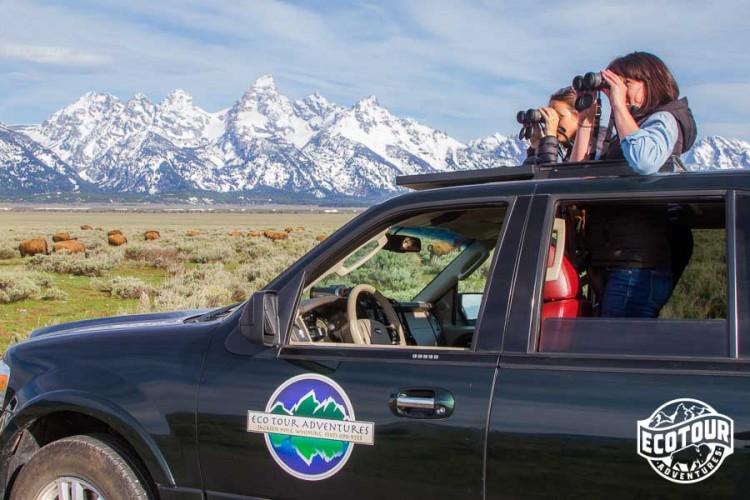
Binoculars and our Roof Hatches allow for safe viewing, especially when wildlife are close to the vehicle!
Camera - Professional and amateur photographers alike flock to Yellowstone and Grand Teton especially during the spring and fall, sporting giant expensive lenses and tripods. This option may be available to some, but there are some less expensive camera/lens options. I recommend a telephoto lens around 100-400mm for wildlife photography, and a wider angle lens like a 24-105mm for landscapes.
PhoneSkope Adaptor - The evolution of camera phones has recently created some great opportunities when combined with spotting scopes or binoculars for digiscoping - taking pictures through optics. We use Phoneskope phone adaptors and rings to attach phones to our spotting scopes on tours, and our guests leave with great photo and video from the trip!
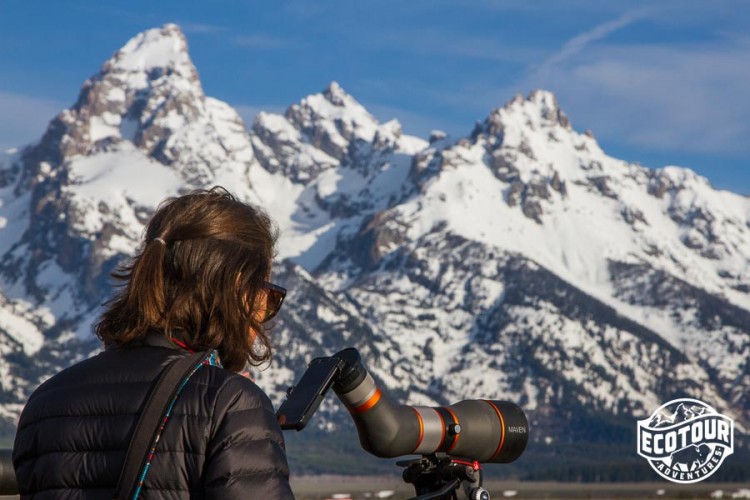
PhoneSkope Adaptors allow us to take clear video and photos through our Maven S.1 Spotting Scopes.
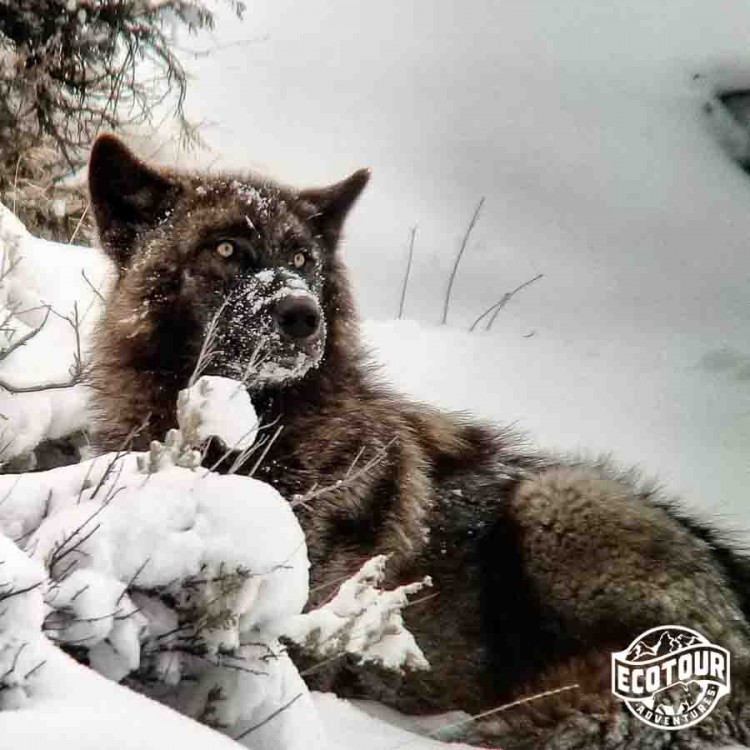
Guide Verlin Carlton captured a photo of this black wolf using his cell phone and phoneskope adaptor while on tour in Grand Teton National Park!
Local Knowledge - When a few of the EcoTour Adventures Team visited South Africa’s Kruger National Park for a week of wildlife watching, we hired a local guide who could show us where the wildlife hotspots were. Being able to sit back and enjoy the sights while someone else drove, shared information about what we were seeing, and had a good spotters eye was worth every penny. That’s why your best Tool of the Trade is the local knowledge of an experienced guide. Guides familiar with the area know wildlife habits, increasing your chances of that once in a lifetime sighting while facilitating a deep connection to place.
Safety and Ethics of Wildlife Watching
With all the excitement around Yellowstone and Grand Teton National Parks, visitors and locals alike need to be aware of how to safely and ethically view wildlife. NPS guidelines state that wildlife must be viewed from 25 yards or more, 100 yards if it is a bear or wolf. If we visibly change the animals behavior we are too close. Millions of visitors visit the parks annually hoping for views of wildlife, so it’s important to give wildlife space, they likely interact with people frequently!
Bear Safety
A common concern among visitors to Yellowstone is bears. Though grizzlies in particular can be dangerous, only 8 people have been killed since the founding of the park in 1872! We always recommend carrying bear spray, traveling in groups and making noise when traveling away from vehicles.
Bear spray needs to be carried for immediate access, you can’t ask a bear or charging moose to wait while you fumble around for it in your backpack. If you encounter a bear make noise and slowly back away. If it charges within 30 feet spray your can towards the bear at a downward angle so it hits the ground and creates a cloud which the bear will run through. It’s over 90% effective, and doesn’t kill the bear either. Be aware that cans can explode in a hot vehicle or if dropped and punctured. As someone who has been sprayed before I can attest it’s extremely unpleasant. It won’t kill you but you will remember the burning sensation.
Stewarding Wildlife of the Greater Yellowstone Ecosystem for the Future
It’s clear that more and more nature starved urbanites crave the wildness of places like the Greater Yellowstone Ecosystem. Though the massive bison herds who once roamed the Great Plains remain ghosts, they persist in the Hayden and Lamar Valleys. Wolves, grizzlies, and mountain lions still hunt here, sustained by the epic migrations of over 10,000 elk in and out of the park’s each year. Today, thanks to over a century of dedicated conservation work the Greater Yellowstone Ecosystem has a richer biological diversity and abundance of wildlife than any time in the last 130 years. Yellowstone and Grand Teton National Parks offer a snapshot into our wild past, so what are you waiting for, come see it for yourself!
Josh Metten is a Senior Naturalist and Photographer for Jackson Hole EcoTour Adventures
Join us on an adventure in Grand Teton or Yellowstone National Park by calling us 307-690-9533 or emailing info@jhecotouradventures.com.
Now in our 11th year of operation, Jackson Hole Ecotour Adventures leads wildlife safaris, cross country skiing tours, and snowshoe tours in Grand Teton and Yellowstone National Parks 365 days a year. Let us help maximize your Jackson Hole Experience Today!
Secrets to Successful Wildlife Watching in Grand Teton and Yellowstone Part 1: Through the Seasons
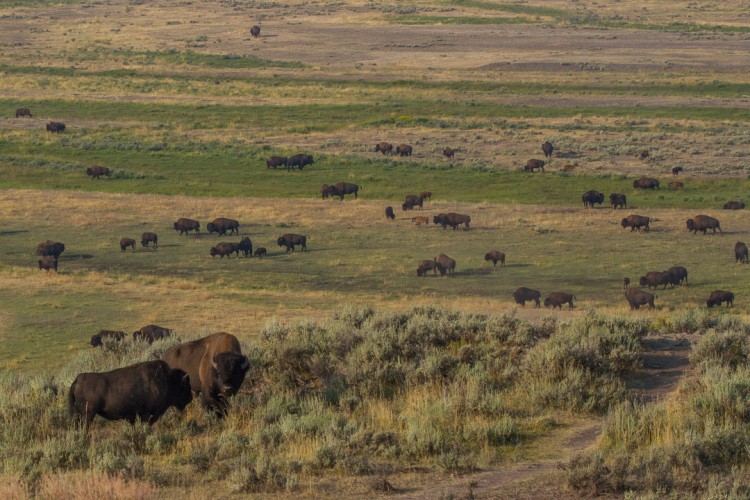
“The American Serengeti” - a landscape filled with herds of bellowing bison, sprinting pronghorn antelope, bighorn sheep standing atop cliffs, grizzlies and wolves hunting in wildflower filled meadows. Views like these were commonplace during the time of Lewis and Clark, but largely vanished due to market hunting throughout the 1980’s.
But not all was lost, and today thanks to over a century of dedicated conservation, the American Serengeti still has a home, Yellowstone. Today, the wild lands of the Greater Yellowstone Ecosystem host the greatest abundance and diversity of wildlife that has been found here in the last 130 years!
From the largest remaining herd of wild bison, to hundreds of bird species, massive elk, deer, and pronghorn migrations, wolves, grizzlies and mountain lions, Yellowstone and Grand Teton National Parks are a wildlife viewing hotspot. Want to make the most of a trip to see wildlife in the Greater Yellowstone Ecosystem? Read on.
Summer: June-August
As melting snow hydrates the landscape an explosion of plant and animal life emerges across the GYE. The ecosystems 1000+ plant species form the base of a diverse food web and as wildflowers peak in June and July so do sightings of baby animals. Elk, mule deer, bighorn sheep, mountain goats, pronghorn antelope, and moose all calve in late May or early June. This timing serves two major evolutionary advantages.
The arrival of so many animals literally swamps predators, such as black and grizzly bears, coyotes, golden eagles, and wolves. Within a few weeks, the calves are large enough to flee predators more successfully and overall predation is limited. Last year on a Teton wildlife tour, we observed a black bear locate a bedded pronghorn fawn and give chase, only to realize he was no match for the speedy fawn, who easily disappeared.
Perhaps the most important reason to calve in spring is our short summer season and harsh winters, which present an even more formidable challenge than predation, the possibility of starvation. The small stomachs of young animals limit their ability to consume critical forage before the coming winter, so they must take advantage of the entire summer to grow.
Angry August: The Bison Rut!
As summer marches on across the GYE the days grow hot and dry. Angry August is near. In Yellowstone’s Lamar and Hayden Valleys and the Jackson Hole Valley of Grand Teton National Park, bison, our largest animal found in the GYE congregate for an annual event, the rut or mating season. Though the bison rut often gets going in Late July, we generally observe peak behavior in August. As testosterone peaks, bull bison rejoin female herds, bellowing, scent marking and kicking up dust in wallows and fighting as they seek to establish a dominance hierarchy. The rut is fatal for some, providing scavenging opportunities for wolves, grizzlies and other scavengers.
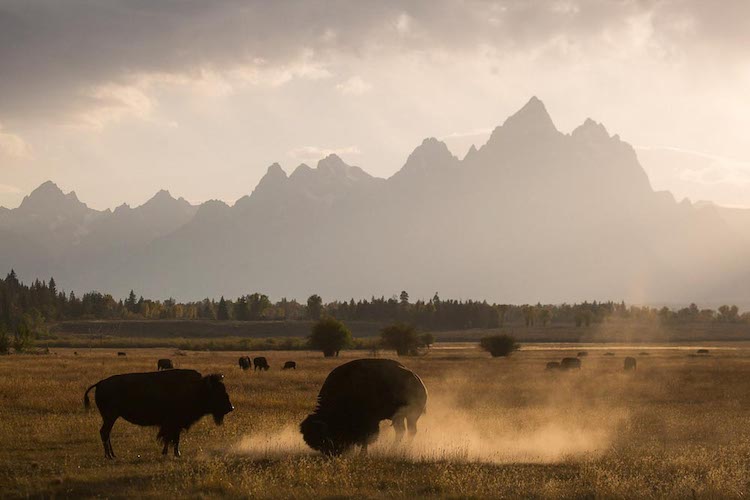
Dominant bulls “tend” to females who are near estrus (receptive to mating). Look for a “flehmen response” where bulls tilt their heads and curl their lips upward before freezing in place. This behavior allows bison and other animals to send scent to a specialized gland which can tell them if a female is receptive to mating.
Fall: September - November
The bison rut is the first of the upcoming mating seasons for ungulates in the GYE. As bison cool down, we start to observe their speedy neighbors, pronghorn antelope, heating up. Dominant buck pronghorn have an exhausting job, constantly chasing other males out of their territories while herding groups of females back in. This behavior may serve as an adaptation keeping the species fleet footed, pronghorn once needed to out run the now extinct North American Cheetah. All this running can mean male pronghorn lose up to 10% of their body weight right before winter!
Bugling Bulls Beneath the Tetons
For many, including myself, the peak event of the mating season starts with frosty mornings and golden aspen trees. A lone bugle emits through the still air and a champion emerges, it’s a bull elk. Growing up near Rocky Mountain National Park, my family and I took annual trips to watch these giants battle to control herds of cow elk. Today my EcoTour Adventures Guests and I watch them in open meadows beneath the awe inspiring Teton Mountain Range.
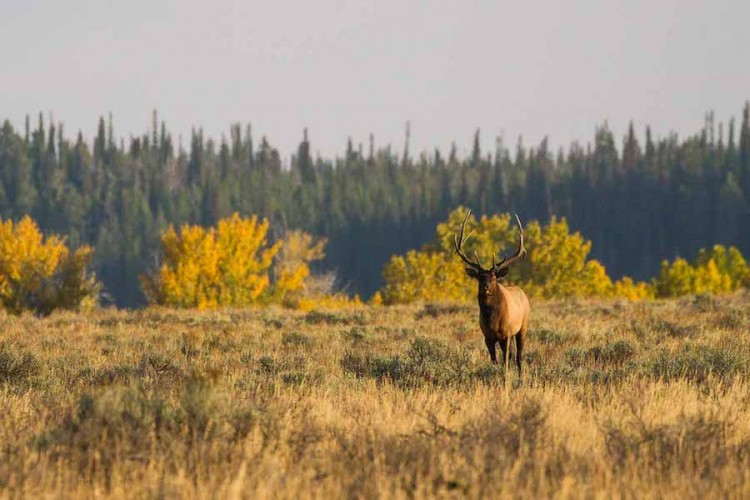
Photograph elk and other wildlife during our Fall Photography Workshop, we have just a few spots left!
Moose, our largest deer species are also courting during this time, choosing the golden forests of cottonwood trees in river bottoms to meet. Bull moose, weighing in at around 1000 lbs, begin to concentrate near females, both sexes generally remain solitary during most of the summer.
Bears!
Fall wildlife activity is already packed without the addition of some of the best bear activity of the year! Both Black and Grizzly Bears become highly active in the fall as high calorie content food sources like berries, whitebark pine cones, and carcasses from the bison rut become available. During this period, known as hyperphagia or “over eating” the bears consume upwards of 20,000 calories a day!
Both Grand Teton and Yellowstone National Parks become hotspots for bear viewing during this time. Don’t forget to “be bear aware” by 1. Keeping a 100 yard distance from bears, 2. Travel in groups and make noise, and 3. Carry Bear Spray and know how to use it!
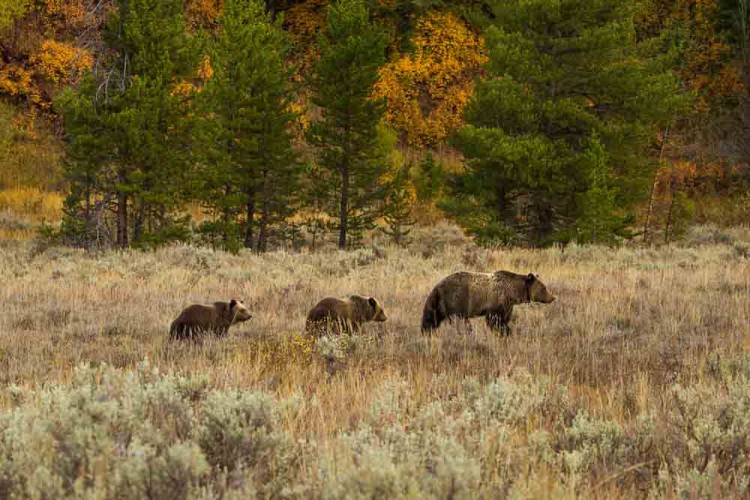
Fall Migrations
At any point in the fall the first snow may come, blanketing the Greater Yellowstone Ecosystem in white. It’s a signal for our great herds of wildlife to begin epic migrations out of the high country and back towards winter habitat. Wildlife biologists have mapped 10 major elk migrations out of Yellowstone as well as the longest known pronghorn (100 miles!) and mule deer (250 miles!) migrations in the world, and you can catch them in action right here.
Winter: December - March
As winter storms loom, the roads of Yellowstone and Grand Teton begin to close for the season. This year (2019) Dunraven Pass and the Beartooth Highway close October 15th, with the remainder of the park’s interior roads closing on November 4th. The Teton Park Road, one of our favorite spots to look for bugling elk in fall, closes on November 1st for the winter.
But don’t let the limited road access discourage you, for wildlife enthusiasts, winter is one of the best times to observe wildlife in the GYE. Here’s why.
Concentrated Wildlife
In winter, wildlife come to us in Jackson Hole. The 11,000 strong Jackson Hole herd, formerly dispersed across the National Forest and National Parks now concentrates in the valley, thousands of them wintering on the National Elk Refuge just outside of the town of Jackson. They’re joined by bighorn sheep and mule deer taking refuge from deep snow in the high country.
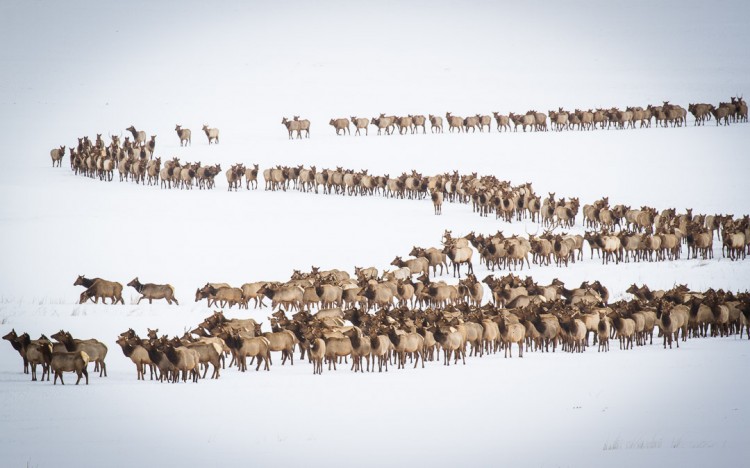
At no other time of year are wildlife as concentrated as in winter, including predators like wolves and the occasional mountain lion. Scavengers, including coyotes, golden and bald eagles are also more visible, I’ve observed more than 30 eagles from one viewpoint on the Refuge before.
Flat Creek, a spring fed creek which winds across the Refuge remains free from ice for much of the winter, attracting numerous species of ducks and hundreds of the once critically endangered Trumpeter Swan. Migratory rough-legged hawks are often seen perching along the Refuge, they’ve traveled over 2000 miles from above the arctic circle to get here!
To the north, in Grand Teton National Park, the snowy fields of Antelope Flats attract moose who concentrate in numbers not seen during other times of year. They are here to feed on antelope bitterbrush, a shrub with more easily digestible stems which helps get them through the winter.
Nordic Skiing and Snowshoeing
Winter is also a peaceful time to explore the silent winter wonderland of Grand Teton and Yellowstone National Parks on cross country skis or snowshoes. Winter is an ideal time to study the track and sign of winter wildlife, each snowstorm brings a blank canvas on which they write. The diverse and abundant wildlife found here means tracking a porcupine one minute, then finding mountain lion tracks, then a pile of fur and quills where the two met. Stories like these which unfold in the snow are one of our favorite parts of winter.

Wolf Watching
There is no better time to search for wolves than winter, and though Grand Teton can be a good option, the Northern Range of Yellowstone reigns supreme as a top location for wolf watching in the lower 48 states. Over 150,000 people visit Yellowstone annually with the specific intention of wolf viewing, generating over $35 million in economic activity for surrounding communities.
Wolves, like many other wildlife species were systematically eradicated from most of their historic range in the 1800’s and early 1900’s. Their return in 1995 is one of the greatest conservation success stories of the Greater Yellowstone Ecosystem. Though wolves can be viewed any time of year I recommend the wolf mating season in late January/February.
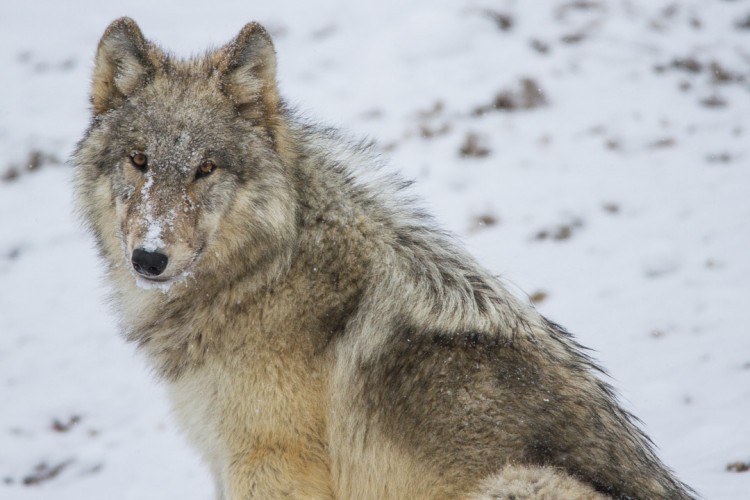
Sparse Crowds in Yellowstone’s Winter Wonderland
To enter Yellowstone’s snowy interior in winter, one must join a guided snowmobile or snow-coach trip. Visitors to this winter wonderland can enjoy the usually crowded thermal features with a select few, some of whom may be a bit more hairy and hooved. The interior bison herd migrates to thermal areas in winter to take advantage of shallow snow.
Spring: April-May
Even the toughest bison longs for coming spring, and so do I after 5 months of winter! Spring comes on slow in the Greater Yellowstone Ecosystem but the tiny green shoots which follow melting snow are a promise of the bounty of summer to come. Wintering elk and deer herds are now reaching the end of their fat reserves and set out to retrace the great migrations of fall in reverse. Experienced matriarchs lead their herds in surfing the green wave of spring towards the promise of summer.
Migrations on the Wing cross Continents, and Hemispheres!
As our big game herds begin their march towards summer so do the winged migrations across the Greater Yellowstone Ecosystem. With close to 300 documented species of birds, Yellowstone and Grand Teton are a birders paradise, especially in spring. Starting as early as March, look for the flash of brightly colored mountain bluebirds on the National Elk Refuge, or near Gardiner at Yellowstone’s north entrance. 6 species of swallows will soon follow, some competing for the same nesting habitat.
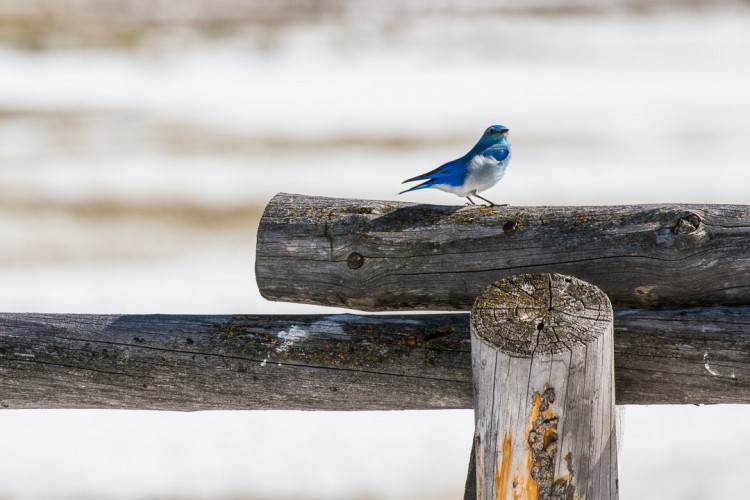
Broad tailed and calliope hummingbirds return here from Central America to feed on the nectar of blooming wildflowers. Visit grasslands to look for one of our longest avian migrants, the Swainson’s Hawk. Over the course of three months each spring and fall Swainson’s travel over 7000 miles, all the way to the Argentinean Pampas or grassland.
One of my favorite spring sightings generally occurs in early May at LeHardy Rapids on the Yellowstone River. Harlequin ducks, a species of torrent duck arrive here from the Pacific Northwest coast to feed and mate. Perfectly adapted to life in rough water, harlequins have extra strong bones. After a summer raising chicks in Yellowstone’s rugged interior the females will stop once again at the LeHardy Rapids before making the cross country journey back to the coast.
Baby Bison!
As our year of wildlife in Yellowstone completes its circle we return to the first baby mammals or spring, bison calves. Calves can be born in early April, up to two months before their elk or deer counterparts. I usually observe the first bison calves in Yellowstone’s Northern Range, with the Teton bison herd calving several weeks later.
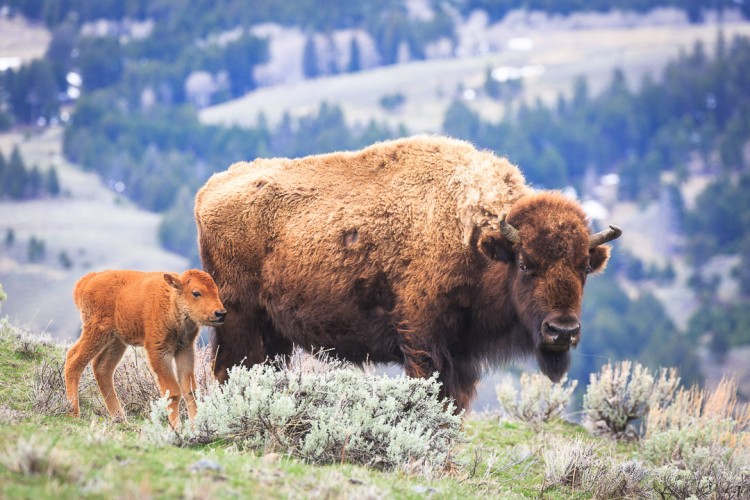
Up Next: Wildlife Watching Tools of the Trade, Safety and Ethics
No matter the season, wildlife watching in Yellowstone is a must do experience for wildlife enthusiasts. Now that we’ve covered what to expect through the seasons read part two of this blog to learn about the tools of the trade, safety and ethics of wildlife watching. Learn what the pros do to have the best possible experience observing wildlife in Grand Teton and Yellowstone National Parks here.
Please let us know if we can help with guiding your next adventure in Grand Teton or Yellowstone National Parks by calling us 307-690-9533 or emailing info@jhecotouradventures.com.
Now in our 11th year of operation, Jackson Hole Ecotour Adventures leads wildlife safaris, cross country skiing tours, and snowshoe tours in Grand Teton and Yellowstone National Parks 365 days a year. Let us help maximize your Jackson Hole Experience Today!
Best Scenic Things To Do in Jackson Hole in Summer
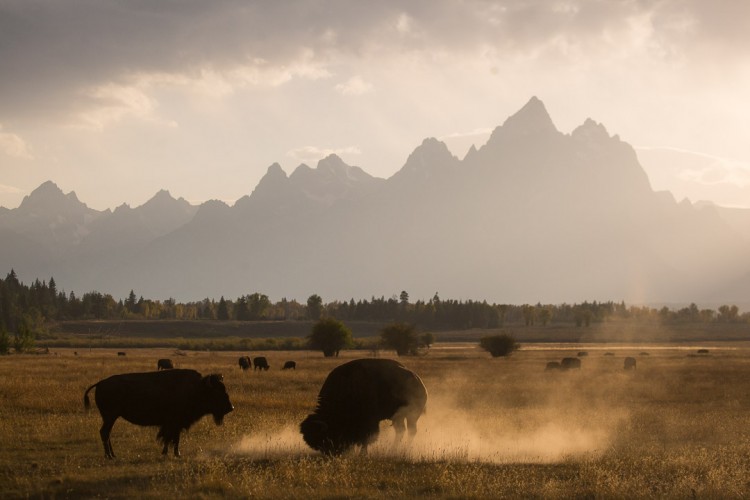
Are you looking for some of the best things to do in Jackson Hole in summer? Then you’ve come to the right place. We can help you find the best summer activities that also offer the most breathtaking views.
Whether you’re looking to check out some wildlife in their natural habitat, scope out the best mountain ranges, experience the exhilarating rapids or just get some fresh, mountain air—we’ve got you covered.
Best Things To Do in Jackson Hole in Summer
Raft the Rapids
If you’re looking for a fun way to check out some of Jackson Hole’s gorgeous mountain scenes, then a scenic raft trip is the right choice for you. Teton Whitewater offers a Grand Teton National Park Scenic trip and a Wilson Scenic trip. Plus the trips are great for the whole family (ages 4+), so you don’t have to worry about leaving your kiddos behind.
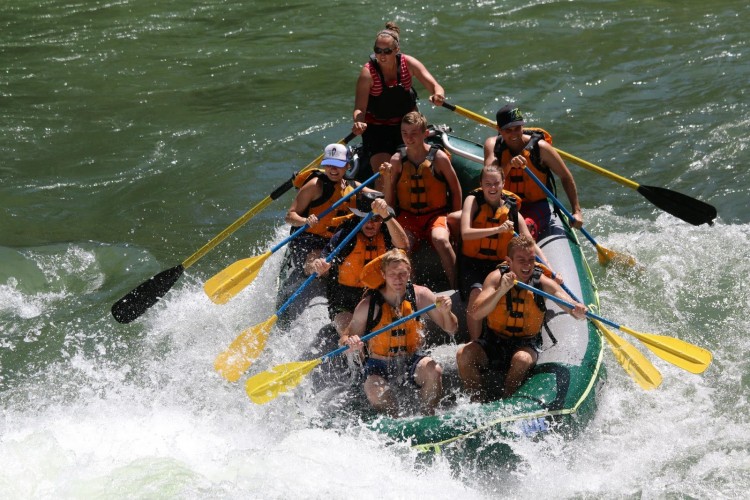
Tour the Wildlife
Check out everything from wild wolves and bears to bison and elk during one of the EcoTour Adventures summer wildlife tours. During the Half Day Wildlife Tour, you’ll get to embark on an adventure through some of Jackson Hole’s wildlife hotspots while riding on a 4x4 safari vehicle. Then on the Yellowstone National Park Wildlife Tour, you will get to see Old Faithful, the Grand Canyon of Yellowstone and some of the thermal features in the park.

Climb the Mountains
There are hundreds of hikes to choose from in the Jackson Hole area, which could make it hard to pick just one. But rest assured, no matter which hike you choose, you’ll get a glimpse of spectacular views and wildlife in their natural habitat. We recommend heading to Cascade Canyon or Death Canyon for some of the best hikes in the area.
Fly Over the Mountains
Do you want the best panoramic view of the Jackson Hole area? As long as you aren’t scared of heights, paragliding could be the perfect option for you. After just a few steps, you’ll get to glide over some of the most beautiful mountains. Plus the adrenaline rush will add a little more adventure to your Jackson Hole experience.
Set Up Camp
Jackson Hole is known for having some of the most stunning campsites in the nation. Whether you decide to set up camp in Yellowstone National Park, the Gros Ventre Wilderness Area, Bridger Teton National Forest or anywhere in between, you won’t be disappointed.
Book Your Jackson Hole Adventure
There are many options to choose from when it comes to the best things to do in Jackson Hole in summer. If you’re interested in booking a rafting adventure, then call Teton Whitewater and schedule your trip. We offer a variety of rafting trips in Jackson Hole that are great for ages four and up.
This guest blog was contributed by Teton Whitewater. When you’re ready to book a raft trip, give us a call at 307-733-2285 or send us an email at tetonwhitewater@gmail.com.
Now in our 11th year of operation, Jackson Hole Ecotour Adventures leads wildlife safaris in Grand Teton and Yellowstone National Parks 365 days a year. Let us help maximize your Jackson Hole Experience Today!
Contact us at 307-690-9533 or info@jhecotouradventures.com for more information and to book.
New winter activities in Grand Teton and Yellowstone National Parks!
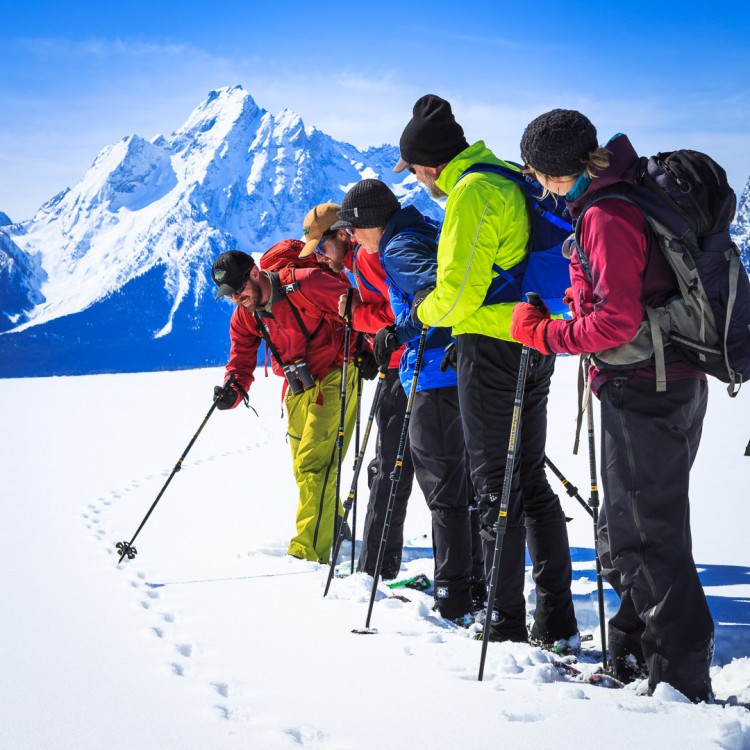
New Winter Wildlife, Cross Country Ski and Snowshoe Tours of Grand Teton and Yellowstone National Park
Winter in Jackson Hole offers a start contrast to the hustle of summer. With the crowds of summer long gone, a peaceful silence falls across the snow covered landscape of Grand Teton National Park, perfect for exploration on cross country ski or snowshoe. Wildlife are concentrated in the valleys across the Greater Yellowstone Ecosystem, offering unparalleled opportunities for viewing species like wolves, elk, bison, moose, bighorn sheep, bald eagles and more.
Just in time for winter, the guides at Jackson Hole EcoTour Adventures are excited to announce three brand new tours for the Winter 2018-2019 season, learn more about how to maximize your winter vacation to Jackson Hole!
Guided Cross Country Skiing and Snowshoeing beneath the Teton Range
Though already renowned as a downhill skiing destination, Jackson Hole is a hidden gem with miles of world class cross-country skiing opportunities. Thanks to our friends at the Grand Teton National Park Foundation, 14 miles of the Teton Park Road are groomed for skiing from the Bradley-Taggart Trailhead all the way to Signal Mountain Lodge. Dozens of additional miles of ungroomed trails and thousands of acres of untouched powder snow exist for those who wish to explore off the beaten path. Grand Teton National Park is a nordic skiing and snowshoeing paradise!
This year we’re adding a Half Day Beginner Ski Tour to our lineup of Grand Teton National Park and National Elk Refuge tours. As you learn to ski, one of our experienced naturalist guides will teach you about the wildlife and winter ecology of the Greater Yellowstone Ecosystem, deepening your connection to the landscape. More Information
Skiing not your thing? Follow the trail of our Naturalists into the backcountry of Jackson Hole on a Four Hour Snowshoe Tour. We'll explore wildlife track and sign, snow science, and enjoy an off the beaten path experience exploring Grand Teton National Park. These trips are designed for all abilities, if you can walk you can snowshoe! All necessary snowshoe equipment provided. More Information
Winter Wolves and Wildlife of Yellowstone!

Have you ever seen wolves in the wild? Now's your chance.
Join Jackson Hole EcoTour Adventures on an unforgettable Multi Day Winter Wolf and Wildlife Safari in the heart of the American Serengeti! We’ll spend 4 full days exploring the Greater Yellowstone Ecosystem, focusing on the Northern Range of Yellowstone National Park, some of the best wolf habitat in the lower 48 States. With concentrated elk and bison herds in the Lamar Valley, winter is the best time of year to observe wolves in their natural habitat.
January and February departure dates coincide with peak wildlife activity and one of the quietest times of year for tourism, meaning Yellowstone is ours to explore free of crowds! We'll also enjoy an evening dinner with a Yellowstone Wolf Biologist, getting the latest updates on wolf research in the Park.
ETA donates 5% of wolf watching tours to Wolf and Wildlife Conservation with our friends at the Greater Yellowstone Coalition
January 16-21 2019
February 23-28 2019
Check Availability: 307-690-9533 or info@jhecotouradventures.com
Other Winter Tours
For an extended experience exploring winter in Grand Teton National Park, visitors to Jackson Hole can join us on a full day snowshoe or full day cross country ski tour. Or join us on a half or full day tour observing the diverse and concentrated wildlife of Grand Teton National Park and the National Elk Refuge.
Now in our 11th year of operation, Jackson Hole Ecotour Adventures leads half day, full day, and multi day wildlife, cross country ski, and snowshoe tours in Grand Teton and Yellowstone National Parks 365 days a year. Let us help maximize your Jackson Hole Experience Today! www.jhecotouradventures.com 307-690-9533 or info@jhecotouradventures.com
Explore Fall in Grand Teton and Yellowstone National Parks!
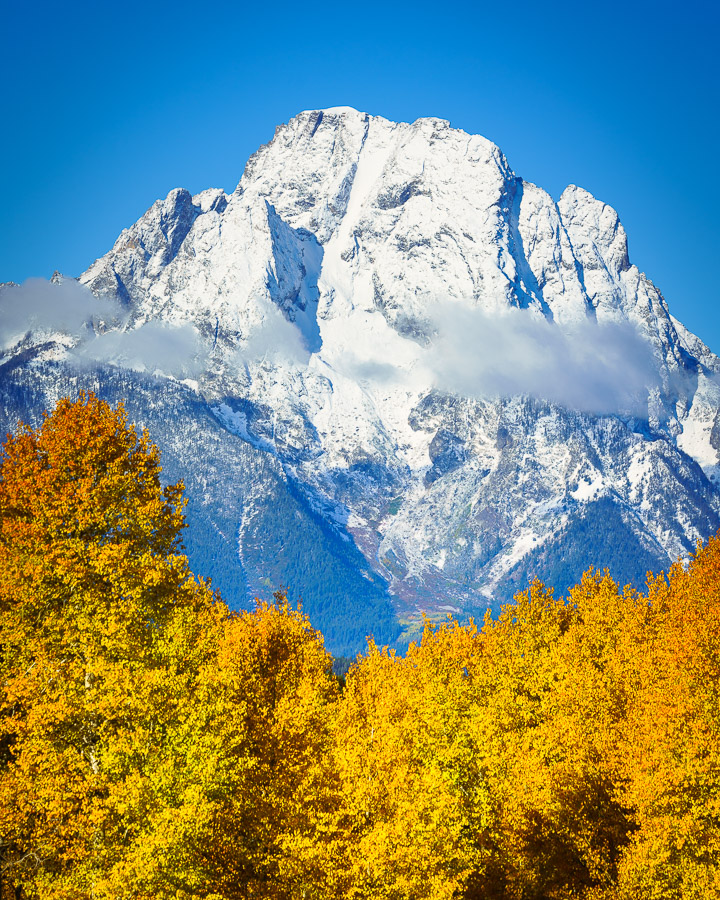
Fall at Oxbow Bend in Grand Teton National Park
There is a crispness in the air today Jackson Hole. Mornings are cold and leaves are starting to change. It begins with fireweed flowers and smaller shrubs, before peaking with aspens and cottonwoods, our two major deciduous trees species. The fall has always been a special time to me, with fond memories of still evenings listening for the bugling of elk beneath golden aspen groves. Right now there is something for everyone in Grand Teton and Yellowstone National Parks, from rutting elk to active black and grizzly bears preparing for hibernation.
Fall Foliage
Are you a leaf peeper? If you like gazing at and photographing fall foliage you just might be! It’s an informal name for folks who travel to observe the changing of fall colors. Here in Jackson Hole, fall colors astound, beginning first at higher elevations and then coursing downstream, following cottonwood groves along the Snake River. Grand Teton National Park has countless photography locations to capture the sights.
What is happening in fall anyway? Plants contain a green colored pigment called chlorophyll which is responsible for photosynthesis, the process which converts sunlight to sugars. As days shorten plant leaves slow down the production of chlorophyll which allows other pigments, called carotenoids, to become visible. The stunning reds, oranges, and yellows we see in fall have been present all along! Read more about the Science of Fall Foliage Here!
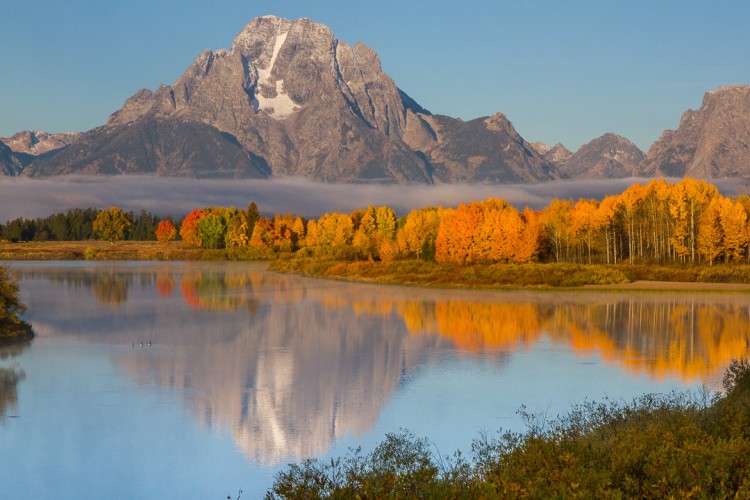
Fall at Oxbow Bend, Grand Teton National Park
Deciduous plants drop their leaves to save energy in winter when they would be otherwise unable to photosynthesize due to freezing temperatures. With out liquid water the chemical reaction cannot occur. In stark contrast to aspens and cottonwoods, our pine, spruce, and fir trees are known as evergreens, appearing to never lose leaves. (they are constantly dropping needles, just not all at once!) Evergreens produce sturdy needles which can resist winters chill, this allows them to begin photosynthesis as soon as water is once again available in the spring. Two unique strategies for surviving in the Greater Yellowstone Ecosystem.
Sparring Bull Elk, the Rut!
When aspen leaves begin to yellow, it is a sure sign the rut has, or is about to start. Sit quietly beneath one of these trees at dawn and you may hear an eerie sound echo across the forest. It’s a bugle, a loud scream large bull elk make to proclaim their dominance for mating rights. One of North America’s most spectacular wildlife behaviors, bull elk will call back and forth, issuing challenges. If you are lucky the next bugle you hear may be close enough to see the performers meet. They will stand tall, broadside to each other. Breathing heavily, water vapor will form in the frosty air. If one does not retreat the two will bow antlers and then lock them together, wrestling back and forth until one gives up and flees. The victor may often attempt to gore the loser while in pursuit.
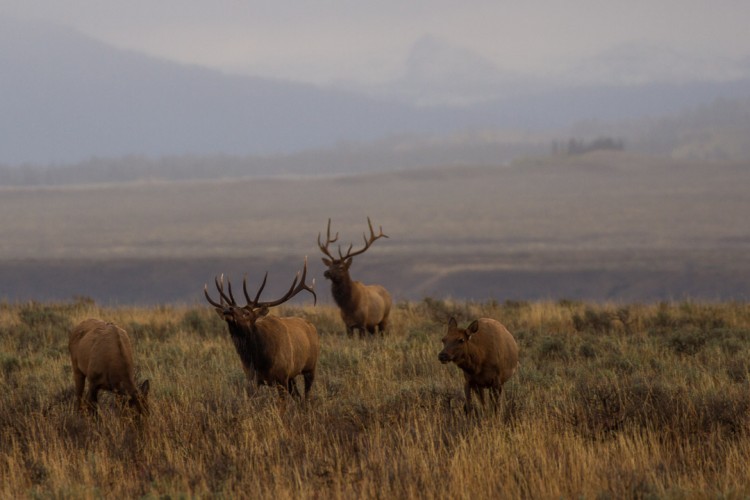
A bull elk bugles during the Fall Rut, Grand Teton National Park
All of our ungulates, or hoofed mammals, mate in fall so that their offspring will be born in spring. And elk aren’t the only ones to aggressively establish dominance; moose, deer, pronghorn, and bison will also be in rut this fall, a unique spectacle to experience beneath the shadow of the Tetons.
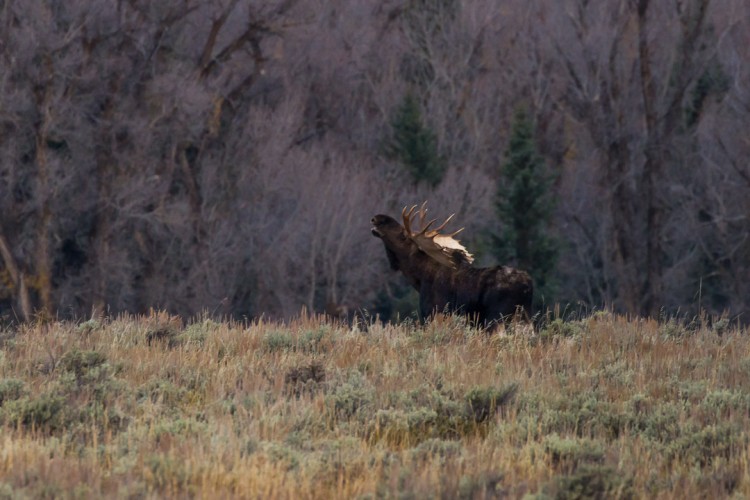
Rutting Bull Moose observed on a wildlife tour of Grand Teton National Park.
Preparing for Hibernation
Animals use three primary strategies to survive in the Greater Yellowstone Ecosystem, Adapt, Migrate, or Hibernate. One of our most popular animals to see, bears, are experts at the third. Throughout the summer bears build up fat reserves, preparing for winter. As omnivores, they will eat just about everything, grasses, roots, berries, elk calves, carrion, ants, and even moths roosting in high elevation boulder fields! Towards the end of summer foraging picks up, entering a stage called Hyperphagia or over eating. Foraging constantly, bears will eat upwards of 20,000 calories a day! Right now in Grand Teton National Park much of this calorie budget is coming from the berries of the hawthorn, a thorny bush often found near water.
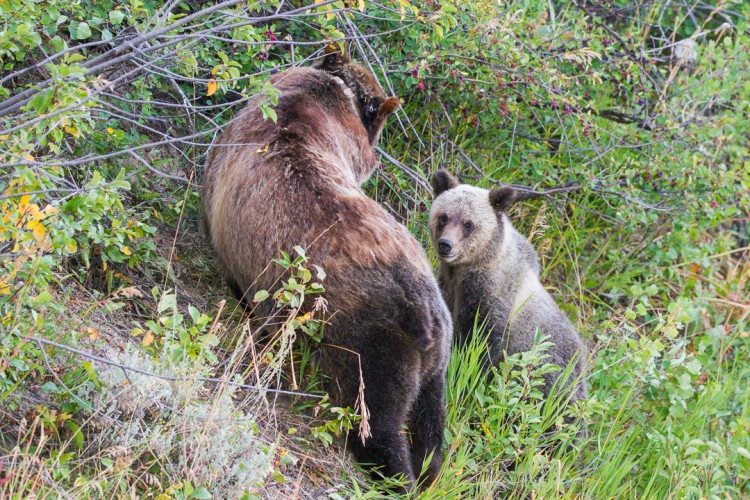
A Grizzly Sow and Cubs feed on serviceberry during a Grand Teton Wildlife Safari.
Transitioning to Winter
Fall is a transitional time, with our over 1000 plant species shutting down photosynthesis, in preparation for the long winter. Many drop their colored leaves or die back to the ground where insulated snow cover protects the living roots. Our rutting mammals complete the mating season and begin migrations out of high elevations to more protected valley floors, often concentrating in huge numbers such as elk on the National Elk Refuge. As two thirds of our bird species leave the valley for warmer climates and bears disappear to hibernate, we welcome new arrivals to winter in Jackson Hole. Raptors like the Rough Legged Hawk will soon arrive from the Arctic Circle, and mighty bighorn sheep will return from the rugged Gros Ventre Mountains, beginning their late fall rut just outside the town of Jackson.
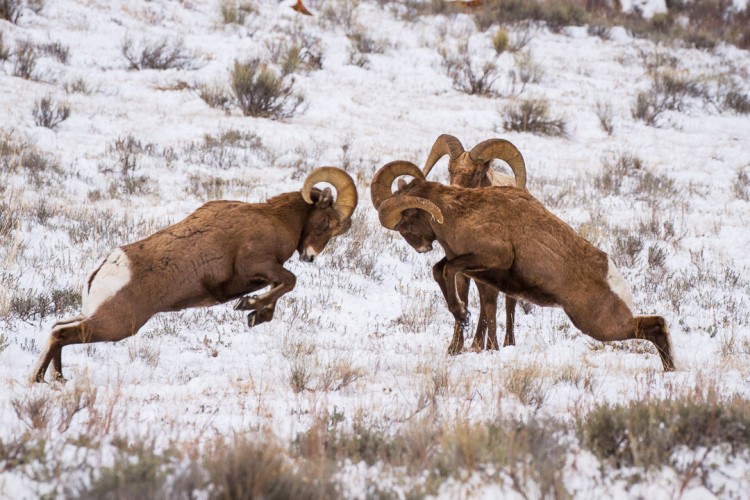
Bighorn Sheep Butt Heads in early December on the National Elk Refuge near Jackson, WY.
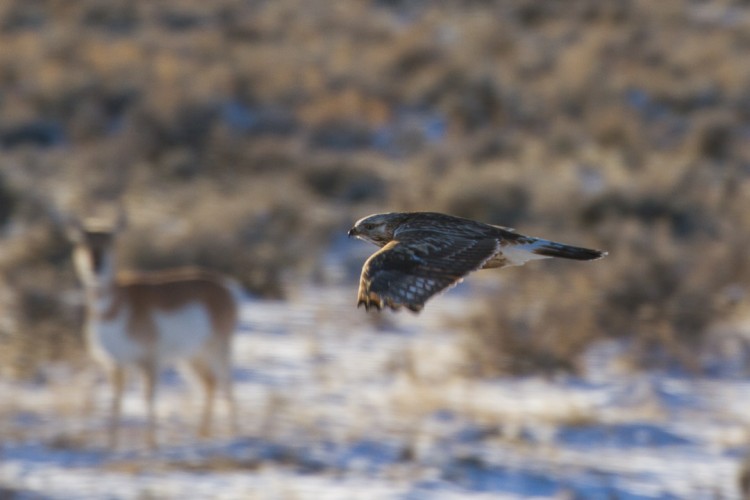
Rough Legged Hawks Migrate through the Jackson Hole Valley in Winter from the Arctic Circle!
The magic of fall in the west is something I was introduced to as a young child growing up near Rocky Mountain National Park. Let the experienced guides at Jackson Hole Ecotour Adventures share this story when you visit Grand Teton and Yellowstone National Parks this fall. Join us on a half day, full day, or multi day trip through fall in the Greater Yellowstone Ecosystem, it’s one you wont soon forget. Click the Book Now! Button at the top of the website or give us a call at (307) 690-9533 to book. We hope to see you soon!
Guide Josh Metten has spent his entire life exploring and living in the Rocky Mountains of Colorado and Wyoming. He is an Ecotour Adventures Naturalist, photographer, conservationist, and outdoor enthusiast. Josh lives in Jackson, WY.
Getting the Most out of the Jackson Hole Total Solar Eclipse
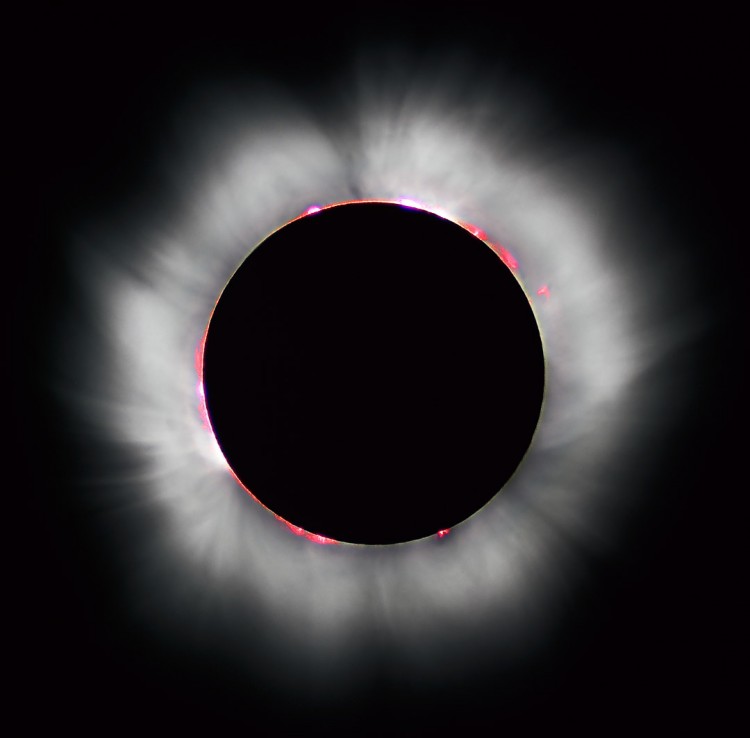
“
In less than three weeks a once in a lifetime event will occur across Jackson Hole and Grand Teton National Park, a total Solar Eclipse. At approximately 10:16am on Monday August 21st, the eclipse will begin, as the moon begins to block the sun’s rays. In just over an hour, the moon will completely obscure the sun and at around 11:35am Totality will be reached. For over two minutes the Jackson Hole Valley will be cast into darkness.
The 2017 Eclipse is the first to cross the entire continent since 1918, and will be visible in twelve states, from Oregon to South Carolina. With stunning mountain vistas, Grand Teton National Park and the valley of Jackson Hole are popular locations for viewing the eclipse, which is predicted to be the valley’s largest event in history. Planning on viewing the eclipse in Jackson Hole? Here’s what you need to know.
Viewing Locations
Eclipse viewers will want to find a location within the path of totality (see above map). Jackson hole is a spectacular viewing area, but, due to the limited road access out of the area could be problematic if weather prevents viewing of the eclipse. Should this occur, expect gridlock of roads leaving the valley the morning of the eclipse. For those interested in playing the odds of seeing the eclipse occur over the Tetons in Jackson Hole (they are good, about 78% chance of clear skies), numerous options exist.
Grand Teton National Park expects the eclipse to be the largest event in the history of the Park and has set up 5 different designated viewing areas in prime locations throughout the park; along the road to Kelly, the Gros Ventre Campground, the Craig Thomas Discovery and Visitor Center in Moose, Colter Bay and Jackson Lake Lodge. Each area will have additional bathroom facilities and staff on hand to help out. The Gros Ventre Road, located in the center of the path of totality, will be a popular viewing area and will be managed for one way traffic heading north. See the below map for the other viewing areas.
Parking outside of the designated viewing areas will be restricted to existing pullouts which will fill up very early in the morning and along the shoulder of the Teton Park Road, which runs north from the Craig Thomas Discovery Center at Moose Junction along the base of the Tetons. To provide access for emergency personnel, no shoulder parking will be allowed along US HWY 26/89/191 or on the Moose/Wilson Road. Additionally, park fees will be suspended on eclipse day to ease traffic entering the park.
Great eclipse viewing options exist outside of Grand Teton National Park, right in the town of Jackson and at Teton Village. Wyoming Stargazing is offering a free public eclipse viewing event at the base of Snow King Mountain. An eclipse viewing area is available at Teton Village and a limited number of tickets are being sold for those who want to ride the Sweetwater Gondola up Jackson Hole Mountain Resort.
Hiking opens up numerous possibilities for great eclipse viewing locations. The majority of the Teton Range falls within the path of totality and a hike to any of the summits should provide for great viewing. The Gros Ventre Mountains east of Jackson Hole, Palisades Wilderness Study Area to the South, and Snow King Mountain, located just south of town will also provide great viewing locations.
Regardless of location be sure to find a view looking south and east to watch the eclipse. If you want to see the moon’s shadow racing across the earth at about 1 kilometer per second get a view looking to the west.
Traffic Considerations
With the 2017 Jackson Solar Eclipse expected to be the biggest day in history, traffic will be a major issue, expect significant delays both before and after the eclipse. Many eclipse viewers will use bicycles and the extensive Pathway System to avoid traffic delays. Those using vehicles are encouraged to carpool or use the START bus route which will be free on eclipse day.
Plan on Getting Stuck! It is likely that roads may become impassable before and after the eclipse so plan accordingly. Ecotour Adventures trips will be leaving early to arrive at our viewing locations and plan on staying there well after the end of the eclipse. Bring sufficient food, drink, and emergency supplies for the day and plan on limited or unavailable cellular or internet service due to the increased amount of visitors. Please protect our public lands by packing out anything you pack in!
Once you have arrived at your eclipse location sit back and enjoy the show. Solar glasses or some other approved solar filter is a must for viewing the eclipse until the exact moment of totality at around 11:35 am, when it will be safe to view without them for around 2 minutes. We will be handing out free solar glasses on all Grand Teton and Yellowstone Safari Tours the week before the eclipse, find out how to join us here.
Other things to do in Jackson Before and After the Eclipse
The week before and after the 2017 Jackson Eclipse will be full of fun activities both eclipse and non eclipse related. On Saturday August 19th Wyoming Stargazing is offering a Pre Eclipse Party featuring Nasa Astronaut Scott Altman and Astrobiologist Dr. David Grinspoon. Visit their website for more information.
On Tuesday, August 22nd The Town, County, and Grand Teton National Park are hosting post eclipse cleanups, find out how you can join by emailing volunteer@tetoneclipse.com
Though our trips the day of the 2017 Teton Eclipse are fully booked, August is a great time for wildlife viewing in both Grand Teton and National Parks and EcoTour Adventures will be out leading half, full day and multi day trips of the parks. Learn more about how to join us here!
Additional Resources:
http://tetoneclipse.com/bridger-teton-national-forest-eclipse-interactive-map/
Header Background Photo: Solar Eclipse by Luc Viatour, CC BY-SA 3.0, https://commons.wikimedia.org/w/index.php?curid=132886
Photos and blog by Naturalist Josh Metten
“
Yellowstone National Park, A Trip To Wonderland
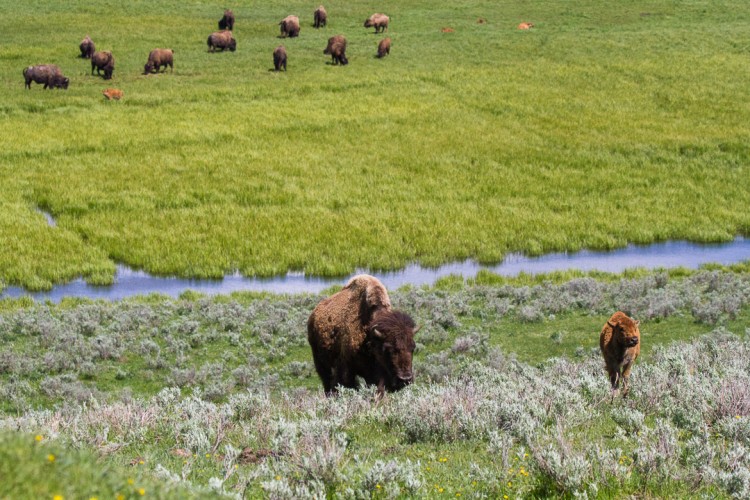
It’s early summer in Yellowstone and Grand Teton National Parks. A popular destination since its formation in 1872, Yellowstone was promoted in the early 1900's as a trip through “Wonderland” by the Northern Pacific Railroad, whose tracks were laid just north of the park. Jackson Hole Ecotour Adventures Guide Laura Kruseski recently returned from a four day National Park Safari through Grand Teton and Yellowstone National Parks, read on to hear about the tour!
A Safari to “Wonderland’
On our recent multi-day trip to Yellowstone we discovered the wonders of our magnificent park. In four days and three nights we toured geyser basins, listened to the sounds of bubbling hydrothermal features after dark, saw a plethora of wildlife from tiny ground squirrels to giant grizzly bears, found fossils from ancient seas and forests, and hiked to remote areas of the park that are seldom seen by park visitors. A highlight of our trip was viewing an alpha male grey wolf feeding on an elk carcass in Soda Butte Creek! We were also able to spot several grizzly bears, including female bear with 2 cubs.
Beneath the Teton Range
Our first day was spent touring in Grand Teton National Park. We departed Spring Creek Ranch bright and early, and before entering the park we had already spotted a nesting pair of bald eagles and practiced using our Maven binoculars while viewing a few coyotes and red-tailed hawks. At Schwabacher’s landing in Grand Teton National Park we were delighted to view a herd of cow elk cross a side channel of the Snake River.
Next we went fossil hunting at Blacktail Butte, which contains limestone deposits of an ancient ocean found here over 300 million years ago. The Madison formation contains fossilized corals, bivalves, and echinoderms (sea stars) which we observed before replacing them for others to find. Removing items from the park is prohibited to protect park resources for future generations.
After enjoying a great lunch at the famous Dornan’s restaurant beneath the Teton Range, we headed north for a short hike with great Teton views. A herd of cow elk were playing in the water down below, and we also spotted a bachelor group doing their own thing, antlers rapidly growing beneath a fuzzy velvet covering.
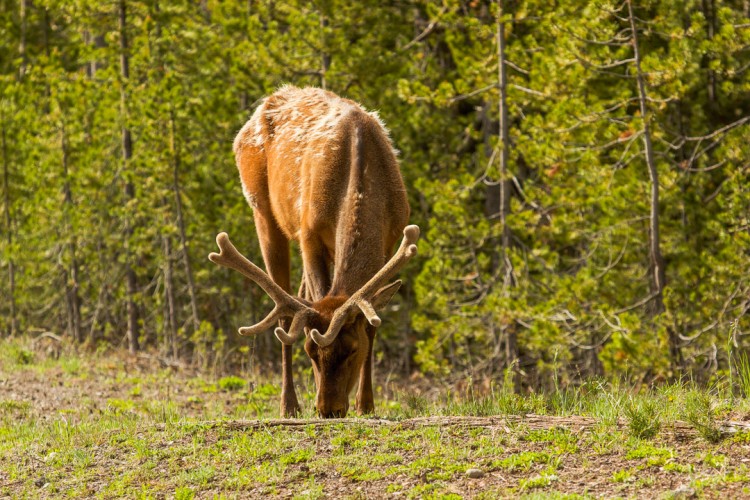
Onward to Old Faithful
As the day waned, we completed the drive through Grand Teton and into Yellowstone National Parks, arriving at Old Faithful Inn, our lodging for the evening. We enjoyed dinner and drinks, saw an eruption of Old Faithful, then went out on a night hike in the geyser basin. Pheww!!! A long day which wrapped up around 11 pm!
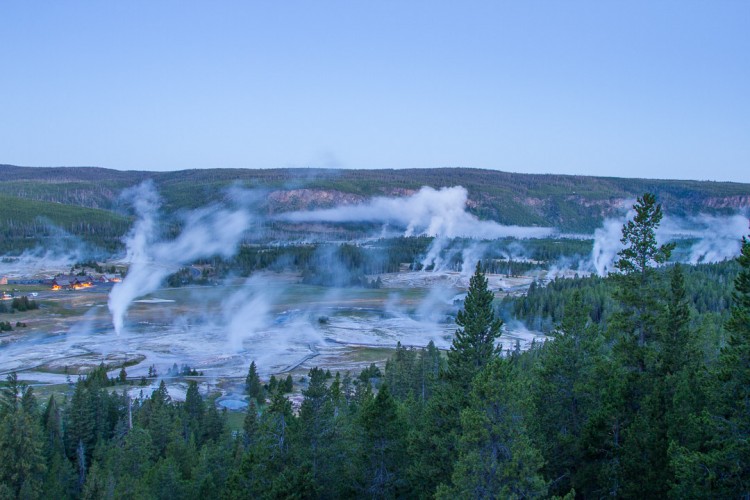
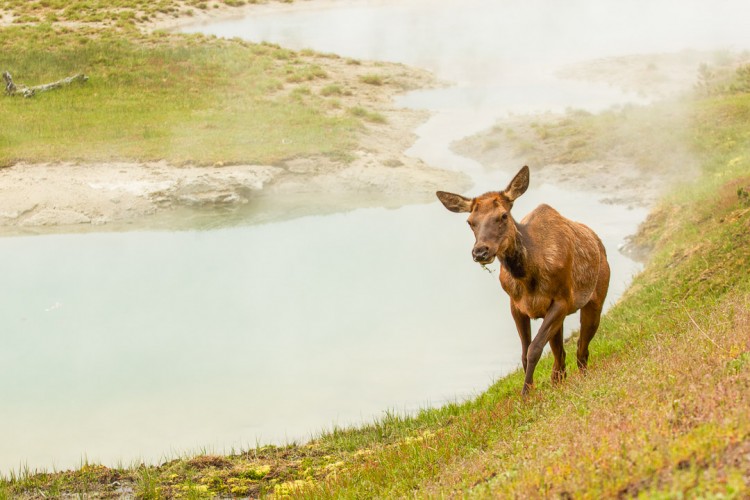
Yellowstone’s Geothermal Features
On day two we departed Old Faithful to explore Yellowstone’s hydrothermal features. At Fountain Paint Pots we viewed all four types of features found in Yellowstone National Park; hot pools, mud pots, fumaroles, and geysers. After a detour to the Wolf and Grizzly Bear Discovery Center in West Yellowstone we headed north to the Travertine Terraces of Mammoth Hot Springs. We tracked some bighorn sheep up onto a ridge, where we could hear a dusky grouse hooting. Then to Lamar and the northern range and out to Silvergate cabins where we were able to settle in for 2 nights.
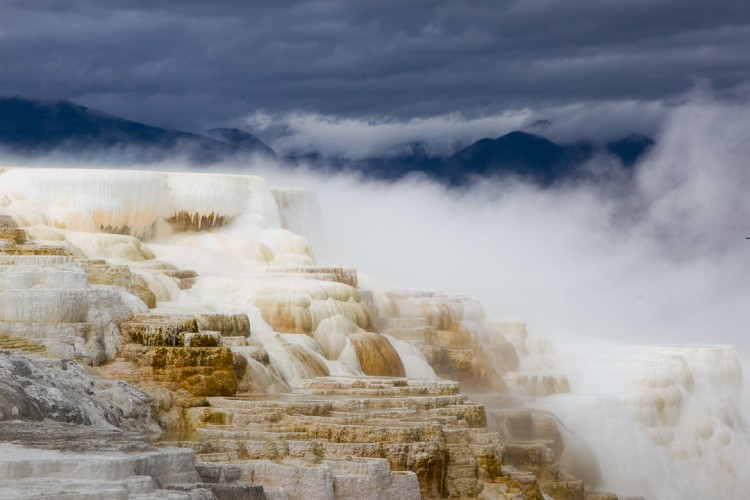
Yellowstone’s Northern Range, the American Serengeti
The highlight of our multi day tours are often the Northern Range of Yellowstone. Wolves were reintroduced here in 1995 after a 60 year absence and are thriving. The wide open river valleys and forested mountains create perfect habitat for thousands of bison, elk, pronghorn antelope, bighorn sheep, deer, grizzlies, and black bears. As we prepared for a hike up Specimen Ridge early on our first morning we spotted a Grizzly Bear up on our destination ridge. It soon departed and with bear spray in hand, (just in case) we set out on a great hike on Specimen Ridge trail where we encountered many animals from a distance, including bison grunting in a huge herd, pronghorn antelope snorting at us, elk by the dozens, and plenty of birds of prey and songbirds. Specimen Ridge is also dotted with bleached antlers, skulls, and some petrified wood from a volcanic eruption 50 million years ago!
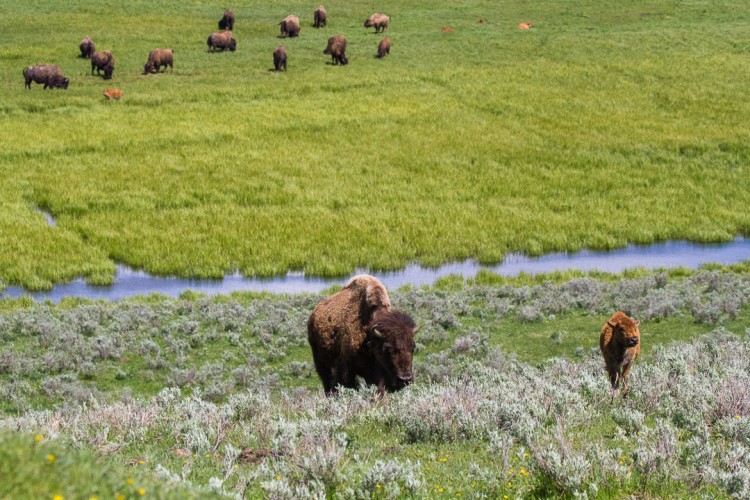
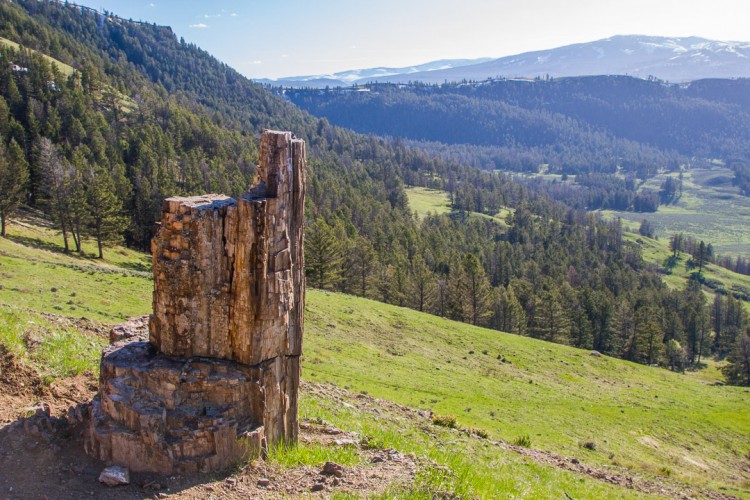
On our final day we hit the road to return to Jackson Hole via Yellowstone and Grand Teton National Parks, but still had a chance to see 5 Grizzly Bears, 3 Black bears, Wolves at a Carcass in a creek, and many spectacular Yellowstone vistas. We stopped at the Upper and Lower Falls of the Yellowstone River watching in awe the force of over 50,000 cubic feet per second of water cascading over the drops.
A yellowstone wolf from the Lamar Canyon Pack feeds on an elk carcass in Soda Butte Creek of Yellowstone's Lamar Valley.
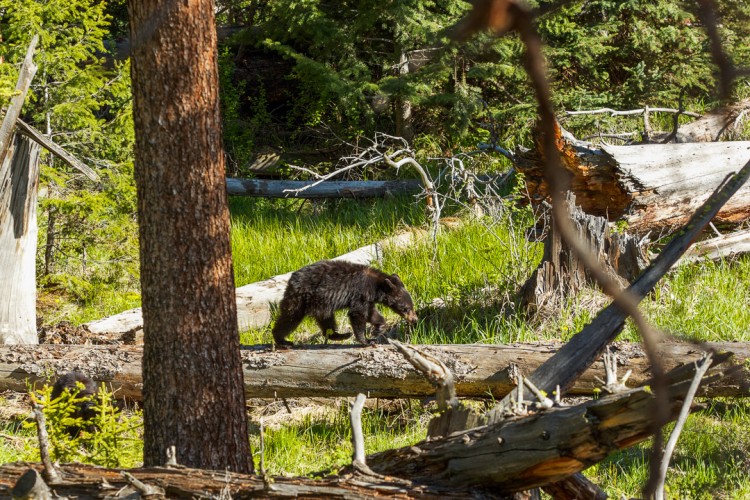
We came full circle at the base of the Tetons early in the evening, having completed a four day circuit of ‘Wonderland.’ Originally protected for it’s thermal features, Yellowstone National Park has become the core of one of the last mostly intact temperate ecosystems left on earth. Today, visitors have an opportunity to not only take in the alien landscapes of Yellowstone’s Geyser Basins and the towering monoliths of the Teton Range, but also a diversity and abundance of life reminiscent of our wild past. Come visit 'Wonderland' and see it for yourself.
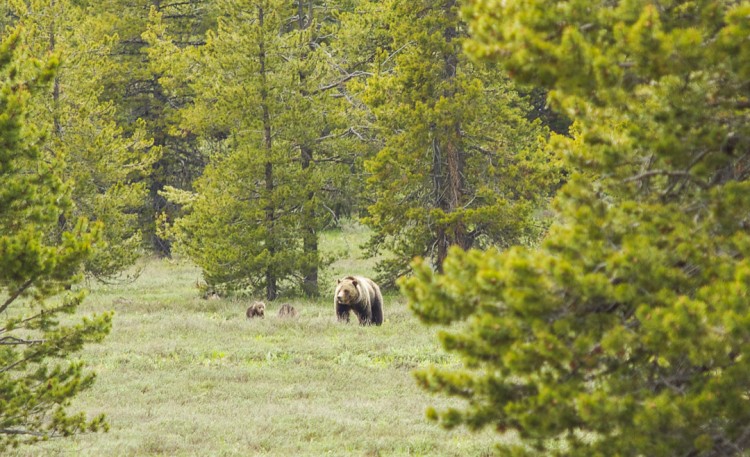
To learn more about joining a single or multi day safari with Jackson Hole Ecotour Adventures visit our website or give us a call at (307) 690-9533. We hope to see you soon!
Photos and blog by Naturalist Laura Krusheski, additional photos provided by Naturalist Josh Metten
The 2017 Jackson Hole Solar Eclipse
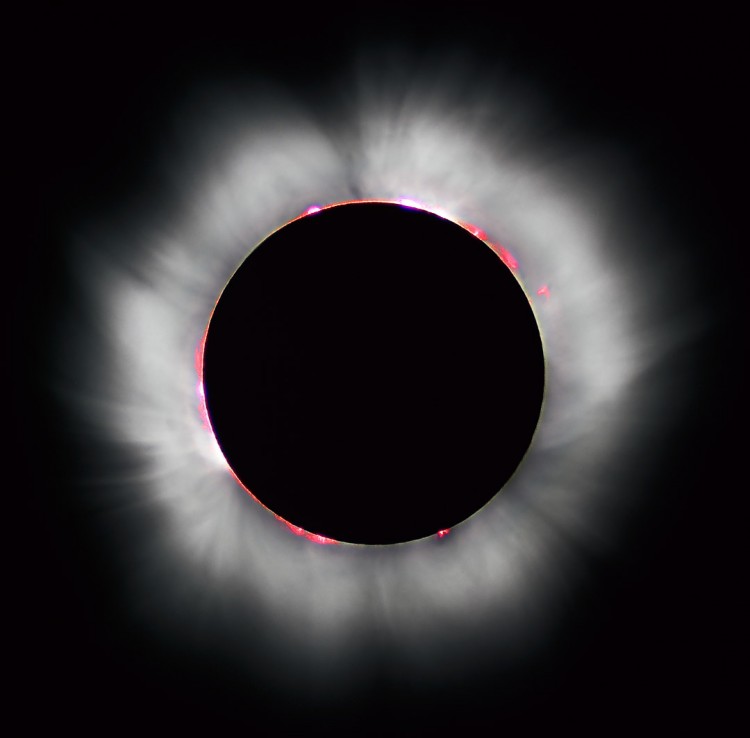
Imagine yourself on a sunny morning in Wyoming’s distant past. A valley extends in front of you, teeming with pronghorn antelope and bison, browsing amongst the sagebrush. Elk graze on an open hillside, while below a grizzly bear guards a carcass from other scavengers. Abruptly, a shadow descends across the landscape, moving from the west at over 1000 miles per hour! Disturbed by the sudden darkness, the animals look up, confused. Some nervously bed down in preparation for night. For over two minutes, an uneasy stillness descends on the landscape as the calls of songbirds cease, some returning towards their roosting locations, believing night has fallen. Then, as quickly as it departed, light returns to the valley. Birds resume their singing, and the elk return to grazing. A total eclipse has just passed over.
The 2017 Total Eclipse
Though total eclipses occur somewhere around the world every 18 months on average, this summer’s eclipse passes directly over Jackson Hole, making the Tetons and Wyoming a top destination to experience it. At around 10:17 am on Monday August 21st, 2017 a shadow will begin crossing over the Tetons from the west. Within an hour, around 11:35 am, the moon will completely obscure the sun casting the valley in a dark shadow. For around two minutes night will fall in the valley, before alignment shifts and the sun begins to reveal itself over the next hour. This once in a lifetime event is not to be missed.
What is an eclipse?
Historically viewed superstitiously as bad omens, eclipses occur when the Earth’s orbit passes directly in between the sun and moon (Lunar), or when the moon’s orbit passes directly between the sun and Earth (Solar). Lunar eclipses are more common and easy to view as a result of the earth’s larger size compared to the moon. During a lunar eclipse, the earth casts a wide shadow, making lunar eclipses visible from across the globe. Solar eclipses by contrast, impact a much smaller radius, which happens to pass right over Jackson Hole this year!
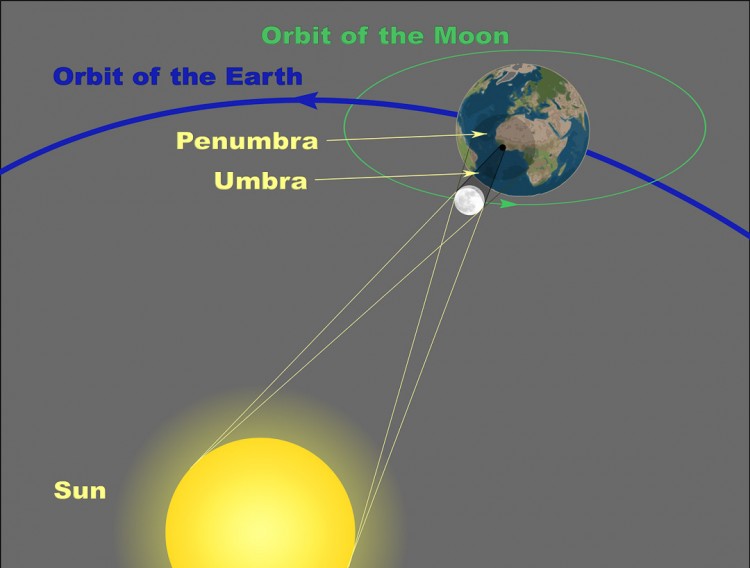
The secret of how solar eclipses occur is the distances of the moon and the sun from Earth. Even though the moon is 400 times smaller than the sun, it also happens to be 400 times closer to the Earth, which makes both appear the same size in the sky! When the sun, moon, and earth line up in a perfect syzygy (an astronomy term for alignment of celestial objects, especially the sun and moon) an eclipse occurs. The moons small size means only an area between 73 and 166 miles wide is impacted, known as the path of totality.
However, both the orbit of the Earth and the moon are elliptical, or oval shaped, which causes the apparent size of the sun and moon to shift throughout the year. Total eclipses occur when the orbit of the Earth is furthest from the sun, and the orbit of the moon is at its closest point to the Earth as the moon appears largest and the sun appears smallest.
When these conditions are not met an Annular eclipse can still occur, where part of the sun remains visible in a ring around the moon, known as the annulus. Solar eclipses occur somewhere around the world approximately every 18 months, but this is the first one to cross the entire United States since 1918!
Eclipse Study
For centuries, scientists and astronomers have been fascinated by solar eclipses, undertaking scientific observations of the phenomena. The “Great Eclipse of 1878” attracted inventor Thomas Edison and astronomer Henry Draper to Rawlins, Wyoming in an effort to document the corona, or outer ring of the sun. Usually not visible due to the brightness of the sun’s disk, the corona only appears during totality, or when the moon completely covers the disk. Drawings of the corona during the 1878 eclipse were some of the first to document its size and scope.
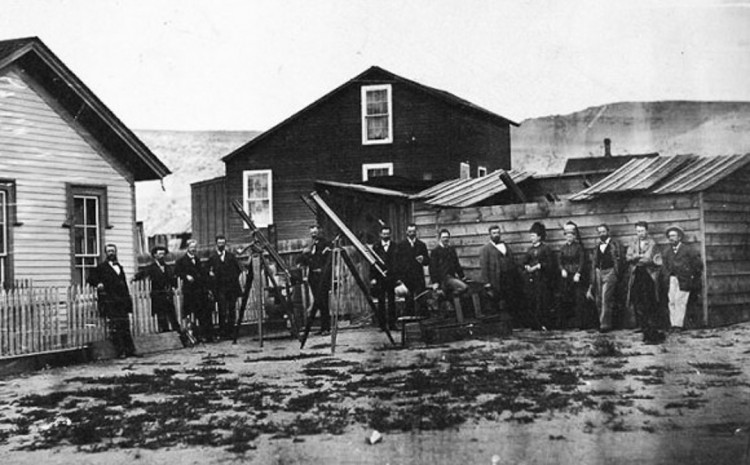
What can we learn from eclipses? Today the use of GPS is mainstream whether smartphone users relying on data from satellite accuracy to navigate in cities, or scientists studying mule deer migrations with GPS collars. Satellites, traveling very quickly while orbiting the earth actually experience time slower than we do on the surface of the earth! Without adjustments to correct this, pinpoint accuracy data such as we have today would be impossible. Physicists have long thought that the speed of objects can influence time but it was Einstein’s Theory of Relativity which explained it. An eclipse in 1919 allowed scientists to test the theory, measuring the position of stars during and after the eclipse, which helped confirm the theory.
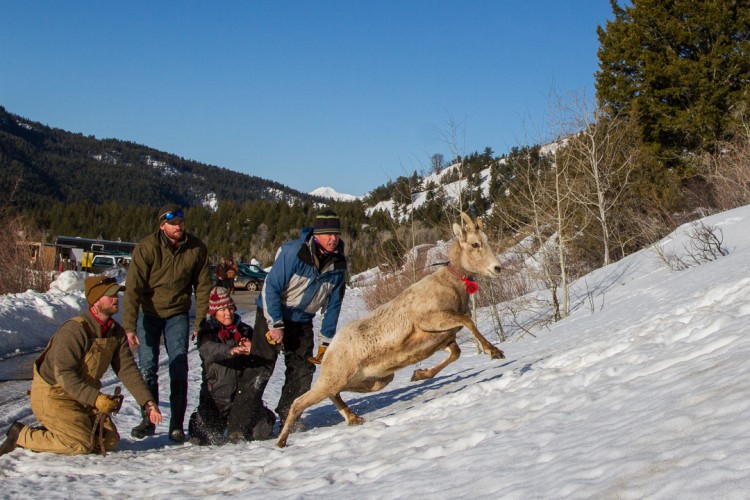
Effect on wildlife
How might wildlife respond to a sudden change like a solar eclipse? The plunge into darkness will undoubtedly change behavior, during past eclipses, observers floating in the ocean observed the sudden surfacing of dolphins and whales, looking out at the eclipsed sun during totality, only to submerge immediately following the event. An eerie silence from the cessation of bird calls and movement of other animals is expected, as is most likely an event none have ever experienced.
Experience the 2017 Eclipse!
We will be out exploring Grand Teton National Park during the eclipse and look forward to learning more about how the event affects the Greater Yellowstone Ecosystem. Check back soon for part two in this series where we highlight strategies to maximize your Eclipse viewing experience in Jackson Hole!
Jackson Hole Ecotour Adventures offers single and multi day trips through Grand Teton and Yellowstone National Parks year round, to join us exploring the Greater Yellowstone Ecosystem visit our website or call 307-690-9533. We hope to see you soon!
Thanks to our friends at Wyoming Stargazing for helping out with this post!
Words by Naturalist Josh Metten
Header Background Photo: Solar Eclipse by Luc Viatour, CC BY-SA 3.0, https://commons.wikimedia.org/w/index.php?curid=132886
Summer Activities in Grand Teton National Park and Jackson Hole
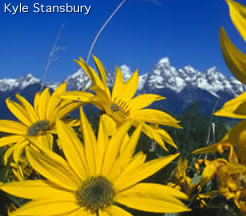
Summer in Jackson Hole and Grand Teton National Park is something special. There are multitudes of things do for everyone. Us locals, have a saying of F.O.M.O., Fear Of Missing Out! On our days off, What To Do, is the hardest question to answer. From time on the river, mountains, in the park or in town there are many opportunities for how to spend your time. This section has been designed to share with the newcomers what we think are the best activities in Jackson Hole, recommendations of how to enjoy them and who some of the great outfitters are to use. Of course, the best way to start your trip in Jackson is a wildlife and park tour with us, EcoTour Adventures. We will provide a stellar overview of the region, while maximizing your time viewing the area’s Wildlife and amazing vistas.
Wildlife Safari Tours
Certainally you must not miss the best summer activity in Jackson Hole and Grand Teton National Park. EcoTour Adventures offer professionally guided wildlife viewing park tours year round. Our tours in Jackson Hole must not be missed! Join us on an adventure today!
Scenic Float Trip
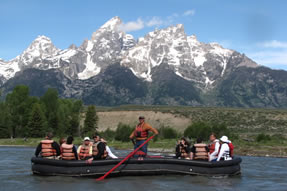
When some think of Jackson Hole, the Snake River comes to mind. A Scenic Float Trip down the Snake River is a wonderful morning or evening activity. Be sure the company you choose to work with floats a section of the Snake inside Grand Teton National Park. We believe inside the park to be one of more scenic sections of river to float. Look into Triangle X Float Trips. These folks have been in the business since 1926. They offer smaller rafts that hold a max of 12 passengers. If you reference EcoTour Adventures they are happy to offer you a 10% discount!
Whitewater Rafting
If you are looking for more of an adrenaline rush on the river, check out Sands Whitewater. You will don your life jacket on this fun, and not too scary, Whitewater Rafting trip down the Snake River Canyon. This is a mostly class III river with a couple of class IIII rapids. These guys have been in the business since the early 70ies and are worthy to trust! We love to recommend them because of their smaller raft options and impeccable safety record! 15% discount for EcoTour Adventures guests!
Fly Fishing
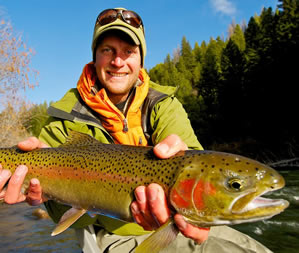
So, you are interested in Fly Fishing? When Taylor the owner of EcoTour Adventures is not out guiding wildlife tours you can find him on the Snake River catching and releasing native cutthroat trout. The “time just slips away” he states. We have heard only good things about the guides at Teton Troutfitters. They have been operating for the past 30 years and enjoy catering to all abilities. If fly-fishing is not your thing then they would be happy to put a spinning rod in your hands. With this group, you have the option of wade, drift boat, or power boat fishing. $375-$550 for two people all equipment provided.
Horseback Riding
We think that Mill Iron Ranch is a great outfitter for Horseback Riding in the area. This family run business has been around guiding trail rides since 1921. Their ranch is a short drive from the Town of Jackson and boarders the National Forest. If you want a true Wyoming experience this is your spot for friendly cowboys, beautiful landscapes, and delicious meals. This is a true mountain horseback riding experience.
Yellowstone Lake Kayaking
There is nothing much better than Kayaking in one of the largest high elevation lakes in the world. You will meet your kayak guide in Yellowstone at Grant Village with the boats in the water ready to go. OARS provides an incredible experience. You will be kayaking for a half day in crystal blue water and next to the West Thumb Geyser Basin. This is a half day tour, they also provide multi day paddles in Yellowstone and Grand Teton National Parks. All abilities welcome. Tell them the guides at EcoTour Adventures sent you for 10% off. $76 and Up.
Hiking
One of the reason we love Grand Teton National Park and Jackson Hole so much, is for the abundant hiking opportunities. Here are three options to get you started. Be sure to take water, food, extra layers of clothing (rain jacket), bear spray, and your sense of adventure with you. The staff at Teton Mountaineering can sell you bear spray and help you understand how to use it and provide hiking maps of the region. On our tours, we would be happy to discuss bear safety and the proper use of bear spray.
So you are short on time and have time to kill while you are in the Town Of Jackson. Consider a short, long, or out and back hike up the beautiful Cache Creek Canyon in the Bridger Teton National Forest just 5 minuets from the Jackson Town Square! Walk up the gravel road and then take one of the paralleling trails back to your car. Very little elevation gain on this local’s trail. Be prepared for friendly dogs and mt. bikers sharing the trails.
-For a longer option, but still not an all day affair, look at the beautiful 2.4 mile (round trip) Hike to Phelps Lake in Grand Teton National Park. Park at the Rockefeller Preserve Visitor Center. Arriving early in the day will assure you a parking space. This trail is through the forest protecting you from our sunny summer days. There is a rest room at the end of the trail. Expect small rolling hills to climb with an elevation gain of just a couple of hundred of feet. Enjoy!
-If you are a Diehard Hiker and looking to break a sweat and really get into the heart of the Tetons. Check out the 5-mile trek to Amphitheater and Surprise Lakes. Be prepared to climb 3,000 and then treat your body with a swim in these alpine lakes (if you can brave the 40 degree water). This hike is best done if you keep a cooler of “suds” in the car for when you take your hiking boots off and relax looking back at the majestic Tetons!
Boat Ride Across Jenny Lake
One of the jewels of Grand Teton National Park is the Boat Ride Across Jenny Lake. Our recommendation is to take the ride across the lake as early as you can to avoid the crowds. From June7-September1 they operate from 7am-7pm. Don’t forget to take your hiking gear because there are incredible Hiking options on the other side of the lake. Enjoy the short (1/2 mile hike to Hidden Falls), the longer and bit more challenging hike to the top of Inspiration Point, or make a day out it, leaving the crowds behind and hike into the hear of the Tetons! No reservations necessary
Mountain Biking
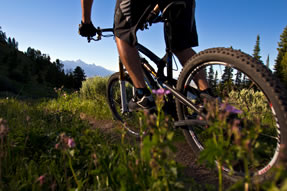
Another activity that is appropriate for everyone, is biking in Jackson Hole. From Mountain Biking at Jackson Hole Mountain Resort to biking on the valley’s great pathways, the options are endless. The resort offers bike rentals in Teton Village and chair lift access for you and your bike. It’s all downhill here! The trails are super smooth and very well designed. Great trails for all abilities. $89 bucks gets you a bike rental and lift access.
If you would like a guide to take you on some of the great Mtn. Bike Trails in the Valley look into Teton Mtn. Bike Tours. David Hunger is the bike aficionado and would be happy to pair you with the appropriate ride. He is located on North Cache St. and offers rentals too. Mention EcoTour Adventures for 10% off your bike tour.
Road Biking
Don’t forget our world-class pathway system in Grand Teton National Park! Stop at Dornans, in Moose, Wy, right in Grand Teton Park to rent your Road Bike. Make a day out of it, biking the 13miles to Jenny Lake then take the boat ride across the beautiful glacial lake. Now this is what we consider a muti sport day! Take a swim in the lake for the trifecta! The ride to Jenny Lake is slightly uphill and be sure to check the weather forecast before you head out.
Alpine Slide
Your kids will totally love this roller coaster type mountain adrenalin rush. The Alpine Slide winds down Snow King Mountain through 2,500 feet of wildflowers and beautiful pine forests. You take the chairlift up and ride down controlling your own speed. No special skills needed!
Winter Activities in Grand Teton National Park and Jackson Hole
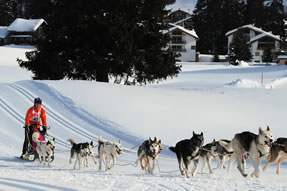
Dogsledding
The Iditarod might be one of the hardest races out there, but a half or full-day of mushing with Continental Divide Dog Sled Adventures is anything but. There are half and full-day tours as well as overnights, where you can stay in backcountry yurt kept warm by a wood-burning stove. Half-day tours can include a lunch or spa treatment at Brooks Lake Lodge, a historic and luxurious lodge only accessible in the winter by skis, snowshoes, snowmobiles, or dogsled. Iditarod veteran (he never won the race, but he did win the Best Cared for Team award and also the Sportsmanship Award) Billy Snodgrass founded Continental Divide Sled Dog Adventures many moons ago.
Jackson Hole Mountain Resort: Tram Rides
Yes, JHMR was recently voted the #1 ski resort on the continent. You don’t have to be a skier to enjoy some of our favorite activities there though. You can ride the resort’s 100-passenger aerial tram ($29 adults/$15 kids) to the 10,450-foot summit of Rendezvous Mountain and soak up some of the most stunning views of the valley. On clear days, you can see six mountain ranges. Also, the view of the Sleeping Indian from the top of the tram is the best in the valley. Book on-line for a $5 discount per ticket.
We also love a ride up the tram for the hot waffles and hot chocolate served at Corbet’s Cabin until 2:00 daily: they do sweet and savory waffles. The former includes a Nutella one.
Warning: While you won’t be doing much besides soaking up the views up there, 10,450-feet is high. Even sitting and eating waffles, you might feel the altitude. Your best bet is to do this after you’ve been in the valley a few days. Also, it can be up to 20 degrees colder at the top of the tram than at the resort’s base. Dress accordingly.
JHMR also welcomes non-skiers on its gondola ($20 for a ticket and you get a $10 food coupon), which doesn’t have quite the expansive views that the top of the tram does, but it does have more dining options and also terrific views of the double black diamond run, Corbet’s Couloir. Couloir restaurant is fine dining and does a prix-fixe dinner. There is also a cafeteria-style restaurant with Rice Krispy treats the size of your face.
Tubing
At King Tubes on Snow King Mountain in downtown Jackson, a lift carries you and an inflated oversized inner tube 200-feet up to the top of a manicured snow track. Sit or lie down on the tube and push off. Seconds later, you’re at the bottom.
Tubers must be at least 42 inches tall. Open 2 - 7 p.m. weekdays and 11 a.m. - 7 p.m. on weekends late December to mid-March (conditions permitting).
Jackson Hole and Greater Yellowstone Visitor Center
Even dyed-in-the-wool locals learn something new at the Jackson Hole and Greater Yellowstone Visitor Center. The center on N. Cache St. is a one-stop shop for all the maps, information, brochures, and questions you could need or come up with. You can buy annual passes to Grand Teton National Park and Yellowstone here (but not weekly ones), permits to cut firewood and Christmas trees, and get hunting and fishing permits. There’s also a small gift shop and bookstore inside selling locally-themed items and titles. 532 N. Cache Ave.
Dinner Sleigh Ride
Enjoy time on a working Wyoming ranch—and hanging with real working cowboys—and a delicious dinner at the Mill Iron Ranch, tucked into Horse Creek Valley and surrounded by the Bridger-Teton National Forest. Before the dinner, you’ll get a sleigh ride through the snowy Wyoming landscape and past a herd of over 1,800 elk. Adjacent to the Mill Iron Ranch is the second largest state-run elk feed ground. The elk spend their winters next to the Mill Iron and then migrate into the nearby national forest in the spring.
After the sleigh ride—and plenty of tall tales from your driver—you’ll be welcomed into the Mill Iron’s cozy lodge for the valley’s best T-bone steak dinner. If steak isn’t your style, you can ask (in advance) for chicken or fish. All guides are Wheeldon family members. The Wheeldons founded the Mill Iron in 1921. It’s now the fourth generation of the family that’s running things. Tell Kim we say, “Hi!”
Teton County Recreation Center
With a pool, indoor basketball court, steam room, sauna, showers, hot tub, and kids’ pool, the Teton County Rec Center is popular with locals and visitors year-round. We love the waterslide too!
Jackson Hole Moose Hockey
The Jackson Hole Moose play indoors at Snow King Sports and Events Center. This adult men’s Senior A hockey team faces teams from Sun Valley, Park City, and New York many weekend nights –think fast, and full-check skating by former Division I collegiate players and ex-semi-pros. When the Moose aren’t playing—or practicing—there are open ice sessions. Moose games go through March.
Nordic Skiing
Former Olympians Hans and Nancy Johnstone opened Turpin Meadows Ranch in the winter of 2013. At the end of Buffalo Fork Road in the northern part of Jackson Hole, Turpin Meadows has some of the valley’s best Nordic skiing, which isn’t surprising since the Johnstones were both Nordic racers. It has 15km of groomed track with terrain for beginners through advanced cross-country skiers. The ranch also has rental gear. You can really treat yourself and stay in one of the ranch’s cozy cabins for the night, or you can come up and ski for the day. Trails are open 9am – 5pm Tuesday – Sunday. They’re closed on Monday. $10-$5 to use their track and $30-$15 for ski rentals.
turpinmeadowranch.com/teton-adventures/white-season/ 307-543-2000 Closer to the town of Jackson, Trail Creek Ranch at the base of Teton Pass near Wilson is another exceptional location to Nordic ski. Day passes are $10 and trails are open during daylight hours.
Snowshoeing
From mid-December through March, Grand Teton National Park rangers lead free two-hour snowshoe tours. Tours are three times a week: Tuesday, Friday, and Saturday. They are limited to 20 people and depart from the Taggart Lake parking lot at 1:30 p.m. These snowshoe hikes, which cover between one and two miles and include discussions about winter ecology, wildlife, and the park’s geology, are appropriate for all levels, including first-timers. The park even has snowshoes for you, albeit not high-tech ones. To create the feeling of a historic experience, most of the park’s snowshoes date from the 1940s and 1950s and are four-feet-tall, racquet-shaped, and made from wood and rawhide. Some of these snowshoes made it into the park’s collection via the famous U.S. Army 10th Mountain Division, a light infantry division activated during WWII to give troops special training in mountain skills such as skiing and snowshoeing. Reservations needed; $5 for rental snowshoes;
If you want to go solo, Grand Teton National Park’s interior park loop road is a perfect place to snowshoe on your own. Park at the Bradley-Taggart Trailhead. The road is closed in the winter for vehicles and groomed for snowshoeing and cross-country skiing, making it a perfect place for novice snowshoers. The trail is packed, the scenery is stunning—views of the Tetons the whole way—and you’ll see plenty of other people. And, because it’s out-and-back, you can turn around at any point you get tired. The road usually remains snow-covered until mid-March.
More adventurous snowshoers can park at the Bradley-Taggart Trailhead and head for one of two nearby glacially formed lakes. Taggart Lake is the more southerly of the two and is a shorter hike, about three-miles round-trip, from the trailhead. Bradley Lake, which sits near the mouth of Garnet Canyon, is about four-miles round-trip from the trailhead parking lot. The trails to both lakes are gently undulating, and the Bradley Lake trail has several steeper sections. You won’t have either of these trails entirely to yourself, but you will see far fewer people than you would in the summer.
East of Wilson, the Snake River Dike is a favorite with dog-owning snowshoers –and walkers; snowshoes are often not needed. Benefits include a partially frozen Snake River for scenery and no chance of getting lost on this obvious trail.
A note about snowshoeing etiquette: Whenever you’re snowshoeing, it is bad form to snowshoe in ski tracks. Snowshoeing—and also walking without snowshoes—in ski tracks makes it both difficult and dangerous for cross-country and backcountry skiers to use them. If there is a ski track but no snowshoe track heading to where you want to go with your snowshoes, set the snowshoe track yourself. Or snowshoe somewhere else.
Teton Mountaineering rents snowshoes: $25-$18; 170 N. Cache; 307-733-3595
National Elk Refuge Sleigh Ride
Sleighs pulled by 2,000-pound Belgian and Percheron draft horses can get much closer to the thousands of elk wintering on the National Elk Refuge immediately north of the town of Jackson than you ever could on foot. Wrapped in a blanket on a sleigh, you’re literally surrounded. Don’t focus on the elk so much you miss the other wildlife. Even though it’s the National Elk Refuge, the 25,000-some acre preserve is also home to eagles, coyotes, foxes, badgers, bison, deer, wolves, trumpeter swans, ducks, and geese. The sleigh ride drivers are wonderfully knowledgeable about the refuge, but, to get the most out of the experience, we recommend doing it after you’ve done a wildlife EcoTour with us; you’ll then have a better understanding of what animals you’re seeing.
Sleigh rides depart daily every 20 minutes or so from the Greater Yellowstone Visitor Center from mid-December through mid-March. 307-733-0277
Yellowstone in Winter
Nothing beats seeing Old Faithful erupt on a clear bluebird day in January. The bison are hovering around the geothermal basin, the air is crisp, and you are avoiding the summer crowds. Did you know that up to 20,000 people a day might watch Old Faithful erupt on a busy summer day?
There are companies that guide day tours to the Old Faithful area in the wintertime. We don’t typically recommend this trip because of the length of the day and the amount of time that one is on a snowmobile.
Consider hiring Xanterra to take you up to the Snowlodge, at the Old Faithful Complex, for the night or even two. You will have a fun ride up in a snowcoach, (an enclosed tracked vehicle) and then have the time to fully explore the Upper Geyser Basin – snowshoes and cross-country skiing gear can be rented at the Bear Den Ski Shop at the lodge.
Ski Rental
Who wants to stand in line at the resort getting rental skis. Give Door 2 Door Ski Rental a call. These gear aficionados will come to your private home, condo or hotel room and fit you with top of the line skis and boots for your day skiing power in Jackson Hole. Don’t waste time, give these guys a call pronto! (307) 733-4077
Wildlife Safari Tour
Don't forget to maximize your time in Grand Teton Park and Jackson Hole viewing widllife with an expert naturalsit. Be sure to explore EcoTour Adventuers wildlife viewing progams. We think this is the best winter activity in Grand Teton National Park. Book your wildlife tour today!
Local Attractions
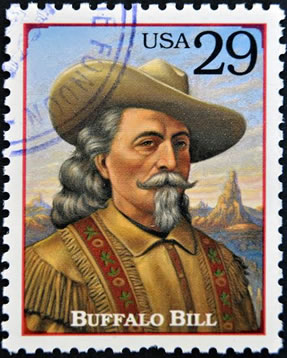
Buffalo Bill Museum
There are several great attractions around the Yellowstone region to check out if you have the time. If you are ever in Cody, WY make sure to check out the Buffalo Bill Museum. The Buffalo Bill Museum’s focuses on the life and time of William F. “Buffalo Bill” Cody (1846-1917), the noted guide, scout, frontiersman, showman, actor, entrepreneur, and American icon. In addition to documenting the life and interests of William F. Cody and the history and operations of Buffalo Bill’s Wild West, the museum’s collection interprets the history of the American cowboy, dude ranching, western conservation, frontier entrepreneurship, and the source of our concepts about the West. The museum is actually 4 museums under one roof. Spend a full day, hopefully a rainy one, exploring the firearms, natural history, Buffalo Bill Cody, and the art museum. 307-587-4771
Grizzly and Wolf Discovery Center
If you are interested in the predators of the Greater Yellowstone Ecosystem you must explore The Grizzly and Wolf Discovery Center (GWDC) in West Yellowstone. The Discovery Center is a not-for-profit facility dedicated to providing visitors to the Yellowstone area an opportunity to learn about, view, and ultimately appreciate the grizzly bear and gray wolf.
The grizzly bears that reside at the GWDC are animals unable to live in the wild for different reasons. Many were orphaned in the wild and rescued from certain death. Others had become nuisance bears and were destined for destruction. These animals have a second chance at the Center and, by helping with the education of visitors, their lives may help other bears remain in the wild.
The wolves at GWDC were all captive-born. The GWDC agreed to take pups from different litters, and have since formed two wolf packs. Wolves possess a dynamic and strong family structure that can be observed as these animals interact through their day. Watch for body posturing, ear and tail position, and each animal’s location in the habitat. 406- 646 - 7001
Beartooth Highway
Heralded as one of the most scenic drives in the United States, the Beartooth Highway, a National Scenic Byways All-American Road, features breathtaking views of the Absaroka and Beartooth Mountains, and open high alpine plateaus dotted with countless glacial lakes, forested valleys, waterfalls and wildlife.
Traveling the highway, you have the rare opportunity to experience and explore pristine, untouched alpine and montane landscapes, lush forests, and alpine tundra in the space of a few miles. It is one of the highest and most rugged areas in the lower 48 states, with 20 peaks reaching over 12,000 feet in elevation. In the surrounding mountains, glaciers are found on the north flank of nearly every mountain peak over 11,500 feet high. The road itself is the highest elevation highway in Wyoming and the Northern Rockies at 10,947 feet.
Accommodations

Hotels, Cabins & More
So many options! Where to start? The first question to ask yourself is: The Town of Jackson or Teton Village? When staying in town you have free access to the START Bus Town Shuttle, running every half hour, to move you around town. Grand Teton National Park is just 5 miles north of Town. For the folks that prefer Teton Village you have the convenience of waking up slope side, which is great for winter skiers or for families that want a bit of a quieter experience than town. In Teton Village there are activities right out of your front door like mountain biking, hiking, tram rides, and, for the more adventurous type, paragliding.
A good place to start would be with the folks at Outpost Jackson Hole. They manage quite a few properties in the Greater Jackson and Teton Village area. If you are looking for that one bedroom condo or a well equipped home in the woods for your family reunion, these folks might have the spot for you. These folks know this area well and are always happy to share their insider’s knowledge. 307-690-4790
Town Of Jackson
A really great choice would be the sustainably run Alpine House. This location is walking distance to the Town Square, but off of the main drag. They provide a great cooked breakfast that many past guests rave about! Hot drinks and pastries are available all day. Nothing is better than spending a day in the mountains and coming home to their wet sauna to recharge in their European Styled quaint lodge. Two long-time locals, who are both past Olympians, run this fine establishment! If you get a chance, ask Hans about some of his incredible mountaineering feats! Mention you are an EcoTour Adventures guest for 10% off. 800-753-1421;
Another locally owned property is the Parkway Inn if you are looking for a clean, comfortable, and very “Homey” feeling inn to rest your head. This location is about two blocks from the Jackson Town Square. Jacquie and her staff have a reputation for providing the BEST customer service to all of their guests. This is another small property so you are assured not to get lost in the shuffle! Mention EcoTour Adventures for 10% off your stay! 800-247-8390
Teton Village
The “Village” is home to many larger high-end properties. Consider the Teton Mountain Lodge. This is a 5-star lodge that has an in house spa, restaurant, bar, and fitness and business center. Most of the rooms are equipped with gas fireplaces for great ambiance and to take the “chill” out of our brisk mountain mornings. Studios and suites provide options for everyone. When you are booking for this summer, be sure to ask for their 15% room discount and the $50 dollar-per-night stay-credit at their new Spur Restaurant and Bar. 855-318-6669
Another great option in the Village is a condo or home to fit your needs from Jackson Hole Resort Lodging. If you are looking for anything from a one bedroom basic condo to a multimillion 5-bedroom home, keep these folks in mind. Booking with them provides you with a free concierge service; 24hr on call service, an on-site office, and 20% discounts on all lift tickets (summer or winter) to Jackson Hole Mountain Resort. 3 night minimum 800-443-8613
So you have hiked to Jackson on the Continental Divide Trail (a 3,100 mile foot path from Mexico to Canada) or just on a tight budget and need a spot to rest your tired body… Look at The Hostel in Teton Village. These folks provide private rooms or shared bunkrooms. 307-733-3415
Bridger Teton National Forest
Look no further than Flat Creek Ranch for an ultimate guest ranch experience. Spend the week or a few days, 15 miles up a jeep track deep in the National Forest. You will enjoy the company of Trey (a Jackson Native) and Shelby Sharp as your hosts. This is a smaller ranch, max 14 guests, so expect personalized services with great food and drinks. Once at the ranch, everything is included. Go horseback riding, hiking, fishing, canoeing, or bathe in their streamside sauna! 307-733-0603
Babysitting and Gear Rentals
So you didn’t want to fly with your car seat, crib, or nanny!? Look up Jackson Hole Babysitting for all your baby or child needs. They offer gear rentals and arrange the perfect sitter for your child while you are at dinner or off in the mountains. Tell Amanda we said ‘hi’! 307-413-3038 or www.jacksonholebabysitting.com
Restaurants

For the foodie in you, I have complied a list of some of our favorite restaurants. From high end to budget experiences, there is something for everyone. It’s amazing for our little Wyoming Valley how many options we have.
Breakfast:
Breakfast Wilson Option: This very well might be my favorite meal of the day. Hands down you have to check out Nora’s Fish Creek Inn. This lovely spot is on HWY 22 at the bottom of Teton Pass. It’s just 6 miles from Jackson. My favorite dish is their Huevos Rancheros with the sausage addition! Their Banana Bread French Toast and Breakfast Burrito are also on the top of my list. Ever thought of a breakfast appetizer? Their Sweet Roll is quite decadent! If, “It’s 12:Noon Somewhere”, is your motto, check out their signature Bloody Mary! 307-733-8288 No reservations for breakfast needed.
Jackson Option: For a great greasy spoon and a local favorite, check out Bubba’s! They provide quick service to get you outside and into the mountains ASAP! An insider’s note is to ask about the Workers Special, Mon-Fri (you didn’t hear it from us as it is not on the menu). $6.00 for a solid breakfast that will last you well into the afternoon. They also provide an affordable dinner BBQ option. http://www.bubbasjh.com 307-733-2288 No reservations needed, some weekend mornings there can be a little wait, but it’s worth it.
Jackson Option: For you Nor’Easters out there Café Genevieve serves Pure Vermont Maple Syrup. The warm ambiance is perfect for a slow morning, as the restaurant has been incorporated into a historic log cabin. Look for the Spanish Frittata or Cajun Benedict on their “Inspired Home Cooked” menu. You might just have to come back to try their house made Chorizo. Enjoy! 307-732-1910 No reservations needed
Lunch:
Wilson Option: For a quick bagel sandwich “to go” find Pearl Street Bagel. This fine local chain, their other location is in town, boasts healthy and quick options if you are in a rush to get into the mountains. They have a fine selection of deli meats, cheeses, veggies and salads for you to choose from to “Make Your Own”; It’s a tough choice, but I think my favorite just might be their Smoked Salmon, Wild Caught of course, lunch bagel. For an extra warm-up in the winter, they have a tasty soup that changes daily. 307-739-1261
Jackson Option: Most locals would point you to the Snake River Brew Pub for some great food in what is called Jackson’s “living room”. You just might find some of the same faces pulled up at the bar day after day, conversing with the Brew Master about the next Bev’ to be released. Aside from the great beer, it’s not happy hour yet! Check out the $8 lunch menu for everyone’s favorite, the flavorful Pulled Pork Tacos. They have specialty pizza pies that are top notch and the Cobb Salad is perfect if you are mindful about what you eat. If you are looking to try some, good’ol local Wyoming meat, look no farther than the beef or tasty bison burger. I would recommend eating outside during the summer. Their fireplace tables might be a better fit during our long and snowy winters. 307-739-2337
Moose, WY Option: Yes it is true that in Moose, WY, while you are seated at Dornan’s Pizza and Pasta Co. you might get a glimpse of a moose browsing outside of their fine establishment. It is quite possibly the restaurant in Jackson Hole with the best view, with the Tetons and Snake River to the West! There is seating outside on top of the building or inside next to the oversized windows looking towards the Tetons. For a bit of true Wyoming History you have to check this place out. The Dornan family homesteaded in 1916 before Grand Teton National Park was established. The Dornan’s are still in the area and take an active role in managing the business. If you look closely I bet you can pick these friendly folks out to say ‘Hi’. Food wise, they are known for their pizzas, sandwiches, and salads. Enjoy! 307-733-2415
Dinner:
Jackson Option: Our favorite, The Blue Lion, is just one of those restaurants that will not go away. As restaurants come and go in Jackson, the “Lion” is true and tested and a favorite of the locals. Pay close attention as you drive: you might mistake for someone’s residence, as it is a converted home. In the summertime, be sure to be seated outside. There is frequently a guitarist strumming “Hotel California” or other tunes that will take you back in time. The music is nice, but folks come for Chef Tim Libassi’s excellent Rack of Lamb. Guaranteed, this is best rack you will ever have. It’s a full rack so come with your appetite. The Crab Stuffed Mushrooms, Grilled Elk Tenderloin, and the Port Balsamic Beef Tenderloin are all excellent choices. Start with their signature Shakedown Street cocktail and finish with their top of the line Russian Cream desert. Don’t be afraid to talk skiing with Ned the owner. He might just share some of his favorite ski lines with you. Tell Ned that EcoTour Adventures sent you, be seated before 6:00, and you might be lucky enough to get 20% off your entire bill. Reservations recommended. 307-733-3912
Jackson Option: Our choice for the best burger in town is the Cowboy Steakhouse. Positioned right on the town square and under the World Famous Cowboy Bar. The do have some of the best steaks in town, but ask for their Burger and a Beer special. $6 Bucks gets you a fine burger (that comes from steak trimmings) and a PBR beer. For $1 dollar more, you can upgrade your beer and get fries. This special is NOT on their menu and is only available from 5:30-7 on most days. Reservations not needed for the burger deal. 307-733-4790
Jackson Option: If you are looking for a very fine dining experience with fancy sauces to satisfy your distinguished pallet, look no further than the Snake River Grill. The Rare Ahi Tuna Au Poivre and the Wild Game Korean Hot Bowl are favorites. Take your friend’s credit card for this dining experience, as it is one of the more costly dining experiences in the valley, but well worth it. Side Note: EcoTour Adventures’ guides love gift certificates to this fine restaurant! 307-733-0557
Grocery Delivery Service
If going out is not your thing, and you would like to arrive at your comfy hotel room with the fridge and cabinets stocked, look into Mountains Of Groceries. This grocery delivery service will shop till they drop for whatever you would like. Ashley Watson and her faithful dog, Georgia, will make sure you are treated like royalty. (307) 699-4901
Getting Here

A wide range of options bring Jackson Hole closer to you than ever before, whether it’s a direct flight into the Jackson Hole Airport or the incredible scenic drive by car from nearby airports such as Salt Lake City or Idaho Falls.
Flying Options
Flying to Jackson Hole Wyoming: The quickest and easiest way to reach the area is to fly directly into Jackson Hole. The Jackson Hole Airport is located at the base of the spectacular Teton mountain range. Located entirely within Grand Teton National Park, flying into the Jackson Hole Airport is an awe inspiring start to your trip to Jackson Hole. The Jackson Hole Airport is serviced by American Airlines, Delta Airlines, Frontier Airlines, SkyWest Airlines and United Airlines seasonally. These airlines provide direct service to Denver, Salt Lake City, Dallas/Fort Worth, Minneapolis, Chicago, Atlanta, Newark, San Francisco, Houston, and Los Angeles.
Once you arrive in Jackson Hole there are a couple of options for transportation from the airport to the town of Jackson. The airport is just 15 minutes north of Jackson. Most hotels offer a shuttle back to town or you can take a taxi. If you like the convenience of having your own transportation you can rent a car, which is also great for exploring the area. We recommend the local company, Leisure Sports, which offers a range of SUVs and four-wheel drive vehicles which are great for exploring and getting off the beaten path in Bridger Teton National Forest and Grand Teton National Park.
Leisure Sports Car Rentals
Our mottto in Jackson is buy local! Check out Leisure Sports Car Rental. They were kind enough to offer EcoTour Adventures’ guests a 10% discount on all rentals with the exception of their vehicles during June, July, and August. They also offer paddle boards, rafts, driftboats, canoe and gopro rentals. 307-733-3040
Driving Options and Directions
If you choose to fly into nearby airports and drive, you just might save quite a bit of $$$ as flying in and out of Jackson can be pricey. Here are some of the more popular driving routes. Driving through Wyoming and the nearby states is an experience in itself! Remember to always be cautious of wildlife on the roads!
Salt Lake City, Utah
There are two different routes from Salt Lake City you can take to Jackson. One is more time saving and the other is more scenic. The fastest way is Via I-15 (5hr and 8min)
Salt Lake City, UT I-15 North to Idaho Falls, ID
Idaho Falls to Swan Valley, ID to Victor, ID and then Jackson
You will head over the beautiful Teton Pass, or if majestic views and high elevations aren’t your thing or weather does not permit, you can take an alternate route and go through Alpine, WY, which also has stunning canyon views.
We think the most scenic way into Jackson from Salt Lake City is by taking the back roads – this is our recommended route if the roads are snow free. (5hr and 39min)
Salt Lake City – Logan, UT via HWY 89 & 91
Logan to Bear Lake/Montpelier
Montpelier North on HWY 89 to Alpine, WY
Alpine, WY HWY 189 North to Jackson, WY
Idaho Falls: This is the closest airport to Jackson, other than the Jackson Hole Airport. 1hr 50min Take HWY 26 East towards Swan Valley, ID 31 over a small mountain pass into Victor then HWY 22 over Teton Pass into Jackson. In the winter do yourself a favor and drive the distance around the passes and through Alpine, WY.
Denver: This is a long haul but the scenery is stunning, if you like open Wyoming desert! (8hr 30min) There is the interstate route, slightly shorter, but not advised unless you like large trucks and lots of them! Winter weather can also close the interstate for good reason.
Denver North via I-25 to HWY 287. Take 287 into WY and jump on I-80 W for 80 miles, then back on HWY 287 all the way into Jackson Hole. From Moran, WY, head south through Grand Teton National Park to Jackson.
Bus Options
bus to jackson hole wyJackson Hole Alltrans runs Mountain States Express, which provides daily bus service between Jackson and Salt Lake City Airport, also serving Star Valley, WY, Idaho Falls, ID and Park City, UT. For schedule, fare information, and reservations visit their website at: http://www.mountainstatesexpress.com or call directly at 1-800-652-9510.
Spring in Grand Teton and Yellowstone National Park

Wildlife Viewing at its best!
Spring has sprung in the Tetons! Spring is a wonderful time to explore the parks and Jackson Hole. The wildlife is very active and the crowds are thin. As the snow recedes up the mountain slopes much of the wildlife takes advantage of the new grasses and vegetation available. Bears are emerging from hibernation and we are starting to see the first flowers in bloom.
Generally male bears (called boars) are the first ones out of hibernation. This past Friday, on a scouting mission, I snapped this photo of a large boar. Females with new cubs can emerge from hibernation as late as June.
Elk have been making their way north off of the National Elk Refuge. Most of the bulls have dropped their antlers at this point. It’s not uncommon to see younger bulls with antlers still attached this time of the year. Below, enjoy this picture of a young bull (approaching his 2nd birthday) after dropping one of his antlers.


